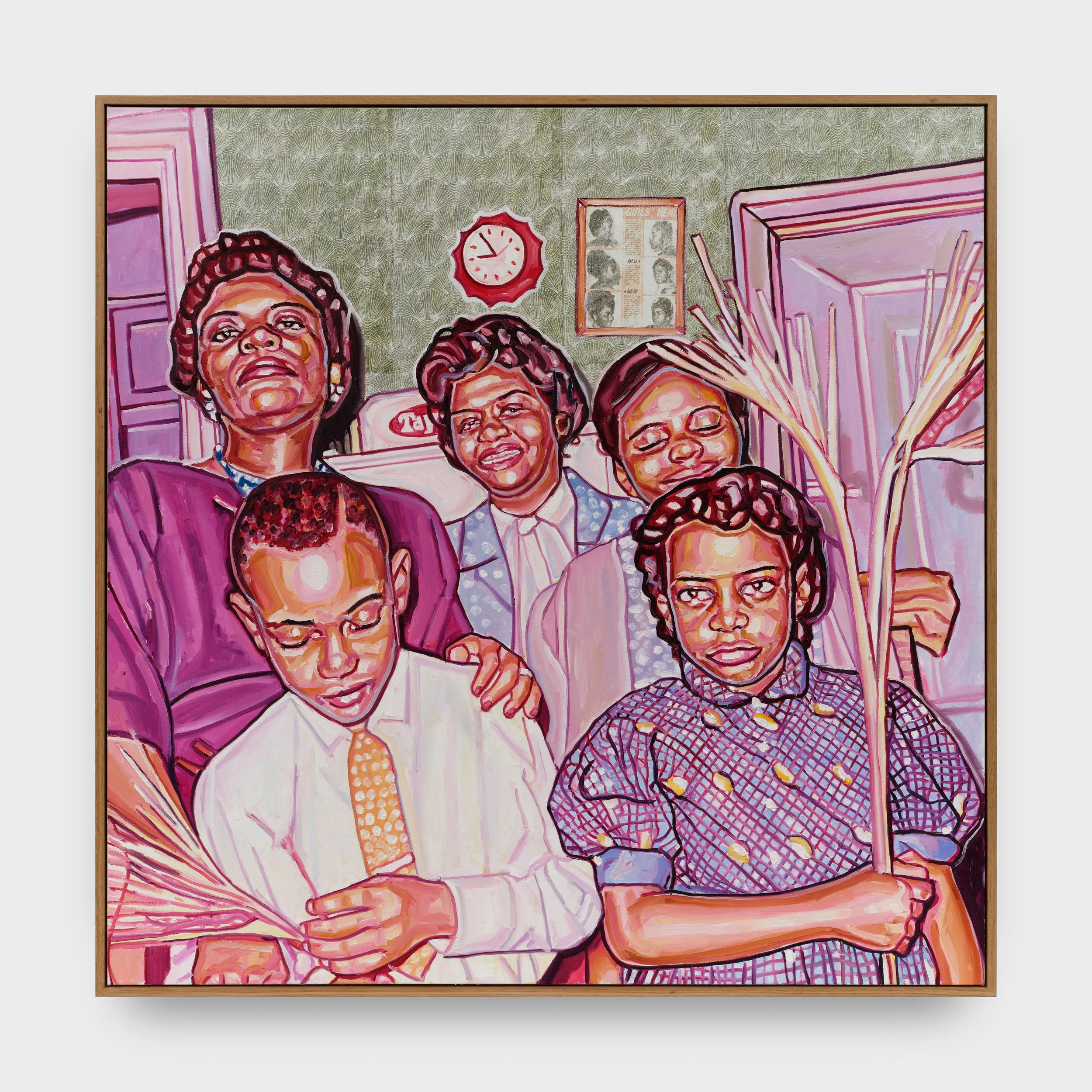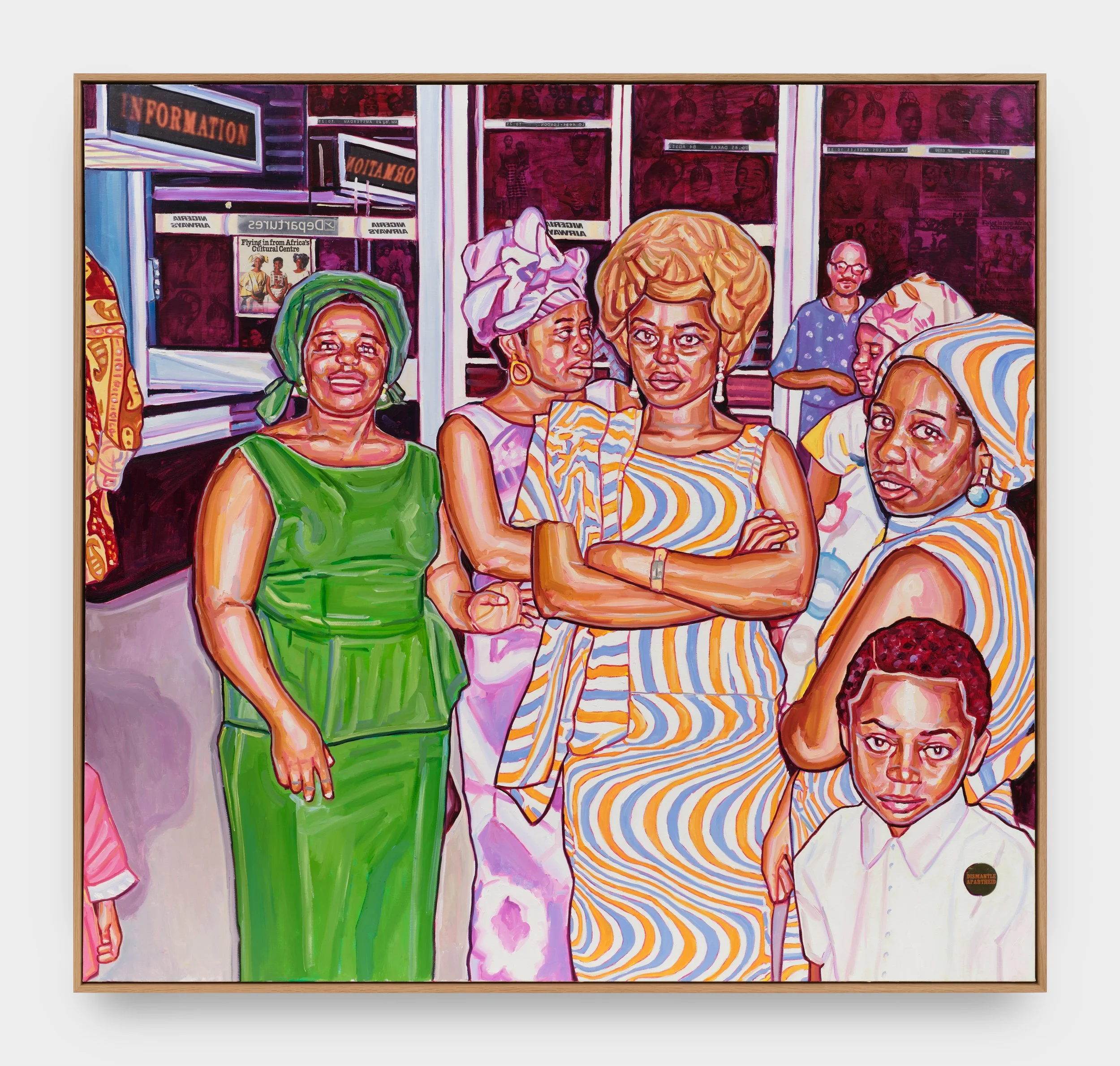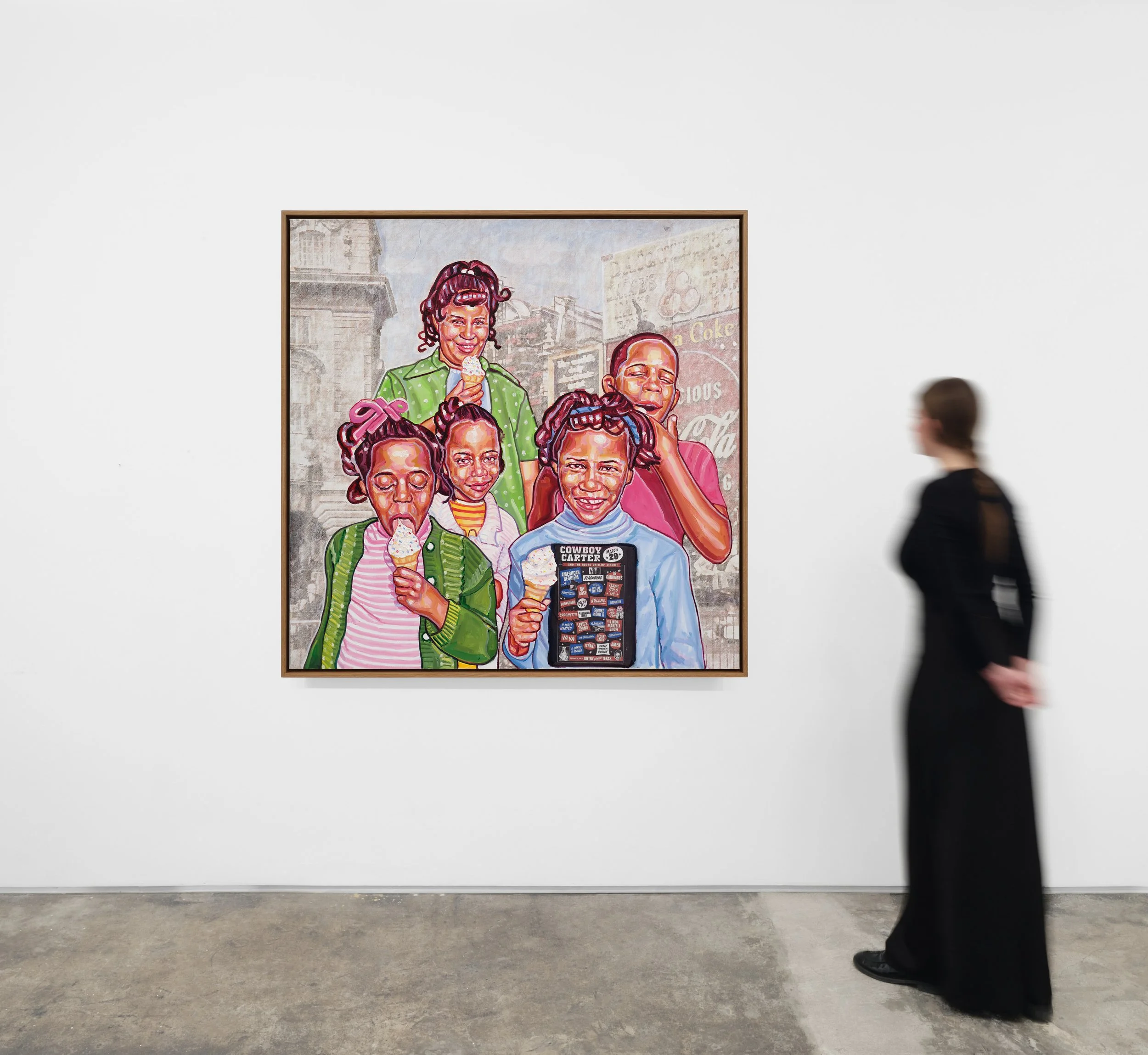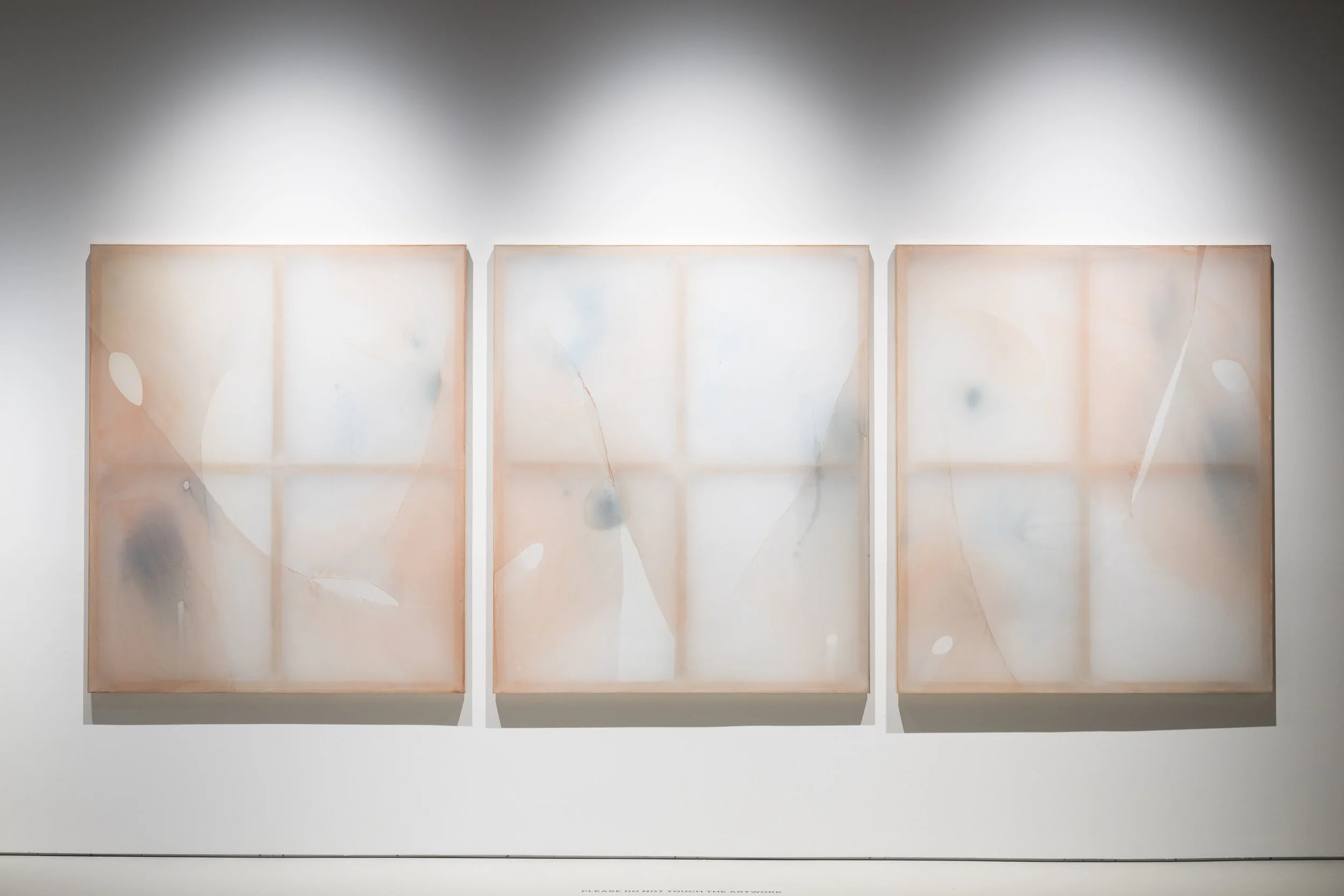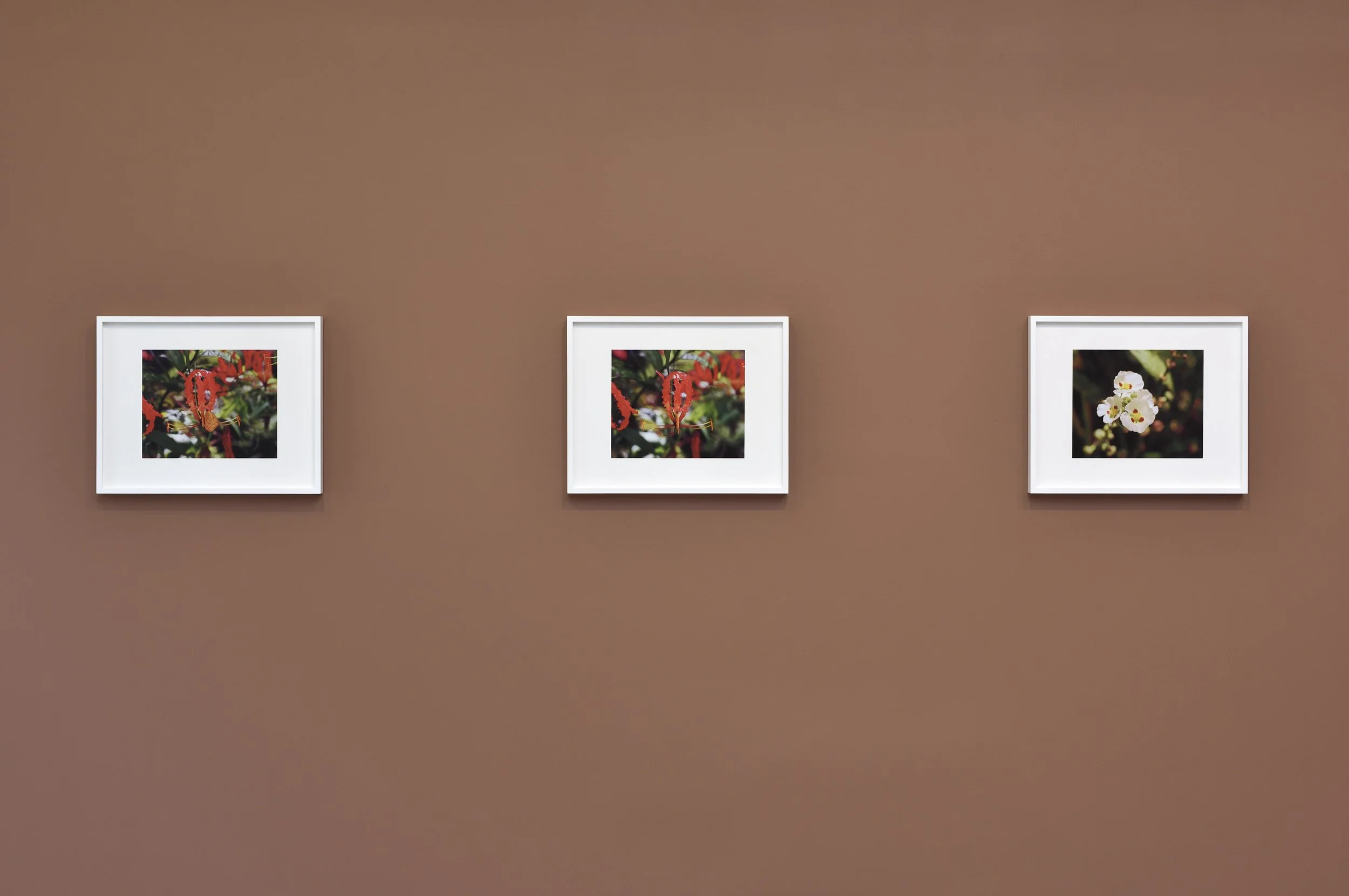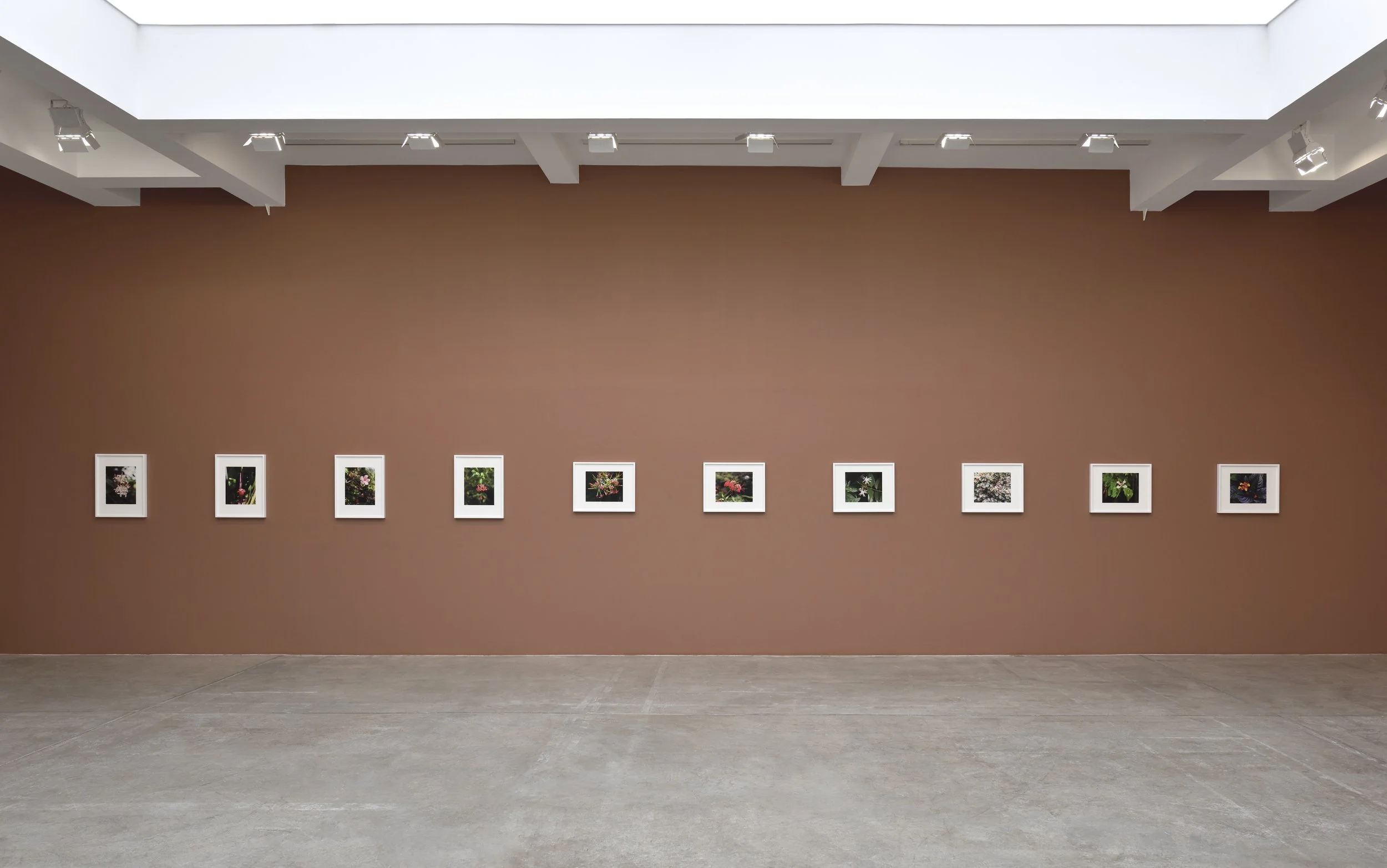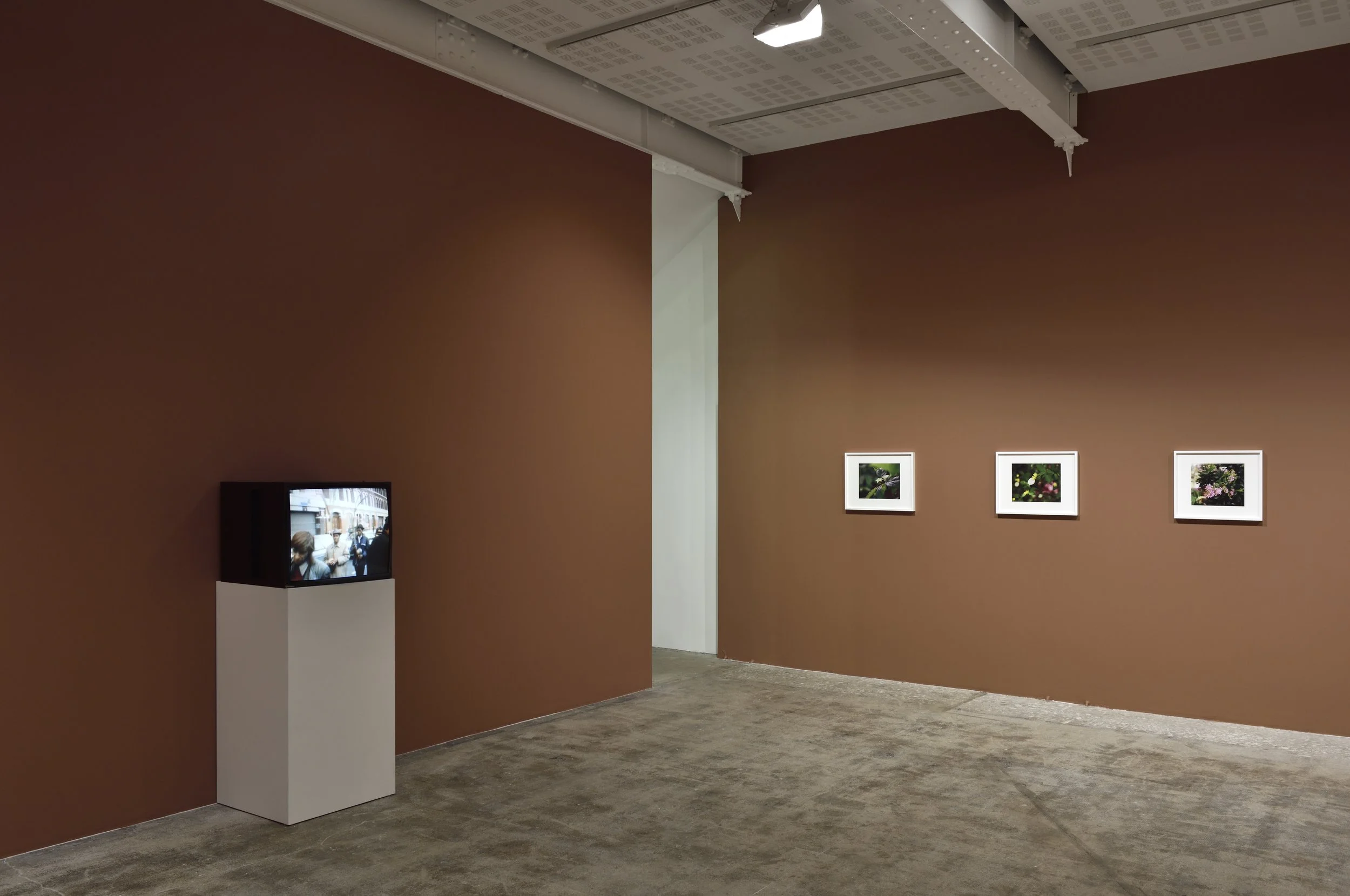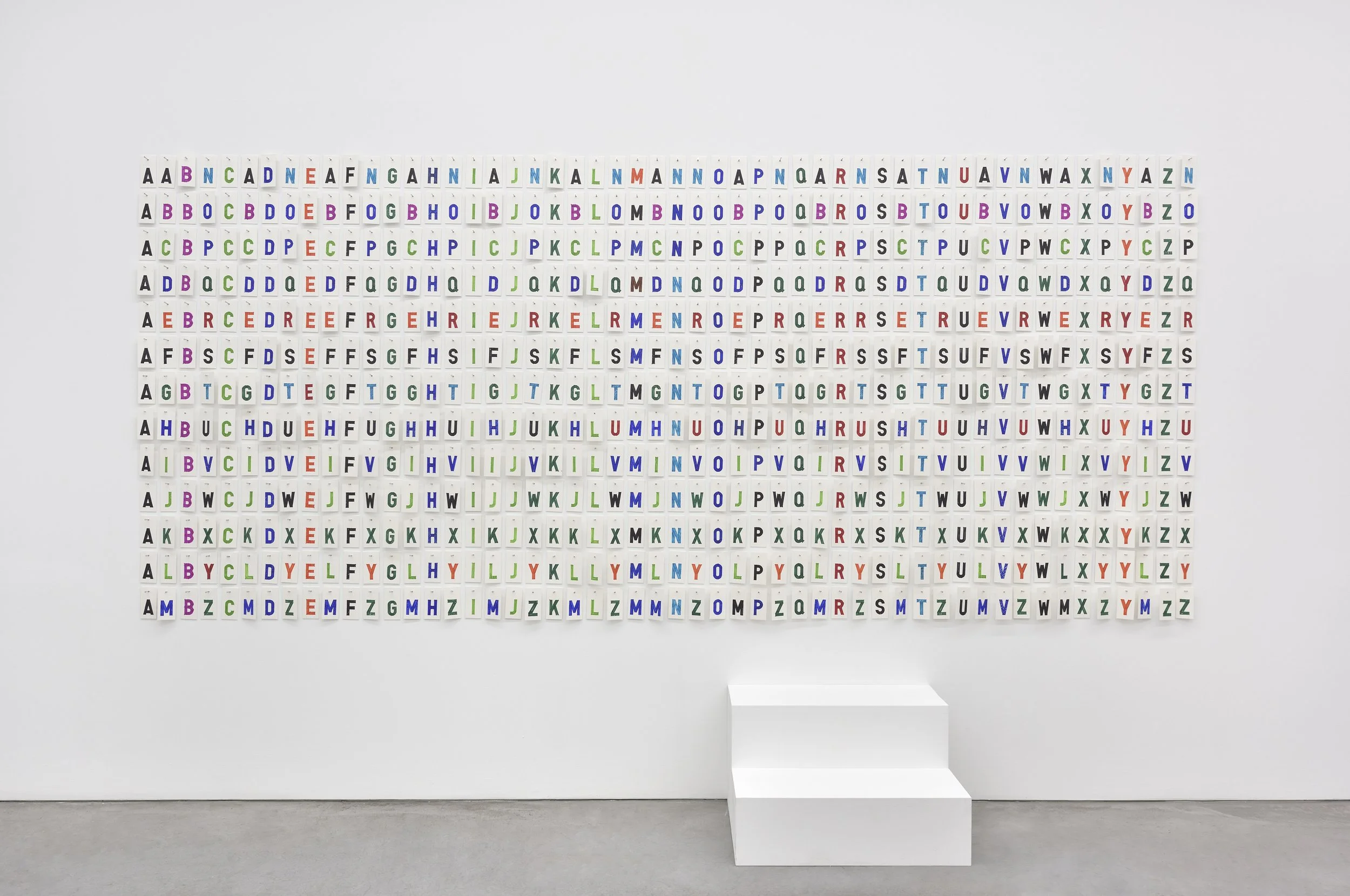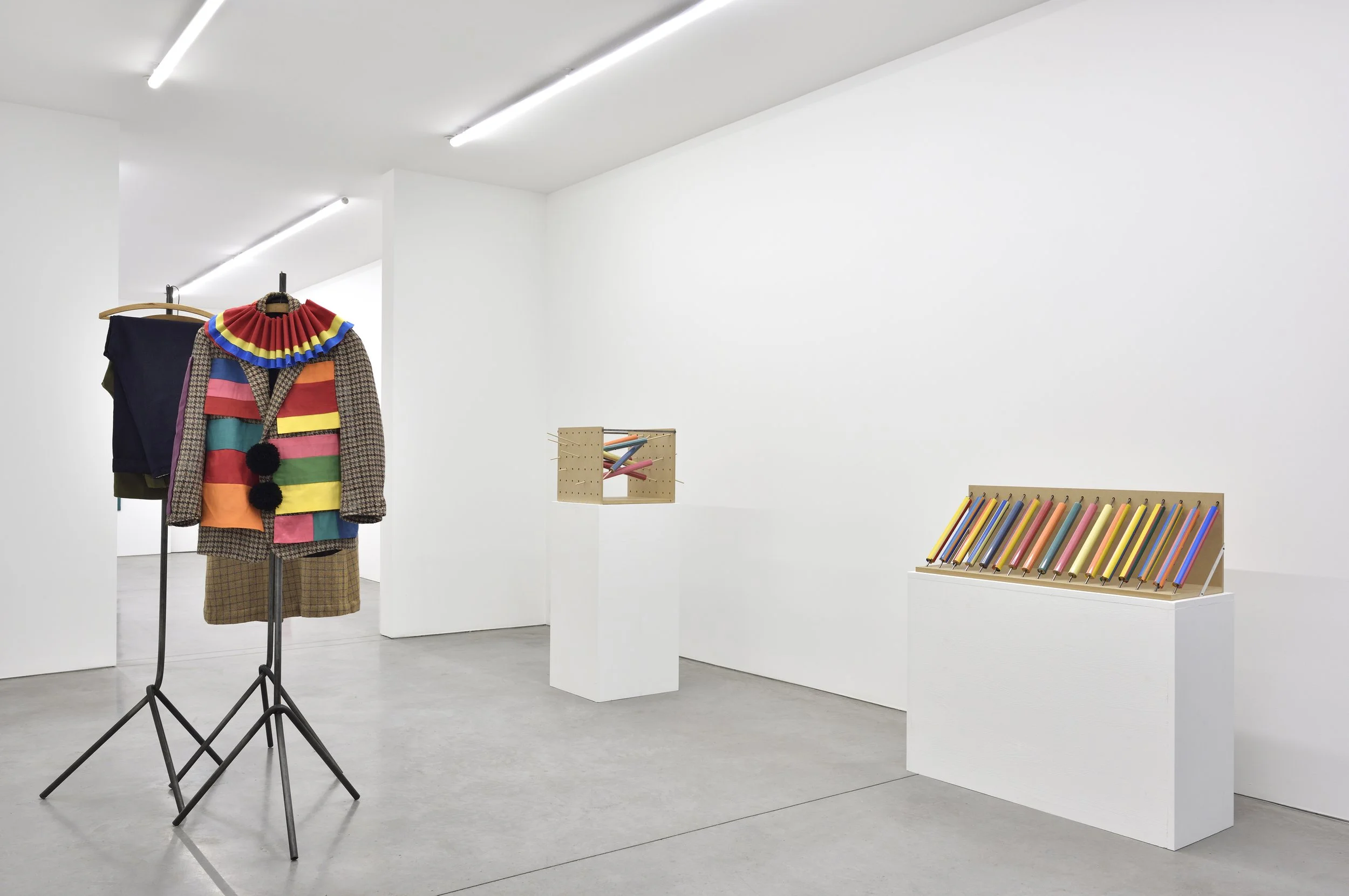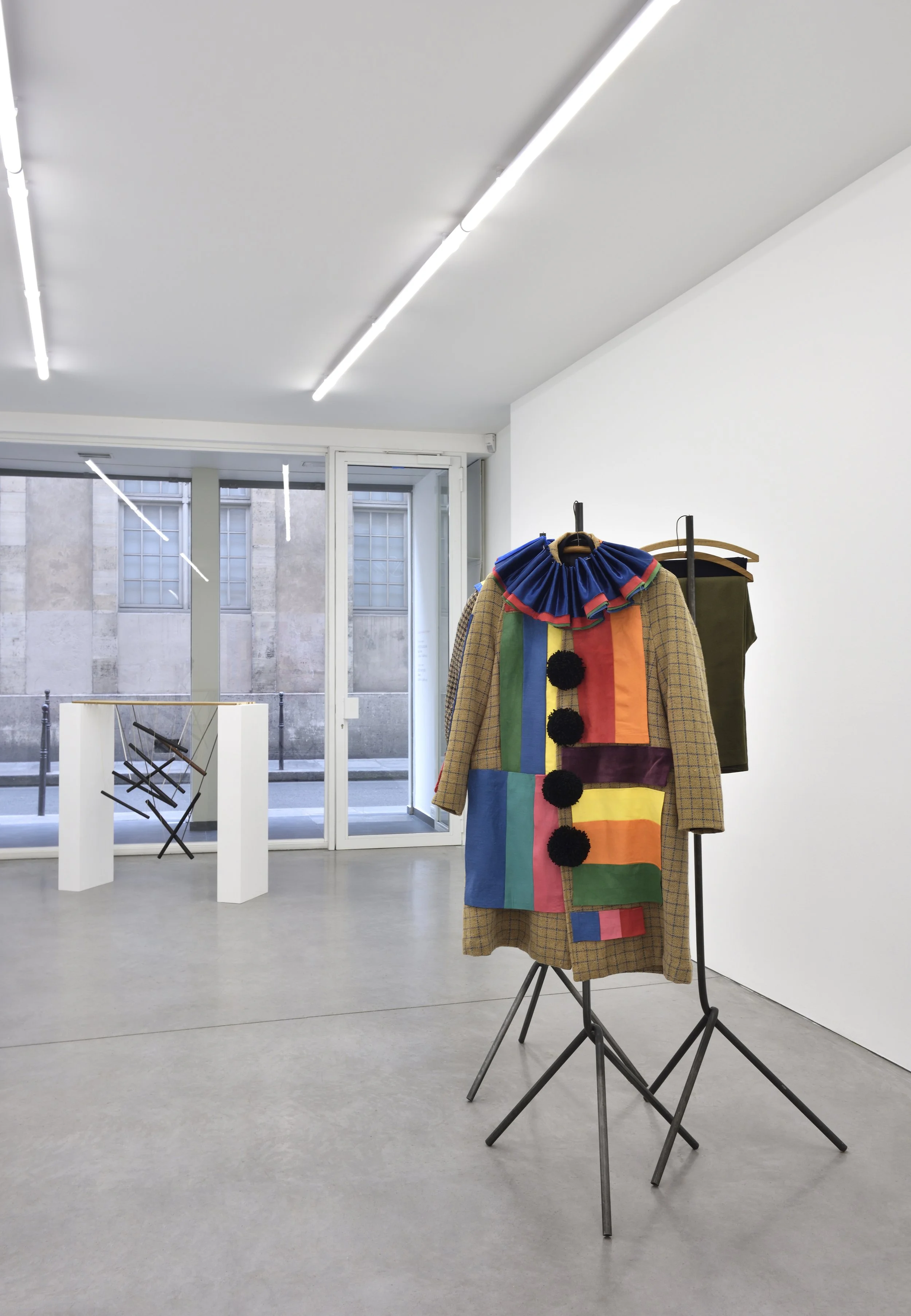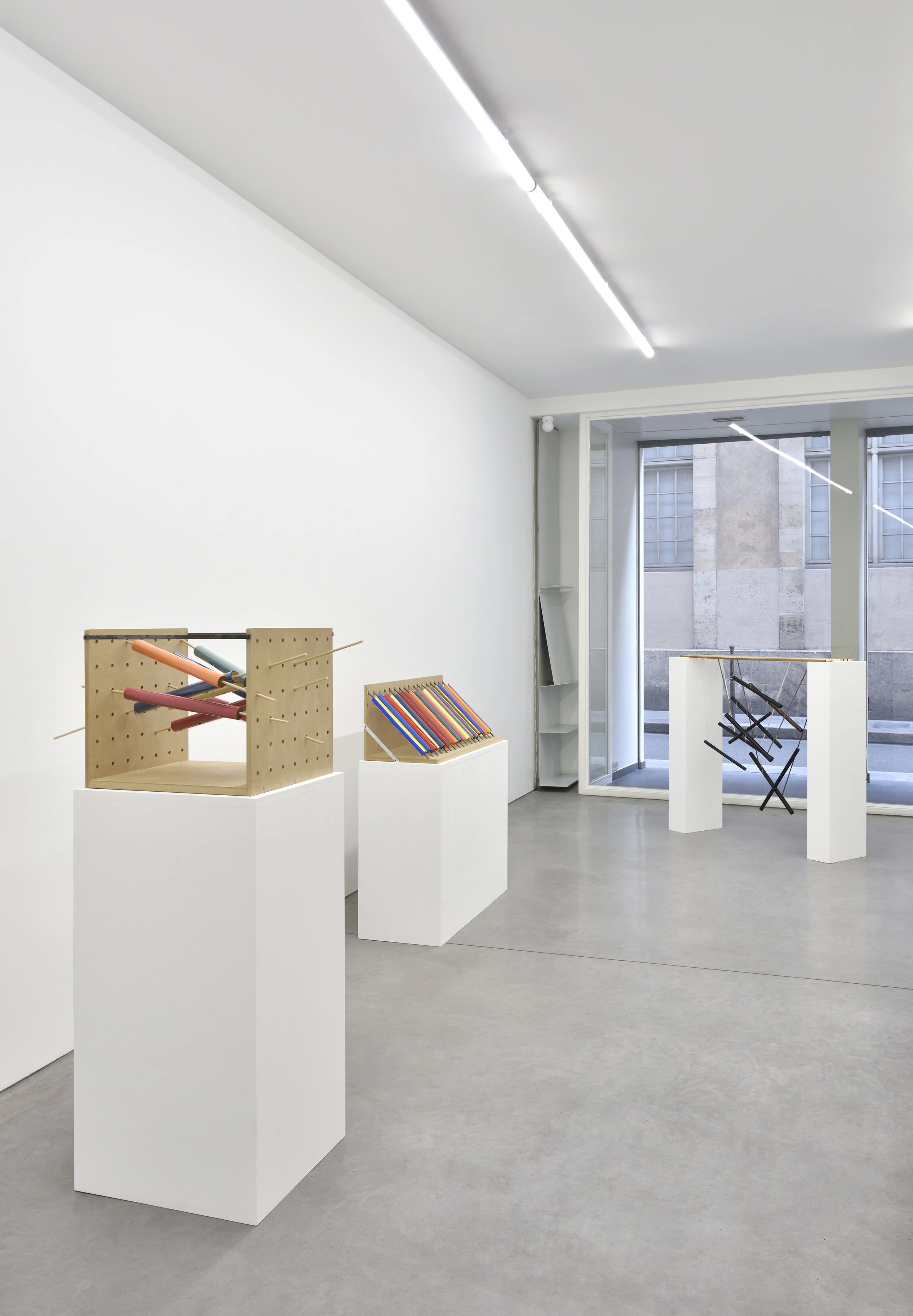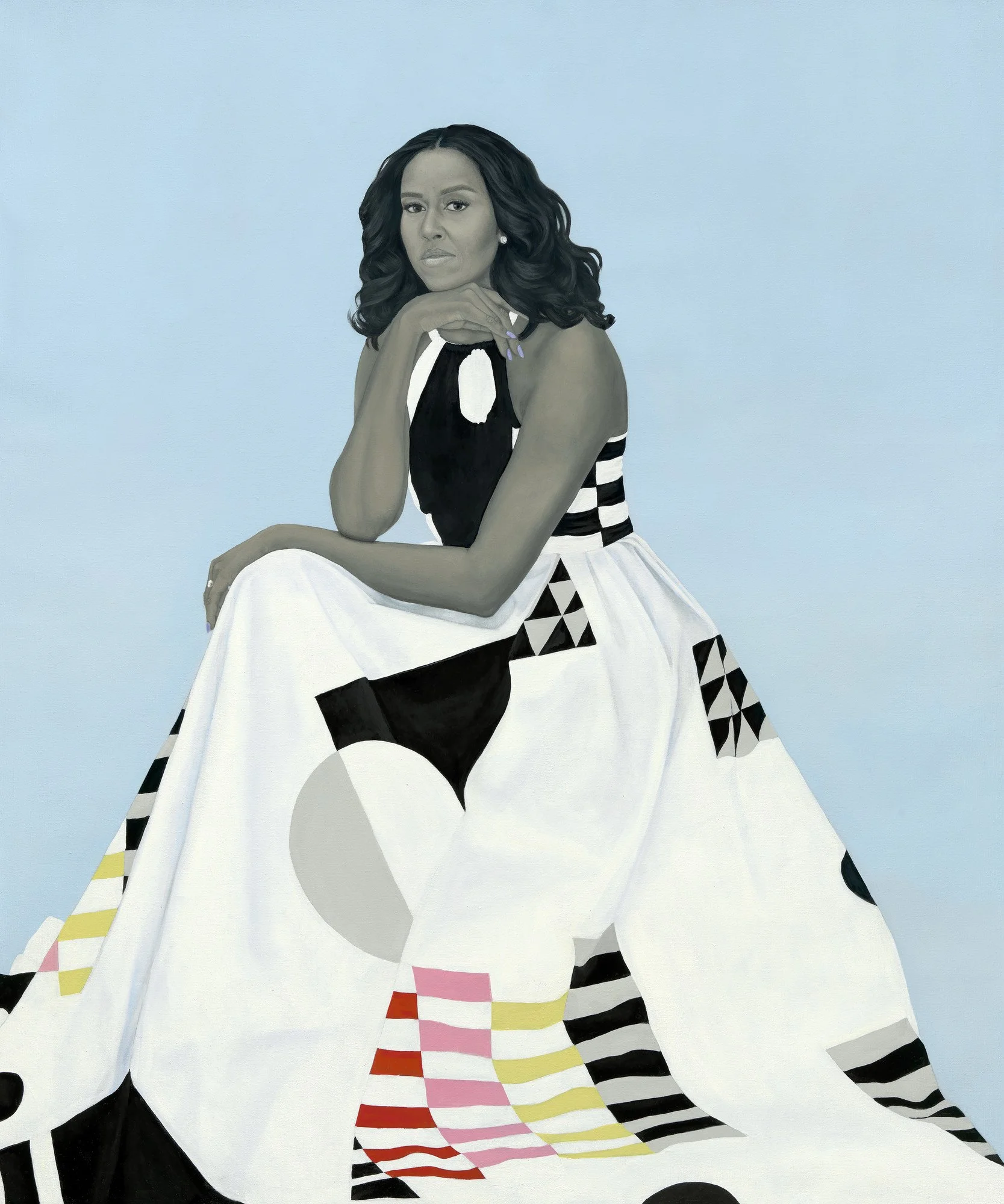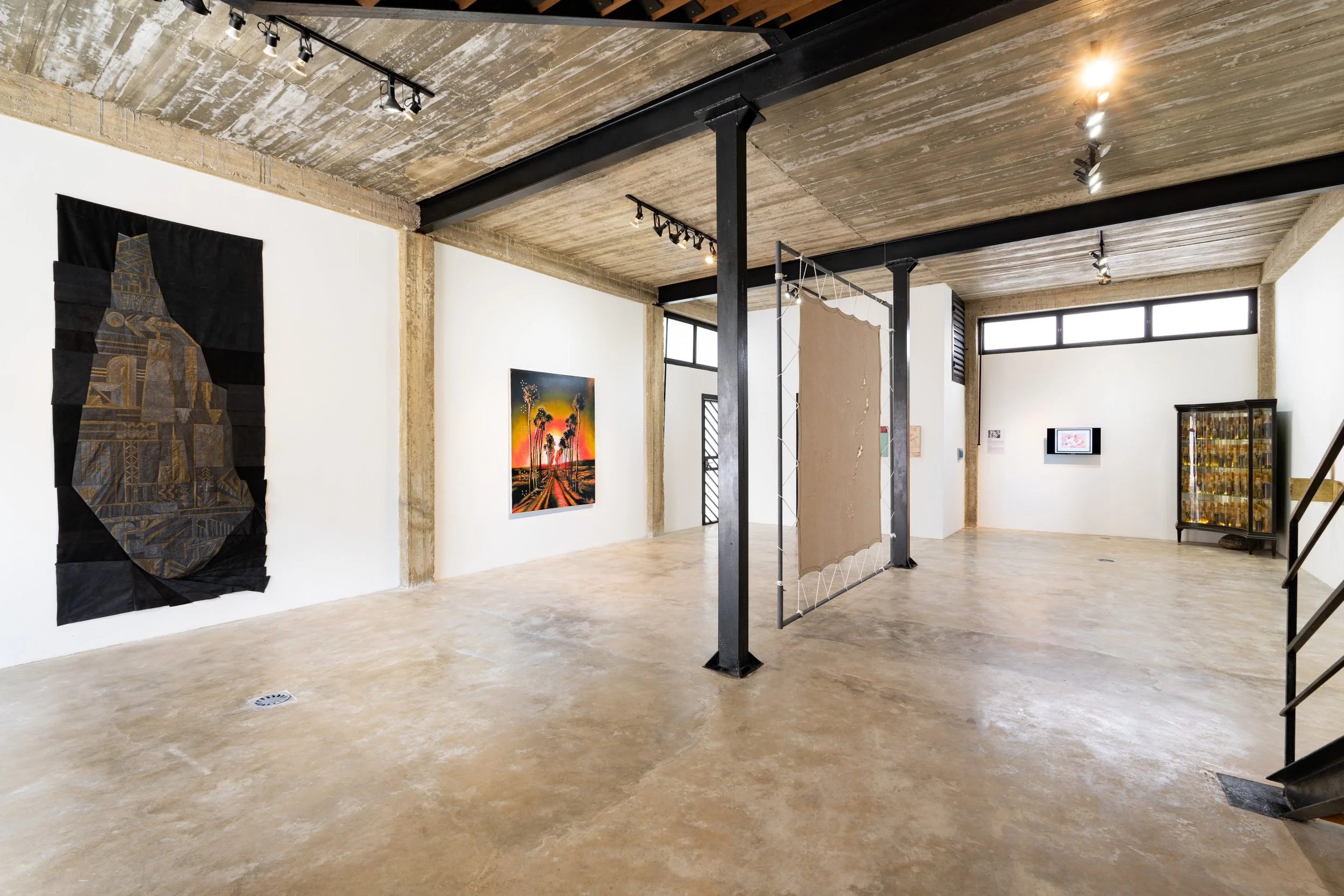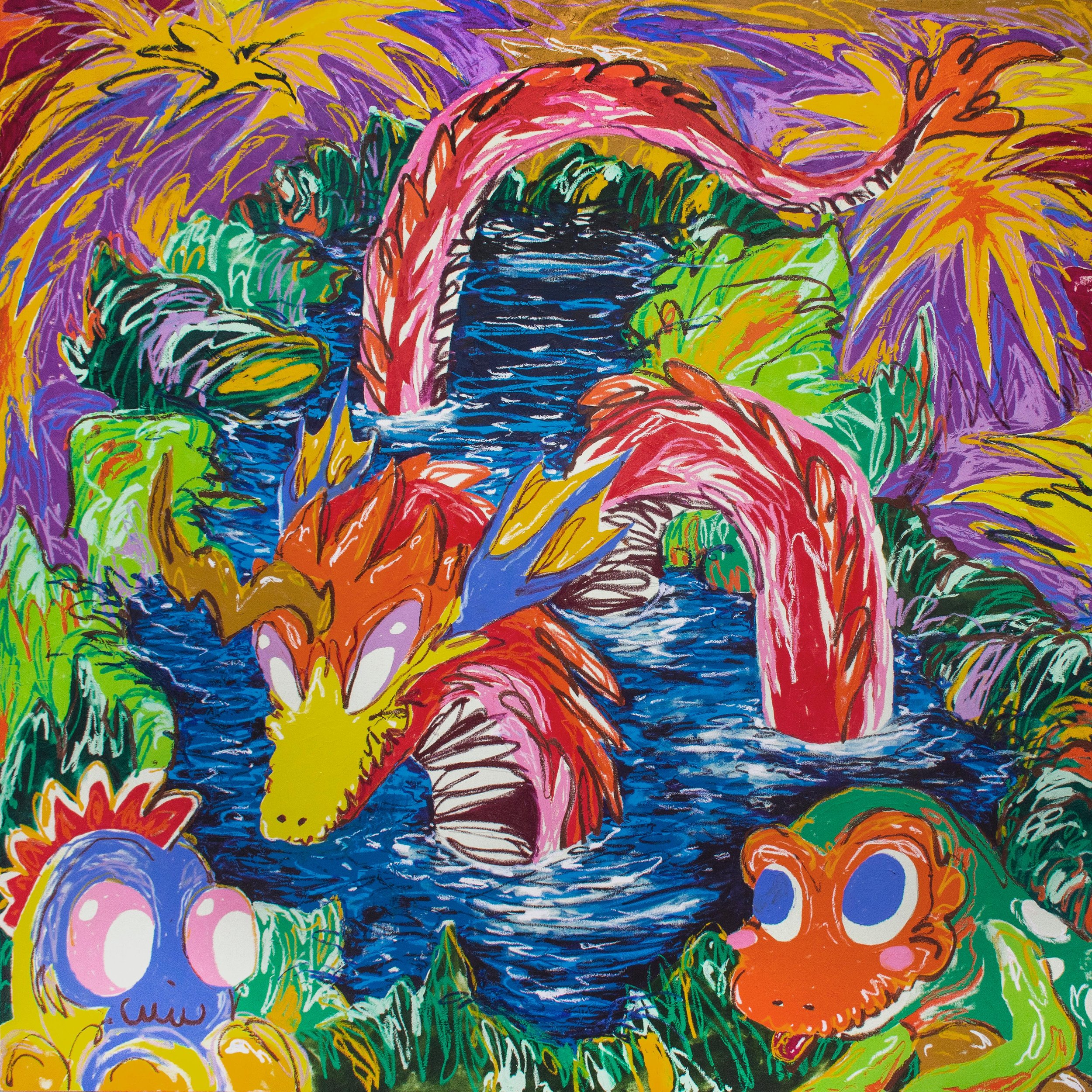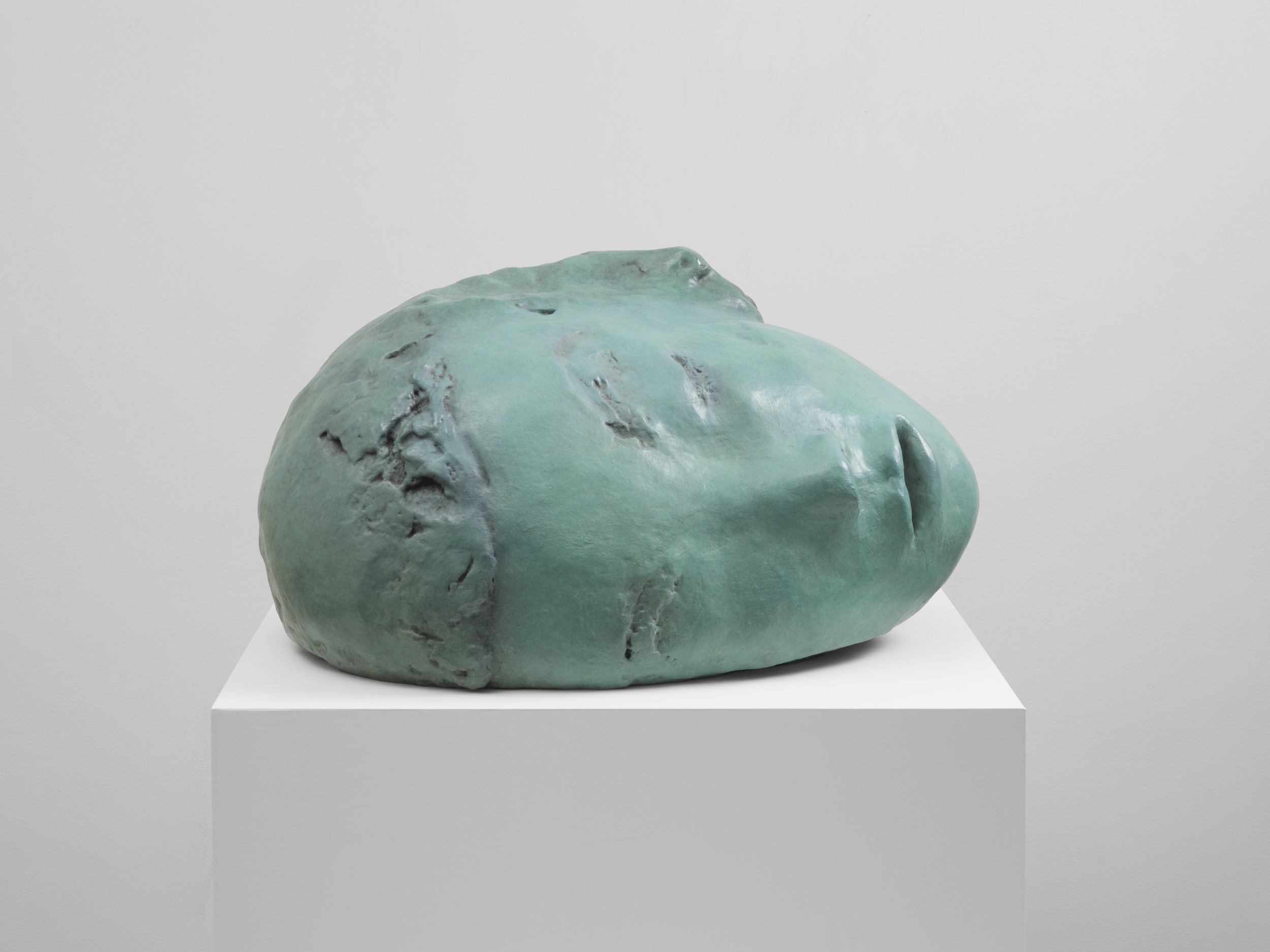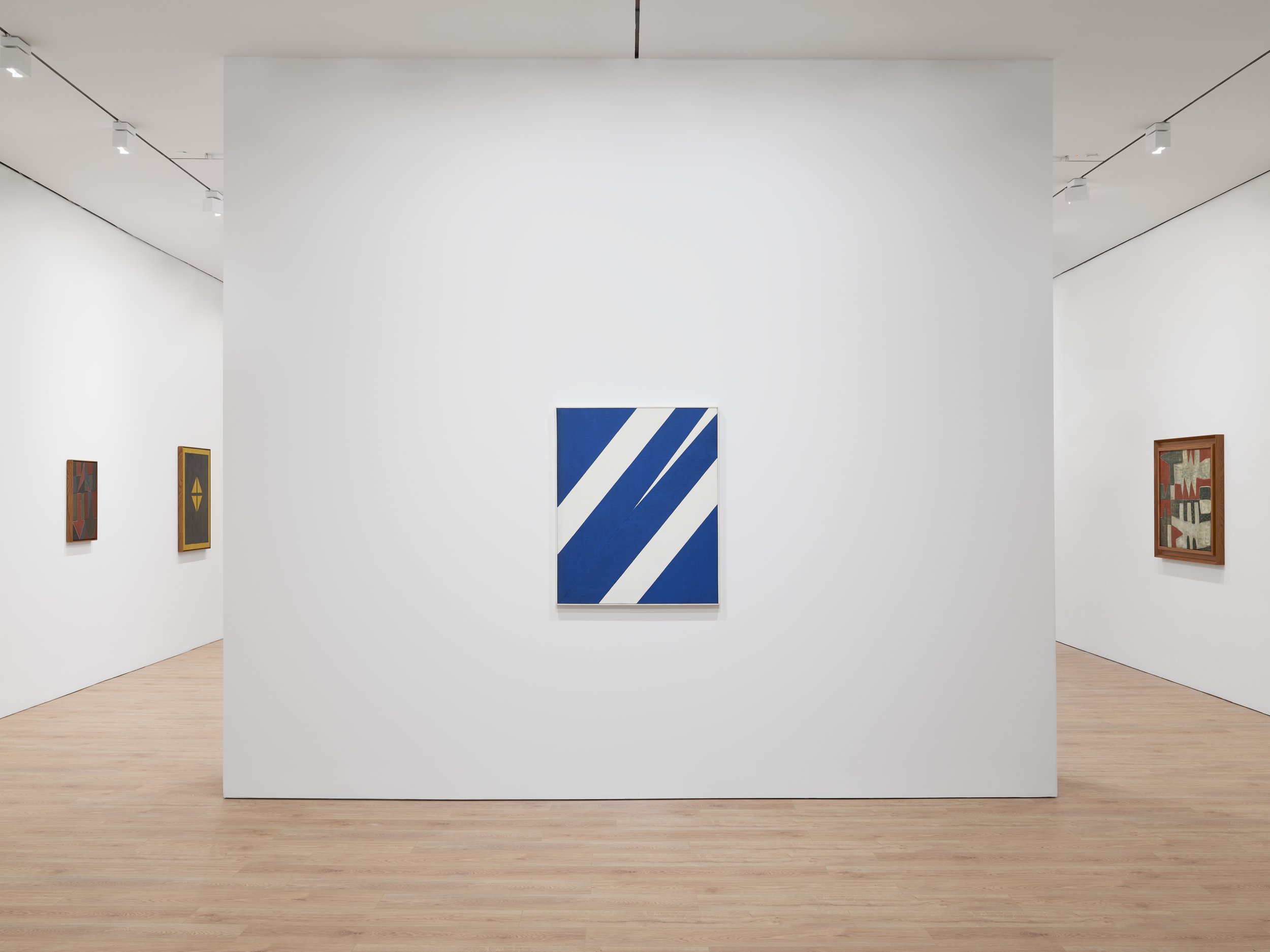Esiri Erheriene-Essi: Reflections
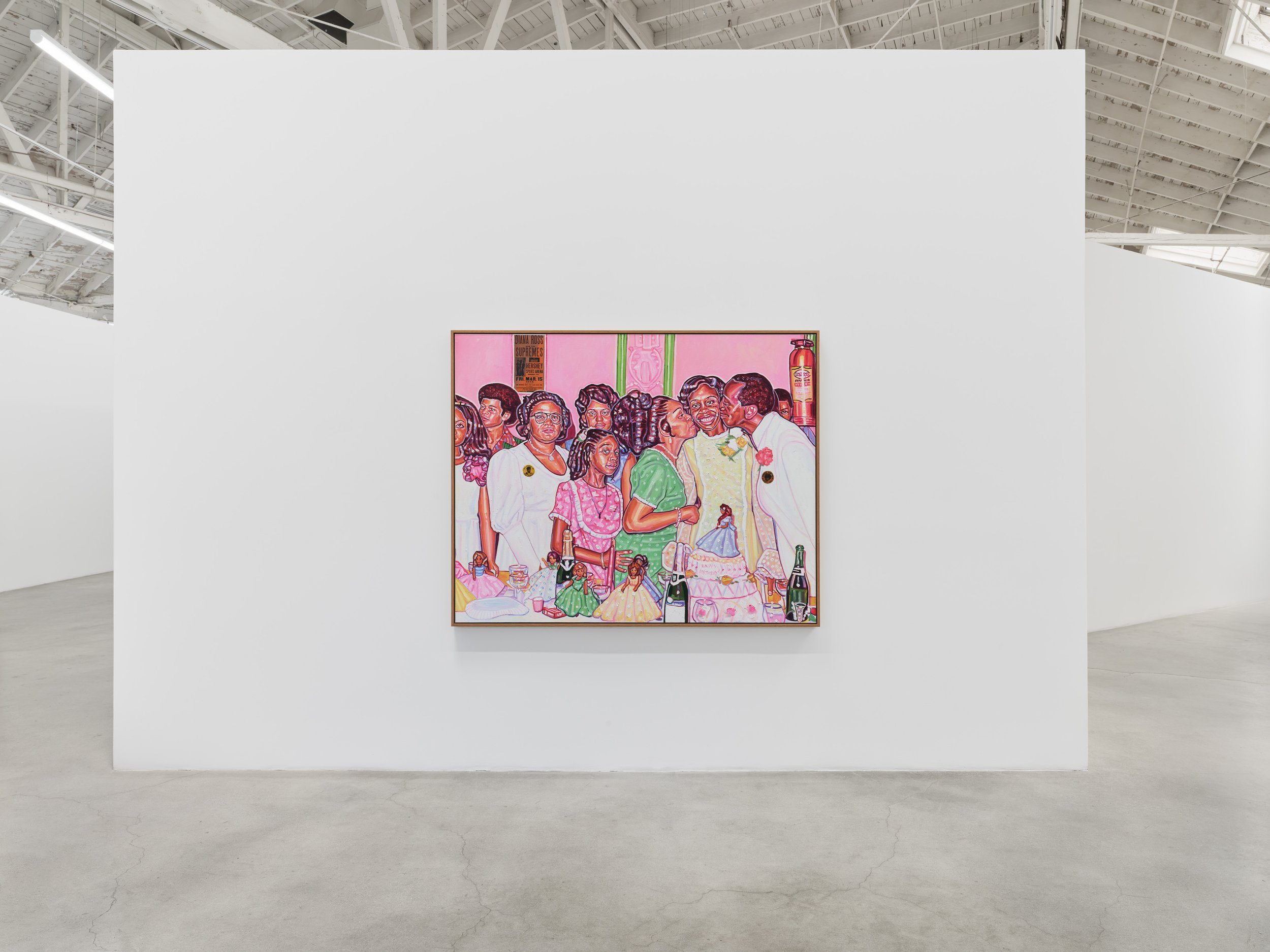
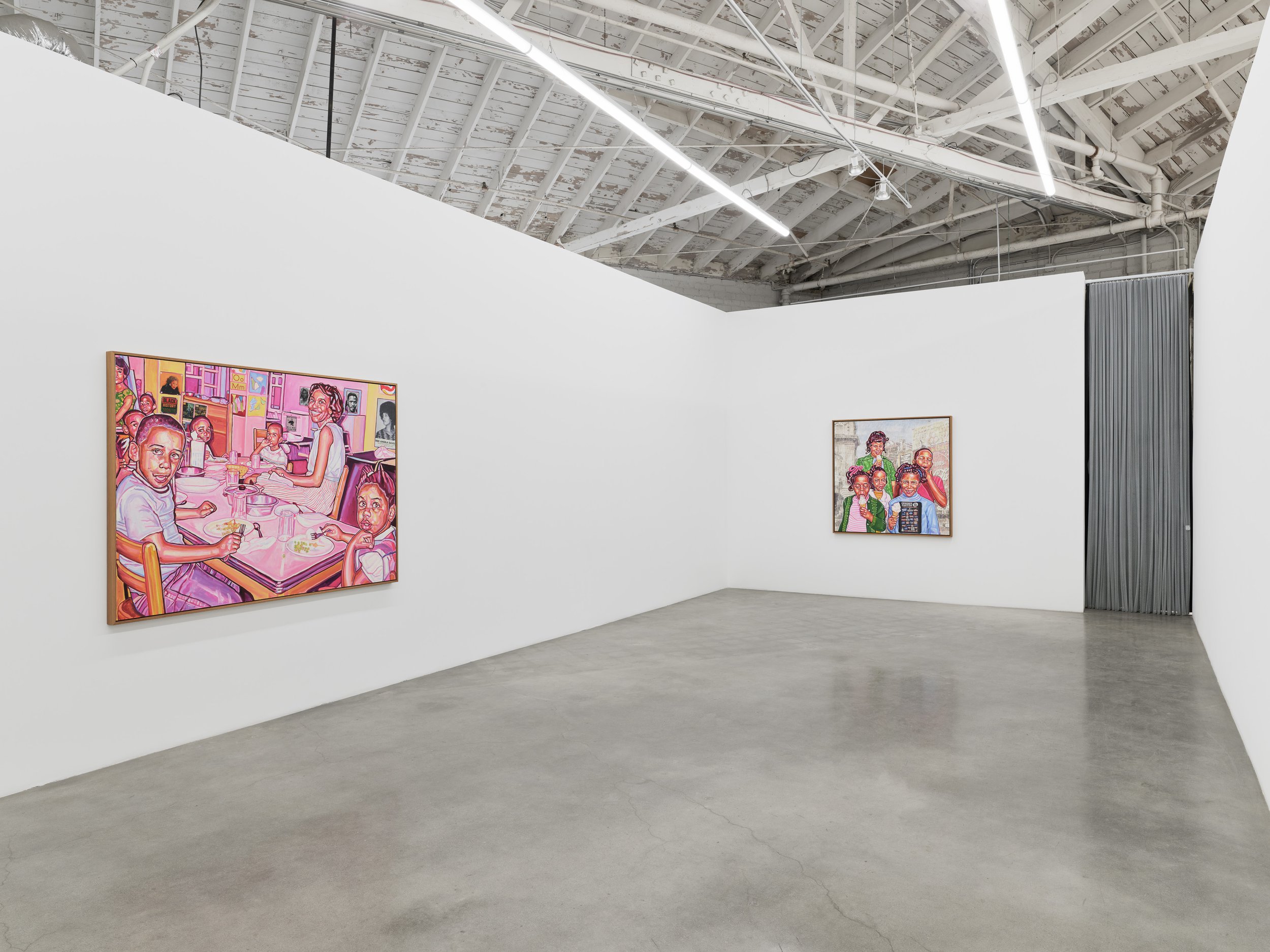
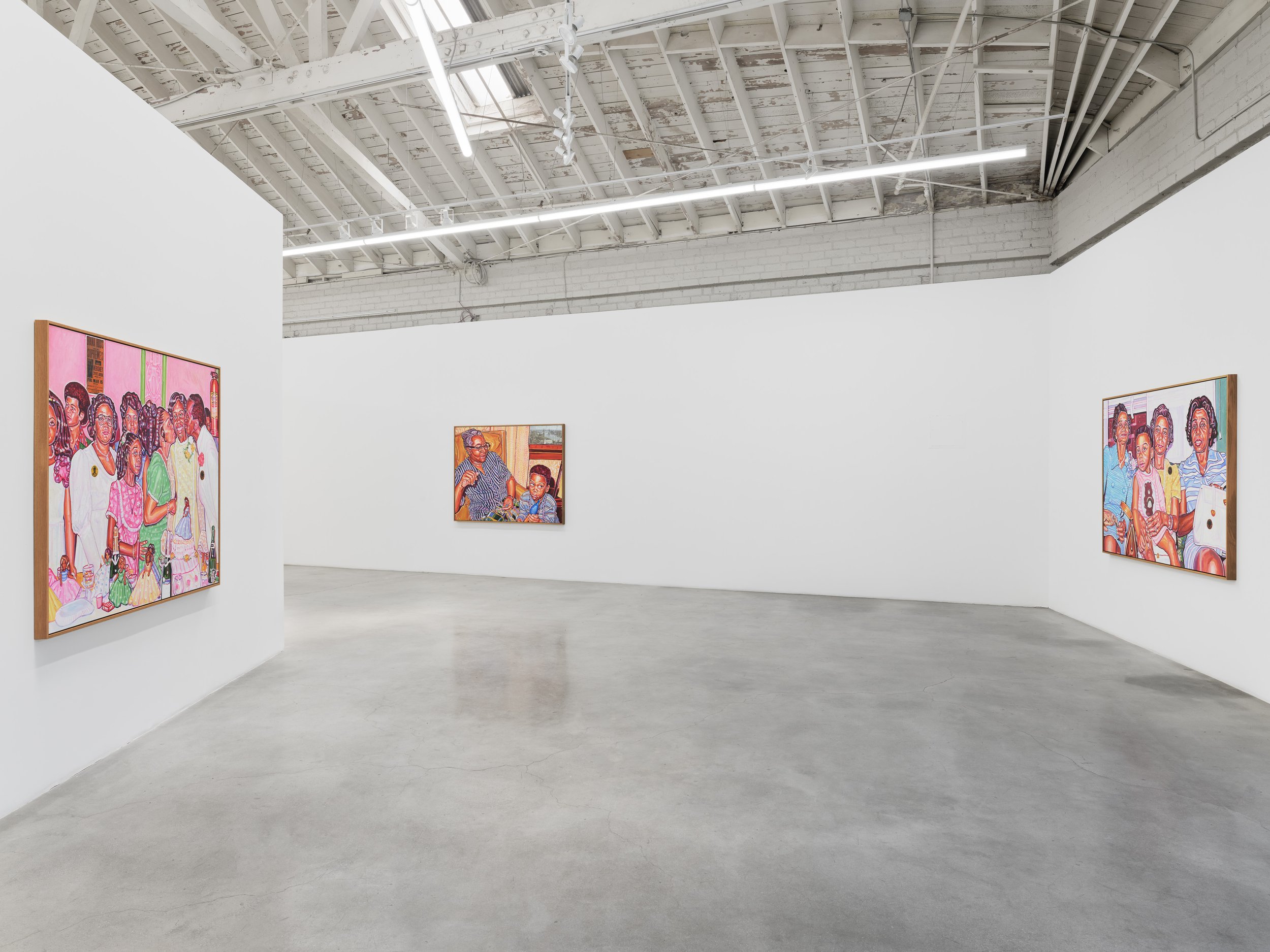
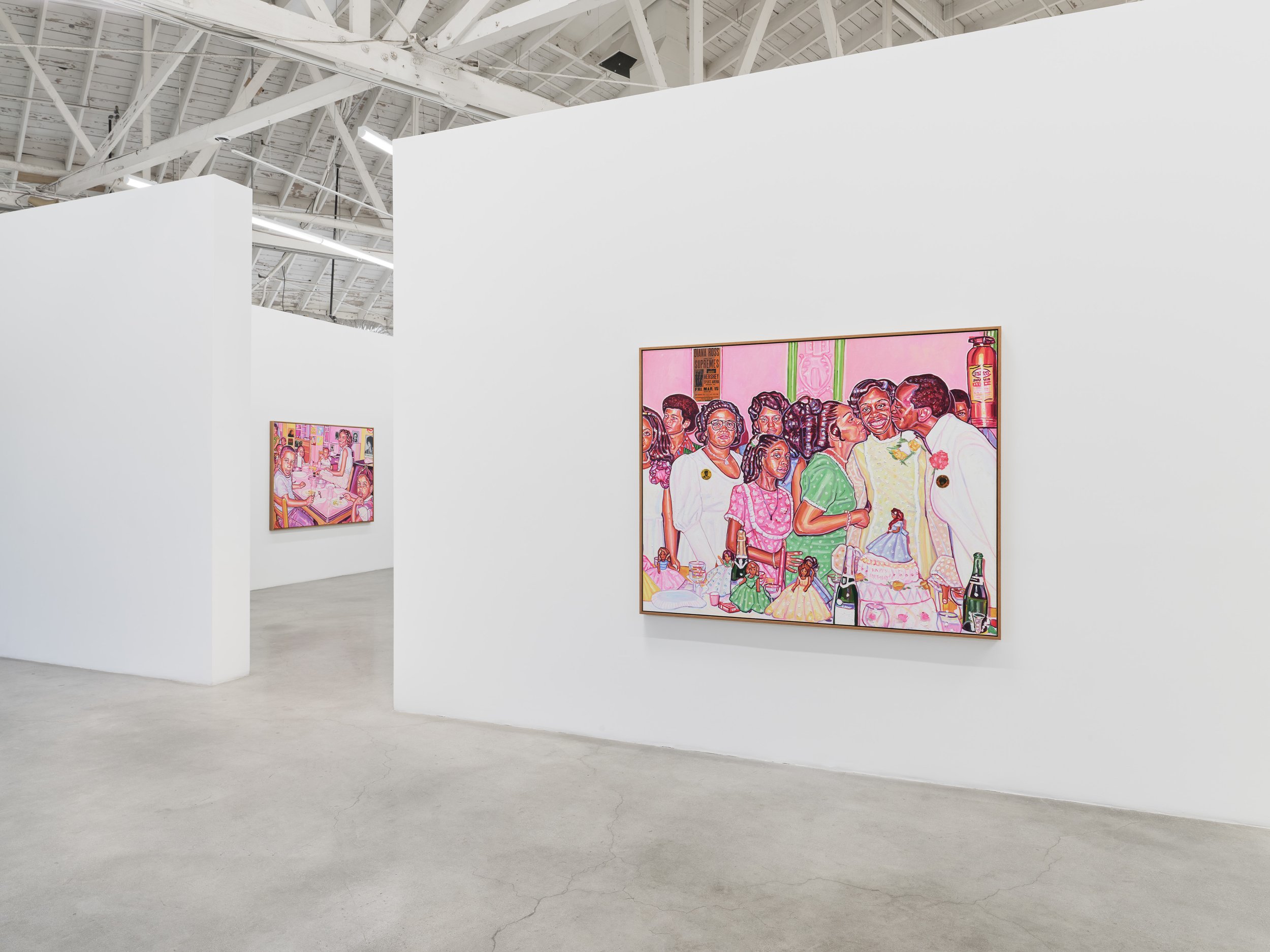
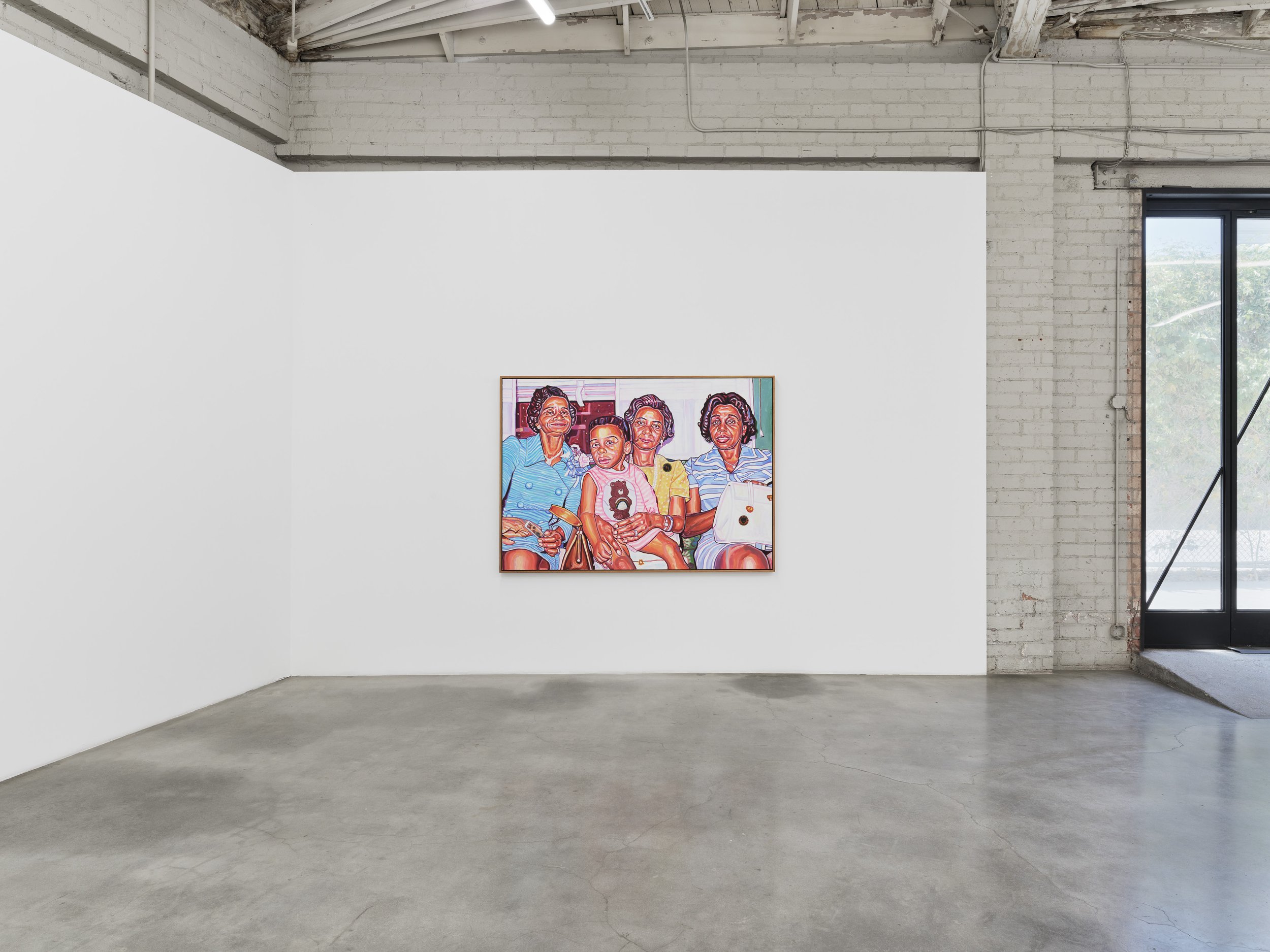
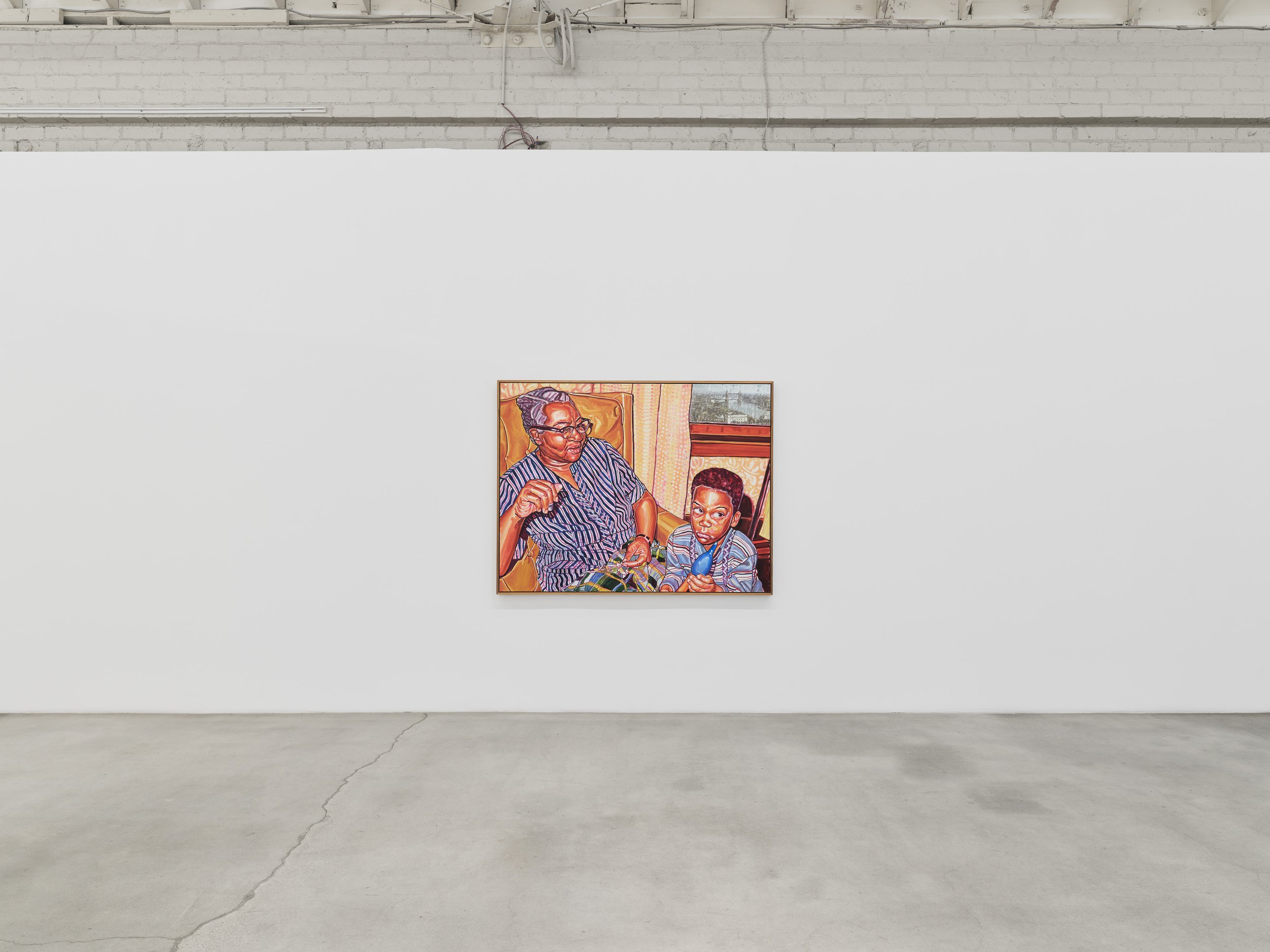
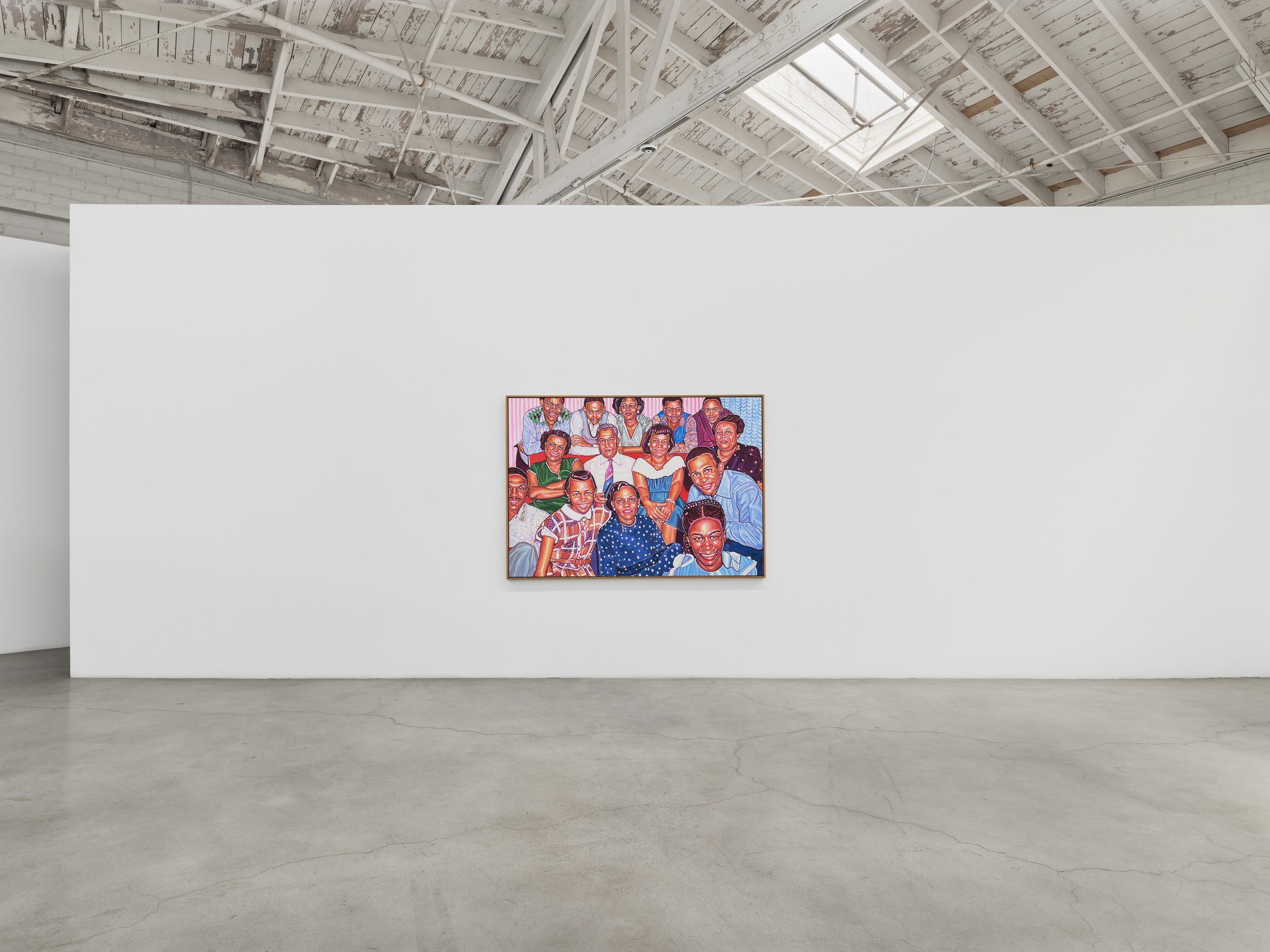
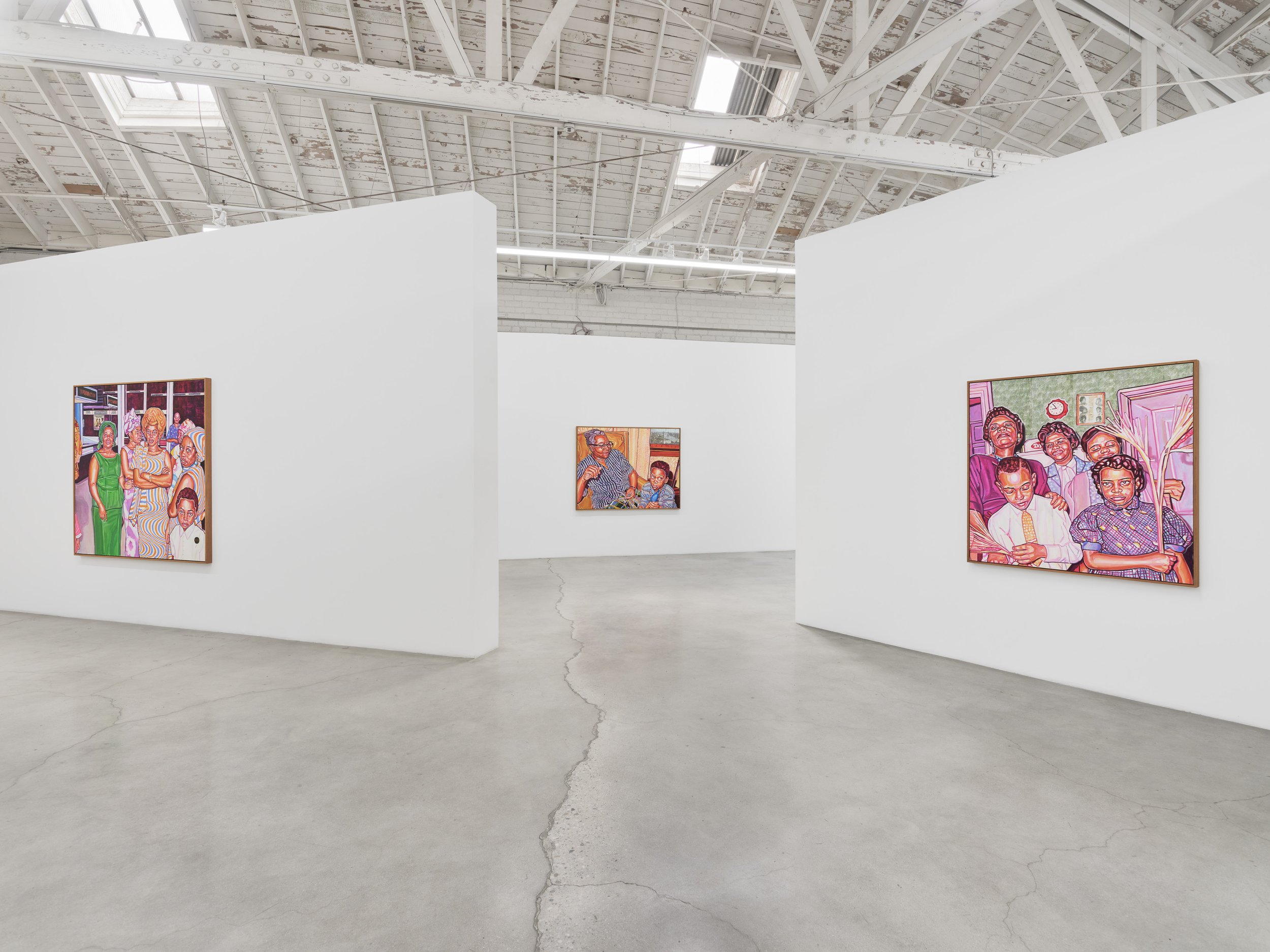
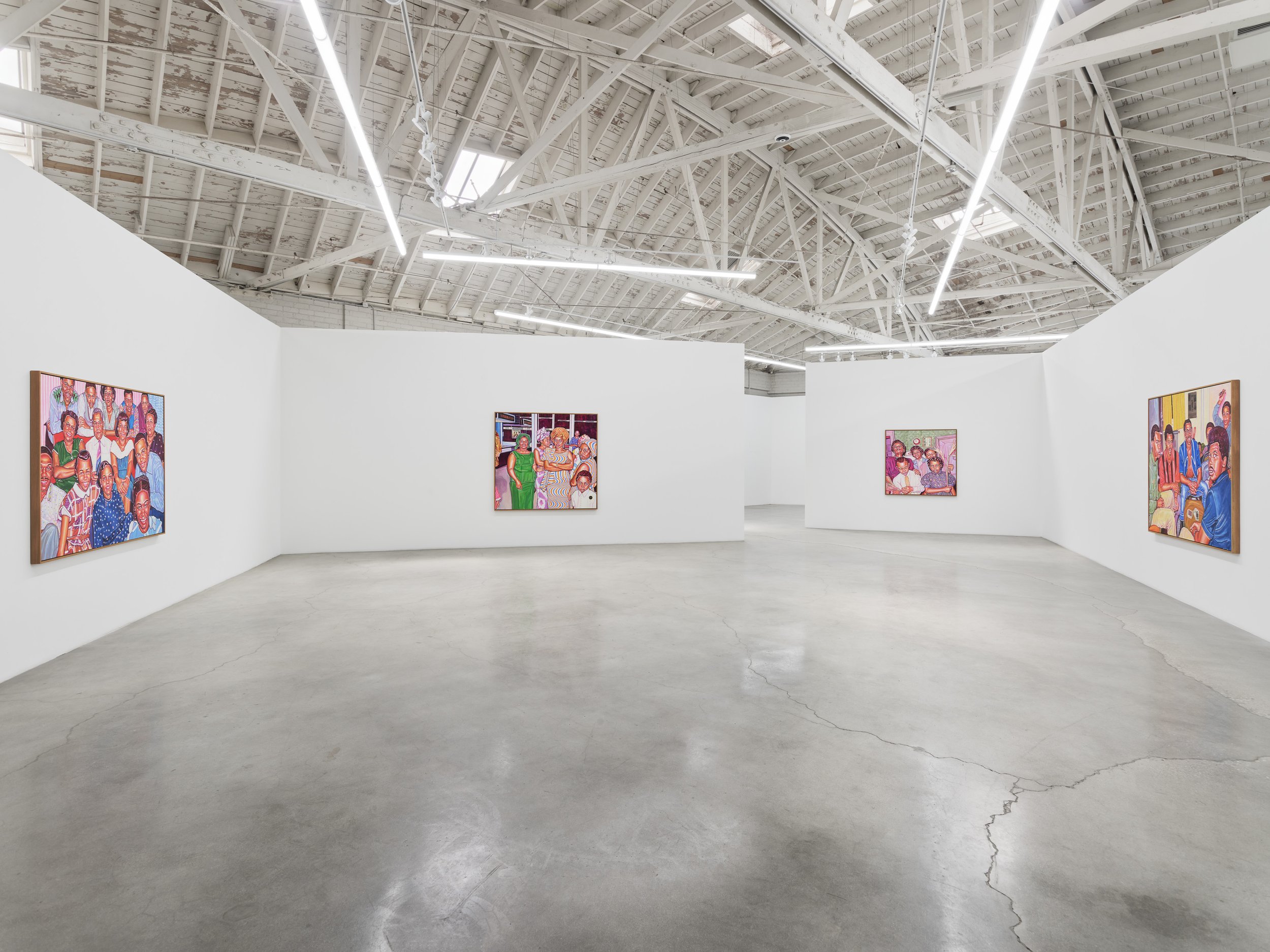
Installation view, Esiri Erheriene-Essi: Reflections, Night Gallery, Los Angeles. Image courtesy of the artist and Night Gallery 2025. Photo: Marten Elder
Night Gallery opened “Reflections,” a presentation of new paintings by Esiri Erheriene-Essi, on May 23rd. This is the artist’s first solo exhibition with the gallery. Based in Amsterdam, Erheriene-Essi created these works across an ocean, their arrival in Los Angeles a resonant offering, bringing with them the quiet weight of distance traveled and stories carried.
Across this new body of work, Erheriene-Essi carries on with her time-honored tradition of breathing life into inspired and discarded photographs, using paint, color, and layered ephemera to investigate memory. The artist works through her paintings with the same skill and stewardship as a quilter, threading together histories through texture and tone. In this new series, she embraces the flatness of photographic source material while deepening the emotional and chromatic complexity of brown skin—bringing dimension, variation, and luminosity to the surface.
Esiri Erheriene-Essi As my grandma always used to say, don't go borrowing trouble, 2023 oil, ink, and xerox transfer on linen 53 x 53 in (134.6 x 134.6 cm) framed: 54 1/2 x 54 1/2 x 2 1/4 in (138.4 x 138.4 x 5.7 cm)
This evolution is on view in A Royal Flush, a work depicting what the artist imagines to be a group of men enjoying their last days together before deployment to Vietnam. Their faces are marked by a spectrum of hues, highlights, shadows, and undertones, encapsulating the use of color as a tool to depict emotion.
Installation view, Esiri Erheriene-Essi: Reflections, Night Gallery, Los Angeles. Image courtesy of the artist and Night Gallery 2025. Photo: Marten Edler
An archivist and collector first, Erheriene-Essi begins her process by mining through estates and online repositories for faces and vignettes that speak to her. This collection has amassed across continents and oceans, from North America to Europe to Africa, demonstrating the diversity of Black identity, while illuminating the moments that are universal across all our memories.
Erheriene-Essi is deeply moved by the connection between the diaspora, not only across geography, but across time. Throughout Reflections she continues her exploration of this relationship. Motifs such as the Black power fist, the face of Toni Morrison, a “Dismantle Apartheid” pin, all time travel accentuating the collective memory
In her dissection of memory, Erheriene-Essi is a visual anthropologist, reading images for context clues and filling their gaps with gestures from her own lived experience. In A memory from your youth (London Trocadero), a fan poster for Beyoncé’s Cowboy Carter tour noticeably sits on the shirt of a girl eating ice cream in the 1970s. The artist’s temporal twist, fusing together past and present, melds Black iconography with earnest symbols of nostalgia.
Esiri Erheriene-Essi Same Town, New Story (Nigeria Airways), 2023 oil, ink and xerox transfer on linen 65 x 68 7/8 in (165 x 175 cm) framed: 66 1/2 x 70 1/2 x 2 1/4 in (168.9 x 179.1 x 5.7 cm)
As an artist, her mastery of collapsing time ensures the continuity of the culture. These paintings were created over the course of two years, in rhythm with the demands of motherhood—a theme that quietly permeates the work through the lens of legacy and inheritance. Erheriene-Essi sees her practice as an active conversation, one that begins with her paintings but is completed by the viewer’s own activations of memory.
Installation view, Esiri Erheriene-Essi: Reflections, Night Gallery, Los Angeles. Image courtesy of the artist and Night Gallery 2025. Photo: Marten Elder
The exhibition is titled in honor of the song by Diana Ross & The Supremes, a comfort album that has accompanied the artist through many seasons of her life, including the making of this body of work. The most apropos of the lyrics being:
“Reflections of the way life used to be.
Reflections of the love you took from me.”
In faded hues and frayed edges, Erheriene-Essi develops an architecture of remembrance, for what has been lost, and for which should never be. Her paintings become mirrors, not of the past as it was, but as it is felt. Reflection as a sacred act of reclamation.
Installation view, Esiri Erheriene-Essi: Reflections, Night Gallery, Los Angeles. Image courtesy of the artist and Night Gallery 2025. Photo: Marten Elder
For more information about this exhibition and current and future exhibitions, please visit Night Gallery’s site here. The magazine did an interview with Esiri, which can be found here.
Everyday Practices
Installation view of 'Everyday Practices’ at SAM at Tanjong Pagar Distripark. Image courtesy of Singapore Art Museum.
Singapore Art Museum (SAM) unveiled its new collection gallery at Tanjong Pagar Distripark with the inaugural exhibition Everyday Practices, reaffirming its commitment to showcasing and curating contemporary art from the National Collection that inspires profound reflections on our world today. Opened to the public on 30 August 2024, the exhibition is housed in the new Gallery 4 on Level 3 — SAM’s first space at Tanjong Pagar Distripark dedicated to highlighting varied critical artworks in the museum’s collection. Everyday Practices delves into the fundamental conditions of life and meaning, featuring works from 19 artists and one artist collective from 10 Asian countries.
Everyday Practices draws inspiration from Tehching Hsieh’s seminal work, One Year Performance 1978–1979, where Hsieh confined himself to a self-constructed holding cell in his studio and remained in solitude for a year, abstaining from activities such as conversation, reading, writing, listening to the radio, or watching TV. This became the first of Hsieh’s five year-long durational performances which turned the banality of life and the passage of time into both medium and subject for his art.
Building on Hsieh’s philosophy, Everyday Practices brings together diverse artworks by artists from different generations and geographies across Asia, focusing on the themes of “everyday”,“repetition,” ” and “endurance.” These artworks showcase the inventive ways artists have appropriated daily routines and lived experiences to express powerful statements of resilience and endurance in navigating adversity.
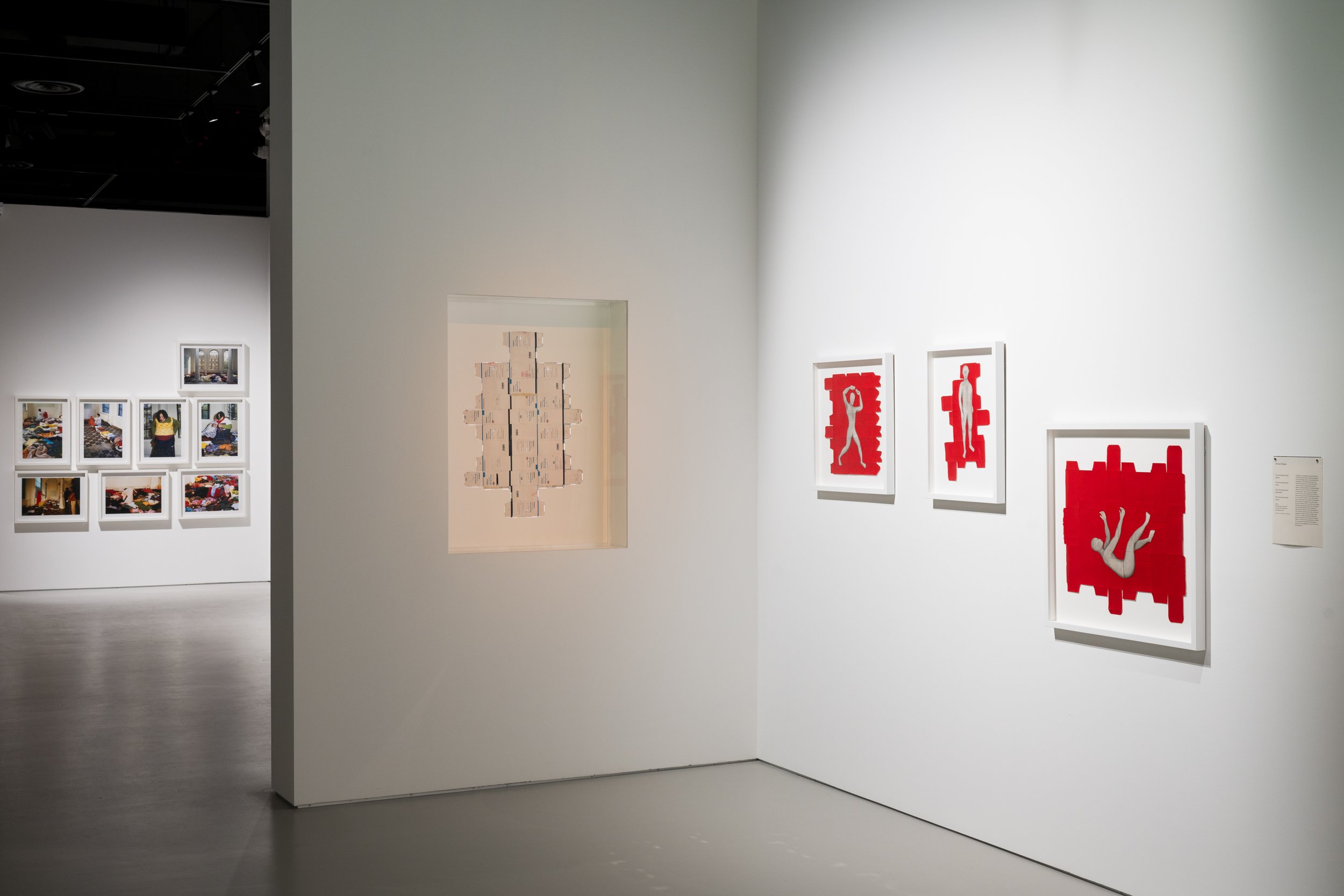
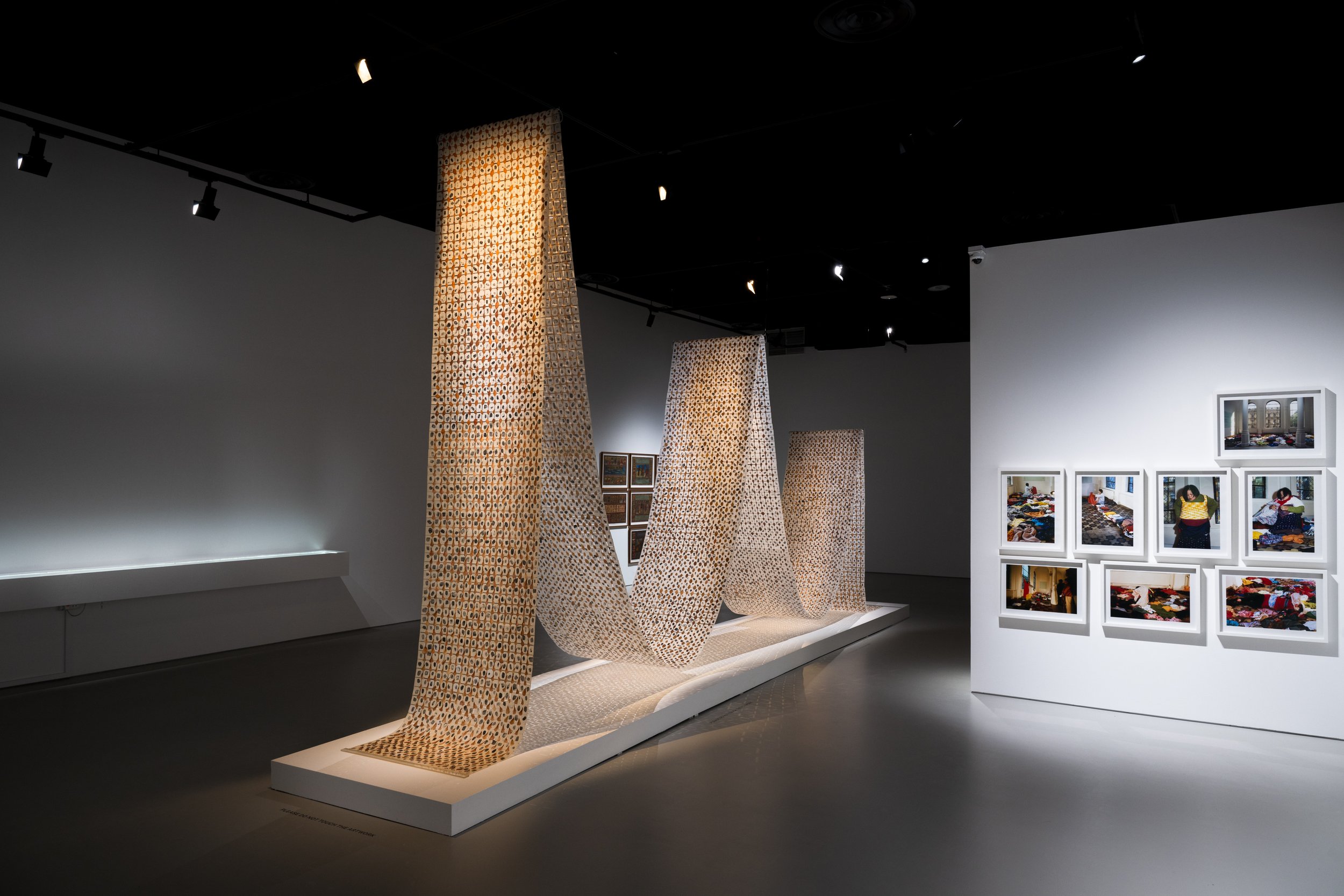
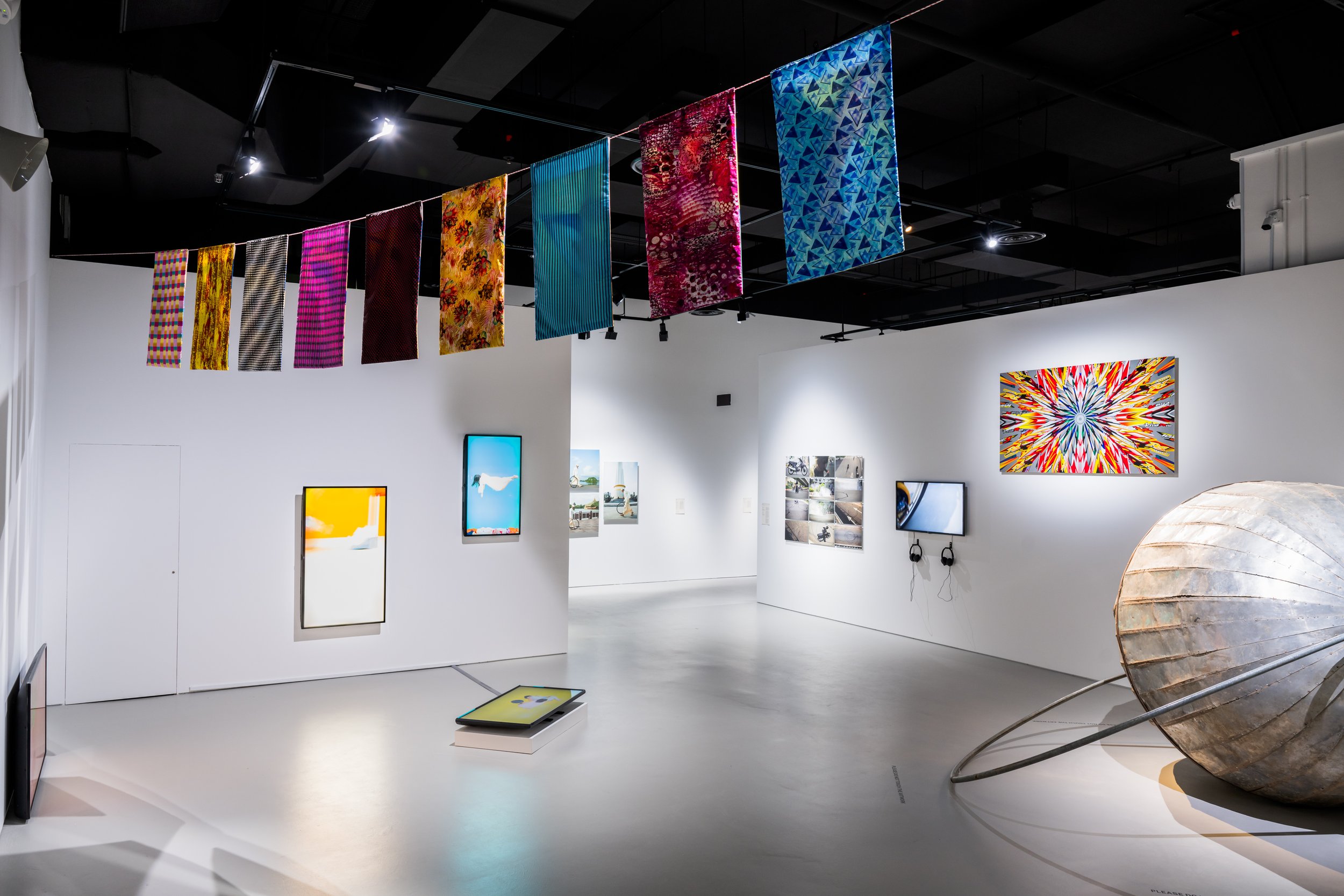
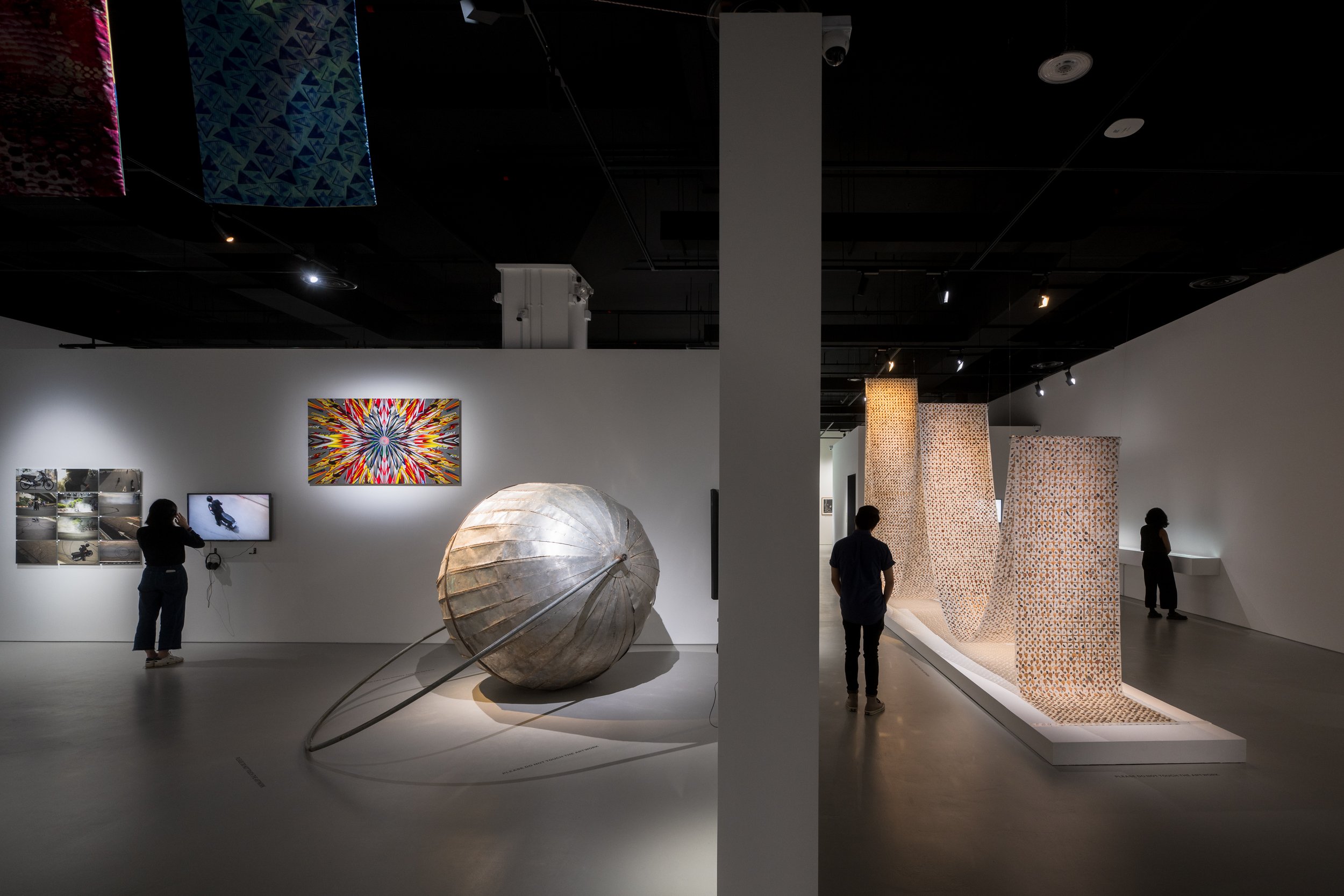
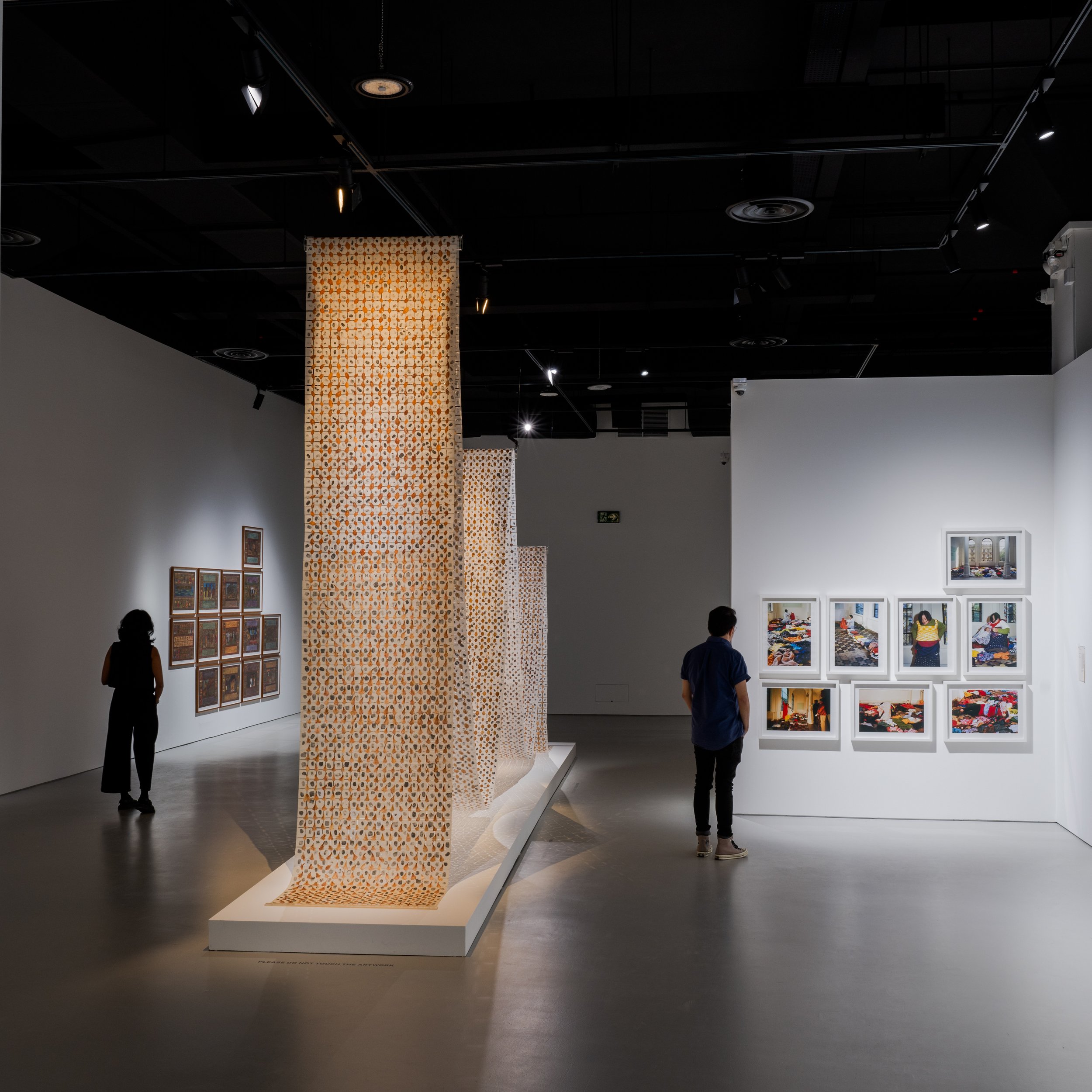

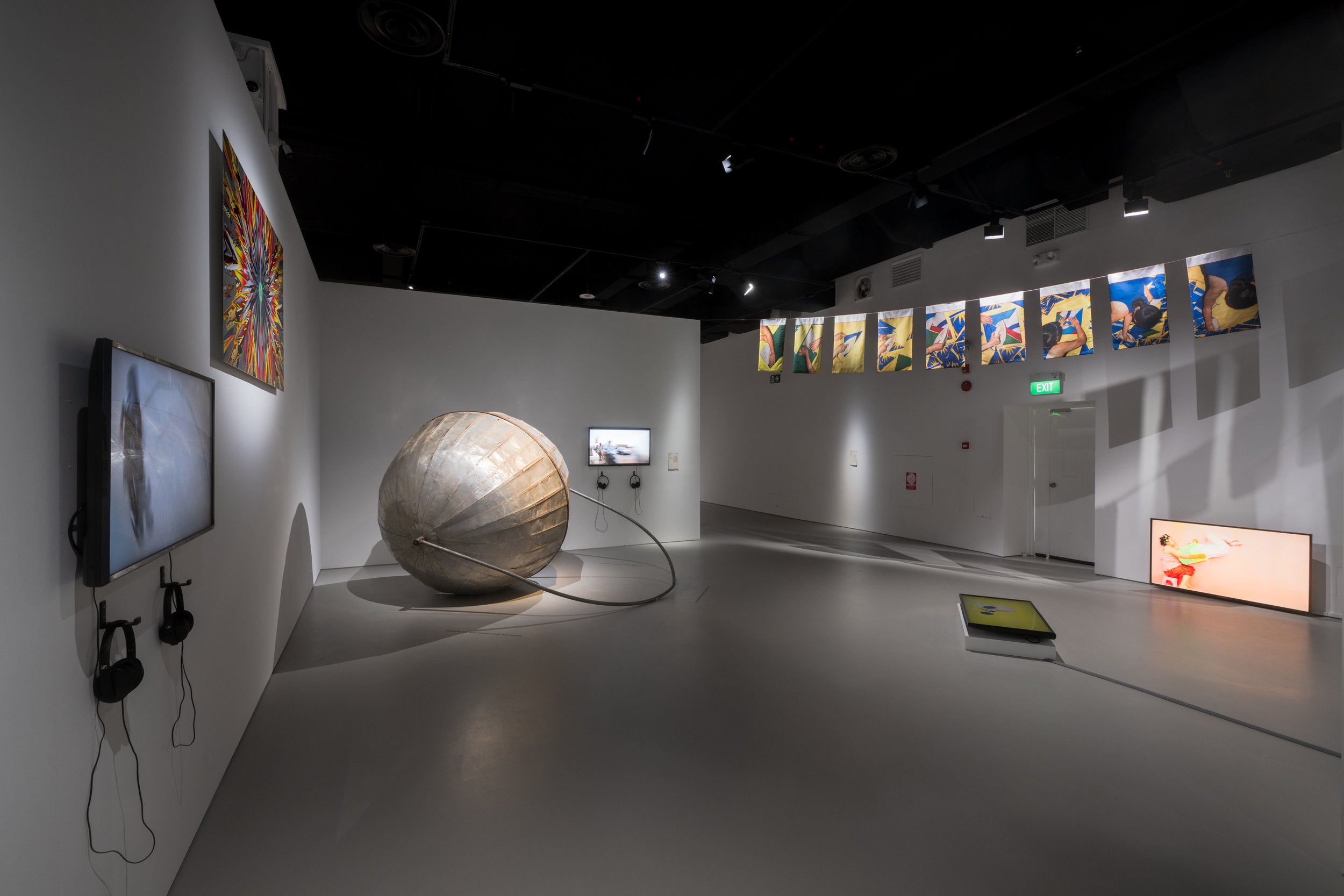
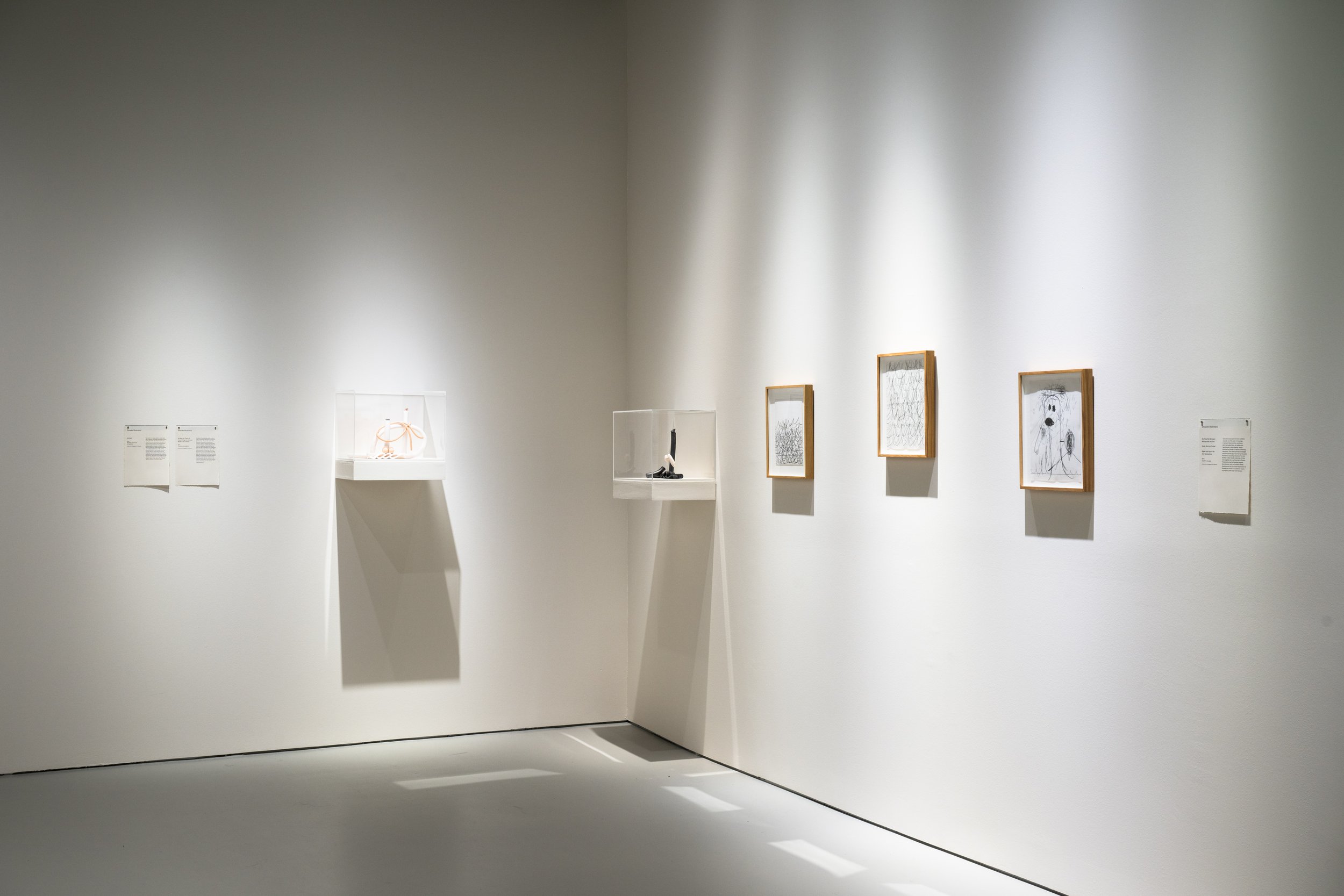
Installation view of 'Everyday Practices’ at SAM at Tanjong Pagar Distripark. Image courtesy of Singapore Art Museum.
The exhibition spotlights SAM’s efforts to grow a distinct and diverse collection with significant artworks from around the world and to present thoughtfully curated collection-focused exhibitions for local and international audiences. With the new collection gallery, SAM continues to offer new ways to explore artworks and practices that reflect our contemporary conditions. It also serves as a space that encourages active participation, discourse, and dialogue.
“The opening of Everyday Practices at SAM’s new collection gallery marks a significant milestone in our efforts to develop and showcase SAM’s critical collection of contemporary art. By deepening research on and expanding the collection scope of artistic practices from the 2000s in Southeast Asia and beyond, SAM aims to draw out narratives and perspectives that highlight the region’s diversity and connection with the global. We look forward to welcoming visitors to this new space, where everyone is invited to engage in dialogues with and around art that defines our time.”
Detail view and Installation view of Maria Taniguchi’s ‘Untitled’ (2017) as part of ‘Everyday Practices’ at SAM at Tanjong Pagar Distripark. Image courtesy of Singapore Art Museum.
Continuing the theme of repetition, Maria Taniguchi’s Untitled features a brickwork pattern covering the entirety of the artwork surface, extending endlessly. Each brick, a fundamental element in our daily environment, is painstakingly outlined in pencil and washed with black acrylic. This visual and conceptual device links this painting to others in the series. The varying dilutions of the paint introduce subtle tonal shifts, reflecting the passage of time and the steady, labour-intensive process that characterises Taniguchi’s work.
Everyday Practices further examines how routine actions and gestures can serve as subtle forms of resistance, revealing how art becomes a tool to navigate challenges amid ongoing global conflicts and humanitarian crises. Htein Lin’s Soap Blocked utilises everyday items from his environment to convey powerful messages. Just as how Taniguchi hand-draws each brick, Htein Lin’s installation features hundreds of hand-carved soap blocks, arranged to form a map of his native country Myanmar, with red blocks marking the locations where political prisoners have been held. Upon closer look, each soap block reveals a tiny, hunched figure trapped within the rectangular space. This work reflects Htein Lin’s personal history of imprisonment for political dissent and the collective helplessness experienced under military rule.
Installation view of Khvay Samnang’s ‘Untitled’ (2011-2013) as part of ‘Everyday Practices’ at SAM at Tanjong Pagar Distripark. Image courtesy of Singapore Art Museum.
Echoing this concept, Khvay Samnang’s Untitled depicts the artist pouring a bucket of sand over himself in five different lakes in Cambodia’s capital Phnom Penh. This act, documented in video, responds to the displacement of thousands of families due to the illegal sale of state-owned lakes to private investors. Khvay’s futile yet symbolic gesture captures the powerlessness of the resettled communities, resigned to their fate.
Installation view of Minstrel Kuik’s ‘Domesticated Politics’ (2015) as part of ‘Everyday Practices’ at SAM at Tanjong Pagar Distripark. Image courtesy of Singapore Art Museum.
Narratives shaped by turbulent political landscapes and histories are also explored in Minstrel Kuik’s Domesticated Politics, which recontextualises flags from Malaysia’s 2013 General Elections by presenting them as DIY creations. By abstracting and “muting” these flags through domestic acts like folding and ironing, Kuik feminises and softens objects that were once exuberant, masculine, and heroic, offering a reflective commentary on the political and societal landscape of the country. Similarly, Svay Sareth’s Mon Boulet— French for “my ball” or colloquially, “my burden” — involved a gruelling 250-kilometre journey from Siem Reap to Phnom Penh over six days, during which he dragged an 80-kilogram metal ball through the streets and alleys of Cambodia. This arduous feat symbolises the heavy personal and historical burdens that still linger in Cambodian society today while highlighting the resilience of the human spirit, as embodied in the ball’s relentless forward motion.
Installation view of Guo-Liang Tan’s ‘Peripheral Ritual I–III’ (2018) as part of ‘Everyday Practices’ at SAM at Tanjong Pagar Distripark. Image courtesy of Singapore Art Museum.
Guo-Liang Tan’s Peripheral Ritual I–III consists of three paintings made with thinned paint on aeronautical fabric, producing seemingly accidental yet meticulously composed stains through various bodily gestures such as shifting, tilting and turning. Tan's process, which he describes as using his “own body to respond to the painting as objects, ” results in amorphous hues that evoke the appearance of bruised skin, highlighting the physicality of his approach and the negotiations between body, material and laws of physics (or forces of gravity). Wong Hoy Cheong’s Tapestry of Justice extends this exploration of subtle resistance through a delicate tapestry of over 10,000 photocopied thumbprints held together with plant leaves and petals. Collected during Malaysia’s Reformasi movement in the late 1990s, they function as an artwork and a petition, highlighting the ironic duality of thumbprints as a mark of criminality and a reliable form of identification, while emphasising the power of collective action to drive change.
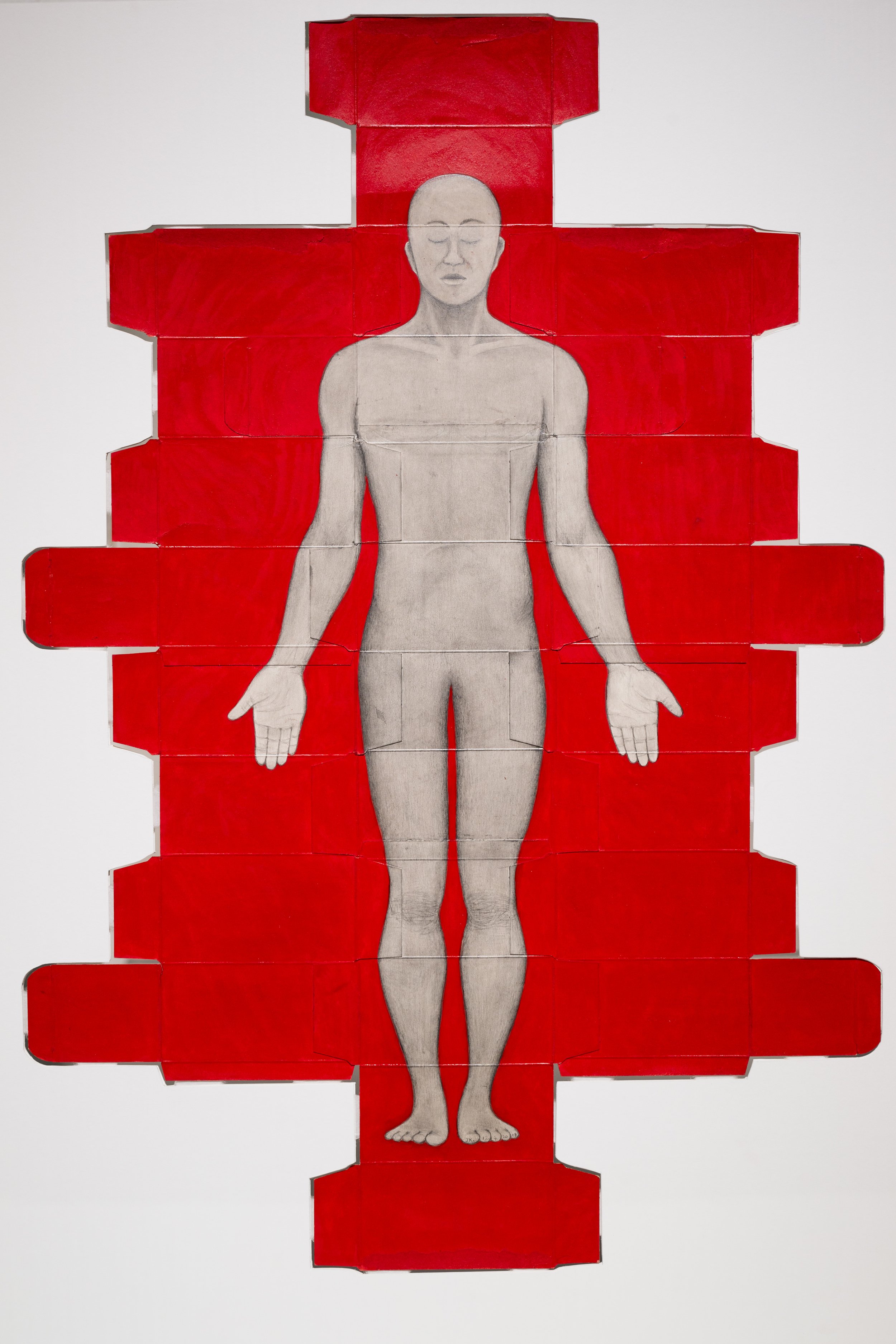
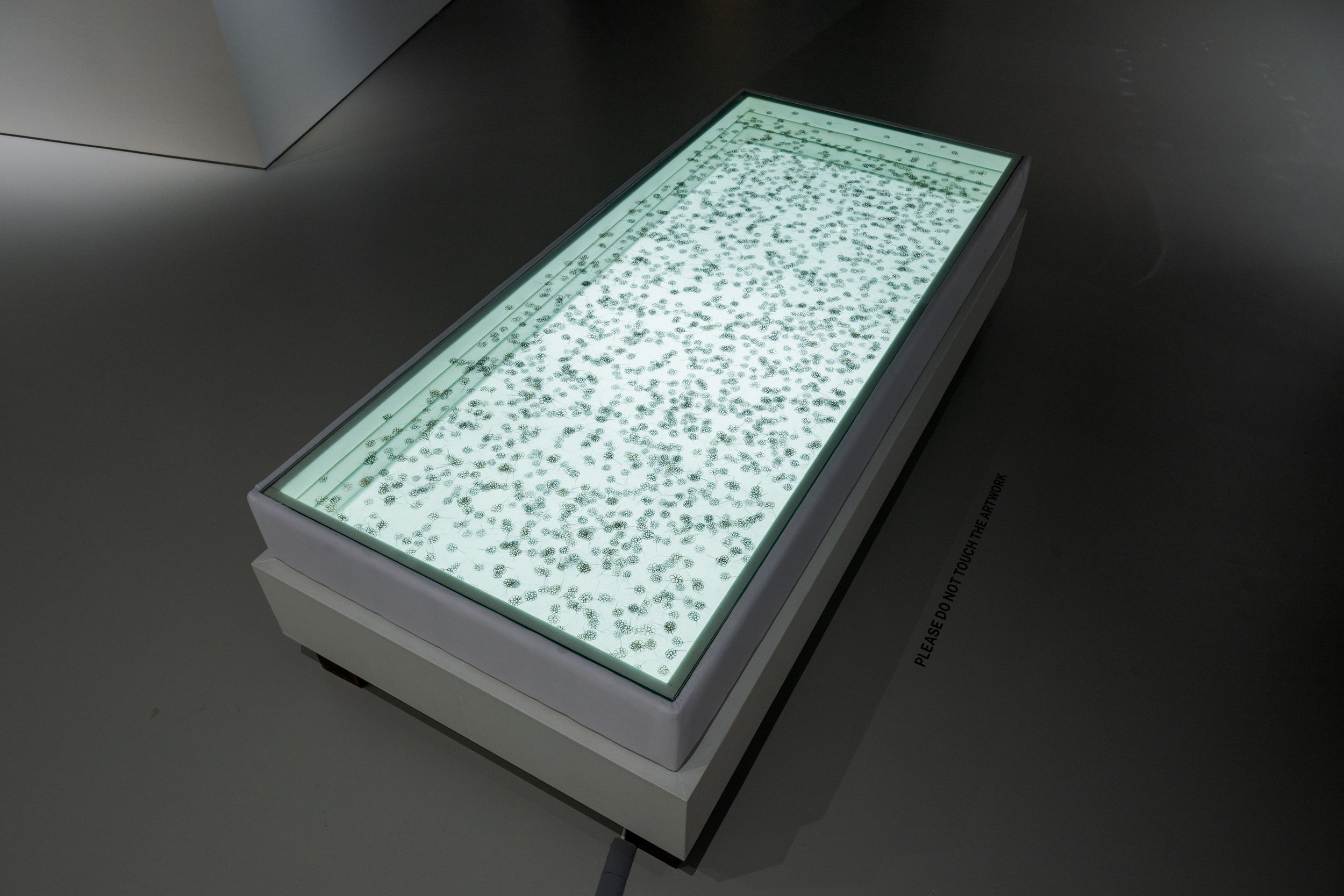
Detail view of Jerome Kugan’s ‘The Internalised Self: Apollo’ (2018) as part of ‘Everyday Practices’ at SAM at Tanjong Pagar Distripark. Image courtesy of Singapore Art Museum. Installation view of Imhathai Suwatthanasilp’s ‘The Flower Field’ (2012) as part of ‘Everyday Practices’ at SAM at Tanjong Pagar Distripark. Image courtesy of Singapore Art Museum.
Other artworks compellingly reflect narratives of endurance in the face of personal adversities. Jerome Kugan’s The Internalised Self series (Atlas, Apollo, Icarus, Ganymede) features ambiguous and androgynous figures set against crimson backgrounds on recycled cartons of antiretroviral drugs, alluding to the artist’s HIV-positive status. These figures, devoid of conventional gender markers, explore themes of selfhood and resilience, transforming a deeply personal predicament into a narrative of self-reckoning and empowerment. Similarly, Imhathai Suwatthanasilp’s The Flower Field, featuring meticulously handspun balls of hair donated by cancer patients, survivors, and supporters, evokes a utopian realm. This poignant tribute to human resilience carries a powerful message of hope for a brighter future.
About Singapore Art Museum
Singapore Art Museum opened in 1996 as the first art museum in Singapore located in the cultural district of Singapore. Known as SAM, the museum presents contemporary art from a Southeast Asian perspective for artists, art lovers and the art curious in multiple venues across the island, including a new venue in the historic port area of Tanjong Pagar.
The museum is building one of the world's most important public collections of Southeast Asian contemporary art, with the aim of connecting the art and the artists to the public and future generations through exhibitions and programmes. SAM is working towards a humane and sustainable future by committing to responsible practices within its processes
Everyday Practices opened on 30 August 2024 and will close on 20 July 2025.. For more information about the exhibition and other exhibitions at SAM, please visit their site here. The museum can also be found on Facebook, Instagram, X, and YouTube.
Steve McQueen: Bounty
Exhibition View, Steve McQueen: Bounty, Marian Goodman Gallery Paris, 2025 Courtesy of the artist and Marian Goodman Gallery Photo Credit: Rebecca Fanuele
Marian Goodman Gallery is pleased to present Bounty, Steve McQueen's first solo exhibition in France since 2016. One of the most influential artists of his generation and an internationally acclaimed filmmaker, McQueen is known for his inventive dissemination of social constructs, often addressing painful and overlooked histories through projected images and sound. Bounty, a series of 47 photographs capturing the vivid beauty of flowers native to the Caribbean Island of Grenada, makes its European debut following its presentation at Dia Chelsea in New York. Through this verdant imagery, McQueen offers more than a study of nature: he presents a meditation on history, West Indian heritage, and resilience. A new work will be presented alongside Bounty.
Bounty is not McQueen’s first work created in Grenada, his parents’ country of origin; two earlier video installations, Carib’s Leap (2002) and Ashes (2016), each subsequent results of his travels there, juxtapose idyllic scenes with tragic narratives. While Carib’s Leap is a poignant homage to the island’s indigenous people who in 1651 once chose death over surrendering to the invading French, Ashes commemorates the life of a young man, murdered at 25 at the hands of drug dealers. These works challenge the postcard-perfect imagery often associated with the Caribbean, subtly suggesting that beauty and violence, life and death, have always coexisted on the island.
Exhibition View, Steve McQueen: Bounty, Marian Goodman Gallery Paris, 2025 Courtesy of the artist and Marian Goodman Gallery Photo Credit: Rebecca Fanuele
With Bounty, McQueen continues this exploration through a similarly evocative approach. At first glance, the 47 photographs on view present vibrant, colorful and tropical flora, such as yellow hibiscus, West Indian jasmine and pink ginger lily, reminiscent of the tradition of floral representations in art history. Yet beneath the surface of this inflorescence lies a deeper, more painful truth. These plants have silently witnessed the island’s tragic past: the disappearance of its indigenous people and the cruel history of colonization, marked by the deportation and enslavement of Africans under French and British rule over the course of several centuries.
Exhibition View, Steve McQueen: Bounty, Marian Goodman Gallery, Paris, 2025. Courtesy of the artist and Marian Goodman Gallery Photo Credit: Rebecca Fanuele
“What has been constant in the landscape is the beauty of the flowers. These plants have been a marvel in a landscape traumatized by colonialism and slavery,” explains McQueen who sees these flowers “as flesh wounds, as hurt, as pain.” In McQueen’s eyes, the contrast between nature's splendor and history's brutality reveals a disturbing paradox: “Sometimes the most horrible things happen in the most beautiful places; it’s perverse.” This contradiction is further pronounced by the title of the series, with Bounty referring both to nature’s abundance and to the reward once paid for capturing or killing enslaved people.
Through each flower’s concealed encapsulation of untold stories, hopes and sufferings, McQueen pays tribute to generations of the West Indies’s inhabitants. Here, evergrowing florals simultaneously symbolize acts of remembrance and resilience. The intensity of the series comes not only from this historical evocation but also from the intricate details of the installation, in which prints are arranged in one continuous line across the gallery’s Sienna red-painted walls. McQueen’s close attention to the viewer’s experience is a constant in his practice, each of his presentations is conceived as a transformative journey, prompting reflection on how one’s gaze changes between entering and leaving the exhibition space.
Exhibition View, Steve McQueen: Bounty, Marian Goodman Gallery Paris, 2025 Courtesy of the artist and Marian Goodman Gallery Photo Credit: Rebecca Fanuele
As cultural studies scholar Paul Gilroy notes in a recent essay: “Steve McQueen’s art has frequently confounded the human sensorium. His restless reorientation of visual perception has involved inventing new angles from which to examine the human body and the world. He has sought perspectives to defamiliarize the eyes’ interpretative habits, interrogating its 'peculiar disposition’ to perceive the world in racializing ways. The quest for unprecedented ways to see and thus to know, is unrelenting.” (Paul Gilroy, “For a Low-end Theory of Black Atlantic Cymatics” in Steve McQueen, Bass, published by Laurenz Foundation, Schaulager Basel and Dia Art Foundation, 2024.)
A conversation between McQueen and Hans Ulrich Obrist, Artistic Director, Serpentine Galleries, London, will be held at the gallery on Saturday, 21 June at 4 pm. Admission is free, subject to availability and advance booking.
Awarded the Turner Prize in 1999 and the 2024 Rolf Schock Prize in Visual Arts, Steve MᶜQueen (1969 - ) has had his artwork presented at some of the most significant venues and museums around the world. His work has been featured in Documenta (1997 and 2002). He represented Great Britain at the 53rd Venice Biennale in 2009 and was selected several times for the Venice Biennale (2003, 2007, 2013, and 2015). A co-commission by Dia Art Foundation and Laurenz Foundation, Schaulager, Bass (2024) is an immersive, site-responsive installation consisting of shifting spectrums of light in concert with sound inspired in part by the hybrid musical idiom that resulted from the transatlantic slave trade, on view at Dia Beacon until 26 May 2025, that will continue onwards with a custom presentation at Schaulager, Basel from 15 June to 16 November 2025. A concurrent presentation of Sunshine State is currently on view at Dia Chelsea in New York until 19 July 2025. Resistance, a show conceived by McQueen that chronicles a century of British protest through photography, is on view through 1 June 2025 at Turner Contemporary, Margate (UK), before traveling to the National Galleries Scotland: Modern Two, Edinburgh, from 21 June 2025 to 4 January 2026.
Solo exhibitions of his work have been held at the Art Institute of Chicago (2002, 2009, 2012, 2017); Schaulager, Basel (2012-2013); Whitworth Art Gallery, Manchester (2017); The Museum of Modern Art, New York (2017); Institute of Contemporary Art, Boston (2017). In 2019 he presented YEAR 3 at Tate Britain and had a major solo exhibition at Tate Modern in 2020, which toured to Pirelli HangarBicocca, Milan, in 2022. In 2023, Grenfell, a film made in response to the tragic fire that took place at Grenfell Tower, was presented at the Serpentine South Gallery, London. A national tour of Grenfell (2025-2027) is currently in progress in public art galleries in six major cities across England, Scotland, Wales and Northern Ireland.
Exhibition View, Steve McQueen: Bounty, Marian Goodman Gallery Paris, 2025 Courtesy of the artist and Marian Goodman Gallery Photo Credit: Rebecca Fanuele
MᶜQueen has directed five feature films; Hunger (2008), Shame (2011), 12 Years a Slave (2013), Widows (2018) and Blitz (2024). Hunger was awarded the Caméra d’Or at the Cannes Film Festival, and 12 Years a Slave received the Golden Globe, Oscar, and BAFTA Awards for best picture in 2014. His latest feature, Blitz, the story of a mixed-race family in the context of the bombing of London in 1940, was released in 2024. In 2020, he directed Small Axe, an anthology of five films about London’s West Indian community and in 2021, Uprising, a three-part documentary with James Rogan about the New Cross Fire in London in 1981. His documentary film, Occupied City, a portrait of Nazi and modern-day Amsterdam, debuted at Cannes in May 2023.
MᶜQueen was named an Officer of the Order of the British Empire (OBE) in 2002 and a Commander of the Order of the British Empire (CBE) in 2011. He was knighted in the 2020 New Year Honors list. MᶜQueen was born in West London and is based in London and Amsterdam.
Steve McQueen’s Bounty opened on May 24 and will conclude on July 25, 2025. A conversation took place between Steve McQueen and Hans Ulrich Obrist on Saturday, June 21, at 4 pm. Marian Goodman gallery at the Paris Location, 66 Rue du Temple, 75003 Paris, France. For more information about the exhibit, please visit the Marian Goodman Gallery’s site. The gallery can be found on Instagram and Artsy, too.
Peter Fillingham: Basil Dress
Installation view, Peter Fillingham Basil Dress, Marian Goodman Gallery, Paris, 2025 Courtesy of the artist and Marian Goodman Gallery Photo credit: Rebecca Fanuele
Marian Goodman Gallery is pleased to present for the first time a solo show by Peter Fillingham featuring a new group of sculptural works that resonate with memory and history. Working primarily with found materials—objects often dismissed for their low cultural or economic value—Fillingham transforms the overlooked into sculptural forms and installations that carry a sense of theatricality. Rooted in the margins, both geographic and material, his practice exists where art coexists with everyday life. He draws inspiration from the structures and systems that operate behind the scenes in zones of transit, trade, and daily exchange, where colors are haphazard and materials give rise to unintentional sculptural ‘events.’
Upon entering the gallery, visitors encounter Fruit Salad, 2025, an installation comprising a jacket, an overcoat and trousers given to Fillingham by his long-time friend, the artist Tacita Dean. The set of garments, which belonged to her grandfather, Basil Dean, inspires Fillingham to evoke ENSA - The Entertainment National Service Association founded by Basil Dean in 1939. ENSA’s aim was to provide entertainment for British and Allied forces in warzones through comedians, singers, dancers and other performers who devoted themselves to providing levity for the entirety of the war. Fillingham found affinity with ENSA’s philosophy of improvisation, economy of means and inclusivity along with its affiliation with the Pierrot troupes from the time of World War I.
Both the coat and undercoat have been whimsically refabricated by Fillingham, layered with brightly-colored vintage satin patches, black pompoms and Pierrot costume ruffs to reference the ENSA troupe’s playful disruption of the formal codes using improvised elements. For curator Cécile Bourne-Farrell: “It is this place of disruption from regimented military discipline, all the more enhanced because of its makeshift, haphazard context, where Peter Fillingham feels at home. Within these marginal, liminal spaces where a rupture has taken place, Fillingham believes the resilience of human beings —and the connections between them— is exposed.”
Installation view, Peter Fillingham Basil Dress, Marian Goodman Gallery, Paris, 2025 Courtesy of the artist and Marian Goodman Gallery Photo credit: Rebecca Fanuele
The exhibition's title refers to the term used for the military uniform that Basil Dean advocated for ENSA performers to wear, both to legitimize their position within the armed forces and to ensure their safe return.
The works 17s Strip and 8s Helter Skelter, also convey theatrical qualities but in an abstract fashion; as compositions made with wooden bars covered with colored fabric or ribbon, they are equally rooted in the formal language of minimal sculpture and the visual vocabulary of folk culture. The floating diagonal shape in Small drop, 2025 —inspired by Paul Sérusier’s oil painting The Golden Cylinder from 1910— multiplies to form installations of delicate balance, at the limits of uncertainty. Here, 2025, a disregarded object that was once a tiny vessel, is enlarged, painted and formally suspended and displayed.
Installation view, Peter Fillingham Basil Dress, Marian Goodman Gallery, Paris, 2025 Courtesy of the artist and Marian Goodman Gallery Photo credit: Rebecca Fanuele
In the second space of the gallery, BF,RE,FW,DJ,CG,GJ,GB,MJ, 2024, is a wall-mounted grid of cards with alphabet letters arranged in rows and columns according to a rigorous layout designed to remain indecipherable. The audience is invited to select letters to make up the initials of people they wish to be celebrated or recognized, with wooden steps for visitors to reach wherever they wish. This work was first made as a contextual response for Exile Street / High, curated last year by artist Peter Lewis at Ealing Project, London. It embraced the fluid and radical musical history of the space for many well known rock stars, whilst creating an intergenerational space for new audiences.
“Thinking about Peter,” explains Tacita Dean, “I realise how much he loves yarn and yarn: not only threads, fabric and colour, but also that he loves to talk and tell stories. He is a confluence of the oral traditions of both his parents, and of high and low art. His sculpture might appear improvised or jerry-built but this belies a deeper structure and purpose beneath his decisions. Despite the casual playfulness of some of his artworks, Peter is also quite a formal sculptor. There is rigging and weave in his process, as well as a great deal of humour and playfulness, camaraderie and spirit, sometimes mixed with a touch of whimsy.”
Installation view, Peter Fillingham Basil Dress, Marian Goodman Gallery, Paris, 2025 Courtesy of the artist and Marian Goodman Gallery Photo credit: Rebecca Fanuele
Born in Portsmouth, England, in 1964 to an Anglo-Indian family, Peter Fillingham obtained a BA in Fine Art, specializing in sculpture at the Camberwell School of Art and Design in 1987 and an MA in Sculpture at the Royal College of Art, London in 1989. In 1991, Fillingham was invited to Atelier Boltanski through École Nationale des Beaux-Arts in Paris and has maintained a close relationship with France ever since, having lived in the country for 8 years in the 2010s.
Since the early 1990s Fillingham has regularly exhibited his works, often in project or artist-run spaces, churches, villages and halls where art is integrated into everyday life. His project Fleurs d’Ivry, was a joint installation with Henry Coleman at the Bomb Factory Art Foundation in London earlier this year. His most recent solo exhibition, Love France, was at the Project 78 Gallery in St. Leonards-on-sea in 2022. Fillingham has worked on many collaborative projects with Tacita Dean and Rasheed Araeen over the years, including a joint exhibition at the Chelsea Space in London in 2018 with Araeen.
Installation view, Peter Fillingham Basil Dress, Marian Goodman Gallery, Paris, 2025 Courtesy of the artist and Marian Goodman Gallery Photo credit: Rebecca Fanuele
Throughout his career as an artist, Fillingham has been both course director and associate lecturer at many renowned art colleges in the UK and France, including UAL, Goldsmiths College and Parsons Paris. Fillingham lives and works in Hastings, England.
Peter Fillingham Basil Dress is being held at the Marian Goodman gallery at the Paris Location, 66 Rue du Temple, 75003 Paris, France. The exhibition opened on 22 May and will conclude on 18 July 2025. There was an opening Reception: Thursday, 22 May 2025, 6 - 8 pm. For more information about the exhibit, please visit the Marian Goodman Gallery’s site. The gallery can be found on Instagram and Artsy, too.
Amy Sherald: American Sublime
Amy Sherald, What's precious inside of him does not care to be known by the mind in ways that diminish its presence (All American), 2017. Oil on canvas, 54 × 43 × 2 1/2 in. (137.16 × 109.22 × 6.35 cm). Private collection, courtesy Monique Meloche Gallery. © Amy Sherald. Courtesy the artist and Hauser & Wirth. Photograph by Joseph Hyde
This exhibition includes a billboard across from the Museum’s entrance on Gansevoort Street.
Amy Sherald is a storyteller. She creates precisely crafted narratives of American life, selecting, styling, and photographing her sitters as the foundation for her nuanced paintings. Thus, while Sherald (b. 1973; Columbus, Georgia) bases her works on specific people, they are more than traditional portraits. They center everyday Black Americans, compelling in their individuality and extraordinary in their ordinariness, inviting viewers to step into Sherald’s imagined worlds. In this exhibition, paintings of such ordinary Americans join her iconic portraits of First Lady Michelle Obama and, heartbreakingly, Breonna Taylor, to produce a resonant ode to the multiplicity and complexity of American identity.
Amy Sherald, Michelle LaVaughn Robinson Obama, 2018. Oil on linen, 72 1/8 × 60 1/8 × 2 3/4 in. (183.1 × 152.7 × 7 cm). National Portrait Gallery, Smithsonian Institution. The National Portrait Gallery is grateful to the following lead donors for their support of the Obama portraits: Kate Capshaw and Steven Spielberg; Judith Kern and Kent Whealy; Tommie L. Pegues and Donald A. Capoccia. Courtesy of the Smithsonian’s National Portrait Gallery
Sherald also makes the images she wants to see in the world. Although she considers herself an inheritor of the American Realist tradition of artists such as Edward Hopper—a genre that was central to the Whitney’s origins nearly a century ago—those artists focused on the lives of everyday white Americans. Instead, Sherald privileges a population that has historically been omitted from art history and wider visual representation. By doing so, she challenges us to think more broadly about American Realism, suggesting an additional lineage for it: one born from the art departments and galleries of Historically Black Colleges and Universities (HBCUs), where she first trained as an artist, and one that includes such underrecognized figures as William H. Johnson, Archibald Motley, and Laura Wheeler Waring, among others.
Amy Sherald, American Grit, 2024. Oil on linen, 95 × 76 1/2 × 2 1/2 in. (241.3 × 194.3 × 6.35 cm). Courtesy the artist and Hauser and Wirth. © Amy Sherald. Photograph by Kevin Bulluck
Across Amy Sherald: American Sublime, Sherald’s contemplative subjects appear most concerned with their own interiority, prioritizing their own peace and self-realization over how others might perceive them and the shackles of history, though they are inevitably impacted by both. Her audacious project highlights what she has called the “wonder of what it is to be a Black American,” rendering a rich and unconstrained Black world in vibrant Technicolor.
Amy Sherald, For Love, and for Country, 2022. Oil on linen, 123 1/4 × 93 1/8 × 2 1/2 in. (313 × 236.5 × 6.4 cm). San Francisco Museum of Modern Art, Purchase, by exchange, through a gift of Helen and Charles Schwab. © Amy Sherald. Courtesy the artist and Hauser & Wirth. Photograph by Joseph Hyde
Amy Sherald: American Sublime is organized by San Francisco Museum of Modern Art. This exhibition is curated by Sarah Roberts, former Andrew W. Mellon Curator and Head of Painting and Sculpture at SFMOMA. The presentation at the Whitney Museum of American Art is organized by Rujeko Hockley, Arnhold Associate Curator with David Lisbon, curatorial assistant.
Amy Sherald: American Sublime is sponsored by Delta, Bank of America
Amy Sherald, If You Surrendered to the Air, You Could Ride It, 2019. Oil on linen, 130 × 108 × 2 1/2 in. (330.2 × 274.3 × 6.4 cm. Whitney Museum of American Art, New York; purchase with funds from the Painting and Sculpture Committee, Sascha S. Bauer, Jack Cayre, Nancy Carrington Crown, Nancy Poses, Laura Rapp, and Elizabeth Redleaf 2020.148. © Amy Sherald. Photograph by Joseph Hyde
Major support is provided by Ford Foundation.
Major support is also provided by Judy Hart Angelo, Nancy and Steve Crown, Agnes Gund, Hauser & Wirth, the Kapadia Equity Fund, The KHR McNeely Family Foundation | Kevin, Rosemary, and Hannah Rose McNeely, Nancy and Fred Poses, and Anne-Cecilie Engell Speyer and Rob Speyer.
Significant support is provided by Marcia Dunn and Jonathan Sobel, The Holly Peterson Foundation, and Dana Su Lee.
Installation view of Amy Sherald: American Sublime (Whitney Museum of American Art, New York, April 9-August 10, 2025). Four Ways of Being, 2024. Photograph by Tiffany Sage/BFA.com. © BFA 2025
Generous support is provided by Sarah Arison, Alexandre and Lori Chemla, John and Amy Griffin Foundation, Ashley Leeds and Christopher Harland, Deepah Kumaraiah and Sean Dempsey, McCallum Family, Jonathan M. Rozoff, Todd White and Cameron Carani, and an anonymous donor.
Additional support is provided by Suzanne and Bob Cochran, Sheree and Jerry Friedman, Barbara and Michael Gamson, the Girlfriend Fund, Alice and Manu Sareen, Barbara Karp Shuster, and George Wells and Manfred Rantner.
New York magazine is the exclusive media sponsor.
Installation view of Amy Sherald: American Sublime (Whitney Museum of American Art, New York, April 9-August 10, 2025).. Photograph by Tiffany Sage/BFA.com. © BFA 2025
Amy Sherald: American Sublime opened on April 9 and will run through August 2025 at the Whitney Museum of American Art.
For more information about this exhibition and others at the Whitney Museum of American Art, please visit their website. The museum can also be found on Instagram, YouTube, X, TikTok, Threads, and Facebook.
Robert Indiana: The American Dream
Robert Indiana, The American Dream, 1992, cast 2015 SCULPTURE painted bronze 83-7/8" ×35 1/2" ×11-13/16" (213 cm ×90.2 cm ×30 cm)© The Robert Indiana Legacy Initiative, courtesy Pace Gallery
Pace is pleased to announce that it will present Robert Indiana: The American Dream, a major exhibition including seminal examples of paintings and sculpture created by the artist beginning in the early 1960s and developed throughout subsequent decades of his artistic career, to be shown at its 540 West 25th Street gallery in New York from May 9 to August 15. Examining Indiana’s critique of the duality of the American Dream—both its promise and its privations—this exhibition will highlight the connections between the artist’s personal history and the social, political, and cultural realities of postwar America. Reflecting on the critical and political underpinnings of Indiana’s work, as well as his enduring impact as an artist, Pace’s presentation will include loans from several prominent institutions.
One of the preeminent figures in American art since the 1960s, Robert Indiana–born Robert Clark in the state of Indiana in 1928–played a central role in the development of assemblage art, hard-edge painting, and Pop art. Indiana, a self-proclaimed “American painter of signs,” created a highly original body of work that explores American identity, personal history, and the power of abstraction and language. His legacy resonates in the work of many contemporary artists who make the written word a central element of their oeuvre, making him one of the most important figures in the recent history of art.
Robert Indiana,Apogee ,1970 PAINTING oil on canvas 60" ×50" (152.4 cm ×127 cm) © The Robert Indiana Legacy Initiative, courtesy Pace Gallery
Pace’s exhibition in New York will be accompanied by a new catalogue from Pace Publishing, which will shed light on Indiana’s lifelong artistic engagement with both the aspirations of the American dream and its dark underbelly–the repressed dimensions of American history and society, from colonialism to materialism and commodification. Among the works on view will be the 1961 painting The Calumet, which features the names of Native American tribes, acknowledging the presence of Indigenous life and culture within the subconscious of America; The Black Marilyn (1967/1998), a painting that speaks to the commodification of celebrity and desire in American mass media in the 1960s; and the painted bronze sculpture The American Dream (1992/2015), bearing fundamental words of the human condition: “HUG,” “ERR,” “EAT,” and “DIE.”
Robert Indiana, Flagellant,1963/1969 SCULPTURE oil on wood, with rope and cast iron 63" (160 cm), variable width © The Robert Indiana Legacy Initiative, courtesy Pace Gallery
“In many ways, Indiana is an artist whose work has been eclipsed by its own fame. This exhibition is about rediscovering the real Indiana, the radical and probing artist he really was. Both a pioneer and an outlier in the 1960s, the impact of his efforts to imbue formalist abstraction with content is difficult to overstate. Indiana’s work of the sixties reveals the true nature of the American dream as a dialectic: even as it uplifts, it also oppresses. Even as it offers the grandest of aspirations, it remains founded in a history of violence that lies embedded in language itself.”
Robert Indiana, LOVE (The American LOVE),1966–2000, Conceived: 1966; Executed: 2000 SCULPTURE polychrome aluminum36" ×36" ×18" (91.4 cm ×91.4 cm ×45.7 cm)© The Robert Indiana Legacy Initiative, courtesy Pace Gallery
Pace’s presentation will also include works from Indiana’s iconic LOVE series, recontextualizing this important and well-known image within his broader practice and tying this motif to other words and ideas—including “EAT” and “DIE”—that recur across his paintings and sculptures, symbols of both personal and universal significance in Indiana’s work.
Robert Indiana, The Demuth Five, 1963, PAINTING, oil on canvas 64" ×64" (162.6 cm ×162.6 cm), diamond, © The Robert Indiana Legacy Initiative, courtesy Pace Gallery
Today, Indiana’s work can be found in the permanent collections of museums including the Museum of Modern Art and the Whitney Museum of American Art in New York; the Art Institute of Chicago; the National Gallery of Art, the Hirshhorn Museum and Sculpture Garden, and the Smithsonian Museum of American Art in Washington, D.C.; the San Francisco Museum of Modern Art; the Menil Collection, Houston; Tate Modern, London; the Neue Nationalgalerie, Berlin; MUMOK (Museum Moderner Kunst Stiftung Ludwig Wien), Vienna; Museum Ludwig, Cologne; the Van Abbe museum, Eindhoven; and the Art Gallery of Ontario, Toronto, among many other institutions around the world.







In 2013, the Whitney Museum of American Art hosted the artist’s first New York retrospective, Robert Indiana: Beyond LOVE, curated by Barbara Haskell. Indiana passed away in his home in Vinalhaven, Maine, on May 19, 2018, just a few weeks before the opening of his sculpture retrospective at the Buffalo AKG Art Museum, New York (then Albright-Knox Art Gallery). Important posthumous one-artist exhibitions include, Love & Peace: A Robert Indiana Memorial Exhibition, Contemporary Art Foundation, Tokyo (2018); Robert Indiana: A Legacy of Love, McNay Art Museum, San Antonio, Texas (2020); Robert Indiana: Sculpture 1958-2018, Yorkshire Sculpture Park, West Bretton, United Kingdom (2022); Robert Indiana at Rockefeller Center, Rockefeller Center, New York (2023); and Robert Indiana: The Sweet Mystery, Procuratie Vecchie, Venice (2024), among others.
Established in 2022, The Robert Indiana Legacy Initiative aims to increase awareness of and appreciation for the depth and breadth of the work of Robert Indiana and is the leading entity dedicated to the advancement of the artist’s work. Represented worldwide by Pace Gallery, The Robert Indiana Legacy Initiative also manages the website www.robertindiana.com and is responsible for The Robert Indiana Catalogue Raisonné, which is now available online www.ricatalogueraisonne.org.
For more information about this exhibition and others, please visit the Pace Gallery’s website here. Pace Gallery can be found on Instagram and Artsy, too
The Ability to Dream
José Mesías,S.T. (Trinos por altoparlantes), de la serie La sociedad de los pájaros extraños,2025, car, speakers, CD, audio player, Courtesy: the artist and GALLERIA CONTINUA, Photo: José Mesías.
Ten years ago, GALLERIA CONTINUA became the first international contemporary art gallery to establish a permanent presence in Cuba. A decade later, the gallery celebrates this pioneering chapter with La Capacidad de Soñar / The Ability to Dream, a major group exhibition featuring 40 Cuban artists. The anniversary program will extend throughout the month of May with performances, events, and artistic encounters that will highlight the richness and dynamism of Cuba’s contemporary scene.
Carlos Garaicoa, Dolor Duelo, 2010- 2020. Photo by Carlos Garaicoa. Courtesy: the artist and GALLERIA CONTINUA
This celebration in Havana follows the 15th anniversary of the gallery’s Beijing space earlier this year, and precedes the 35th anniversary of its founding site in San Gimignano this September — which will be marked by solo exhibitions by Yoan Capote and Alicja Kwade, alongside a collective show.
Together, these milestones reflect GALLERIA CONTINUA’s role as a forerunner in creating global, destination-based art spaces, and its enduring commitment to building bridges across cultures and ages through contemporary art, often venturing beyond the conventional tracks of the art scene.




The Ability To Dream’ 2025, exhibition, GALLERIA CONTINUA / Habana, Photo: Linet Sánchez.
“The driving ideal behind our gallery is that art, like the wind, should not be stopped by borders. If this were just a statement or a general principle, we wouldn’t have settled in Cuba. The kind of work that defines GALLERIA CONTINUA – both on and off the island – is participatory, inclusive, generous, and extraordinary in its love for art and its commitment to overcoming boundaries. These are values we have found, cherished, and shared with the Cuban people.”
A standout moment in GALLERIA CONTINUA’s history in Cuba took place on December 16, 2014, when artist Michelangelo Pistoletto enacted his iconic symbol of the Third Paradise on the sea off the coast of Havana. The performance, organized in collaboration with curator Laura Salas Redondo, the artist Kcho and the fishermen of Havana, was a poetic gesture symbolizing renewal and balance between nature and society. Remarkably, the very next day, on December 17, 2014, the governments of Cuba and the United States announced the historic resumption of diplomatic relations after more than five decades of tension. This powerful coincidence underscored the gallery’s commitment to fostering dialogue through contemporary art and confirmed the necessity of establishing a long-term presence in Cuba to continue promoting cross-cultural understanding and engagement.
Michel Pérez Pollo -Pascale Marthine Tayou, 'Vidas Paralelas' 2022, exhibition view Galleria Continua / Habana. Photo by Nestor Kim. Courtesy: the artists and GALLERIA CONTINUA
During the 12th Havana Biennial (May 2015), GALLERIA CONTINUA took over the Águila de Oro, a former 1940s cinema located in the heart of Havana’s Chinatown, to present Perimetro, a site-specific artwork by Daniel Buren. Later that year GALLERIA CONTINUA formalized its presence in Cuba in that same space under the name Arte CONTINUA Habana. The first exhibition, Anclados en el Territorio , opened on November 27, 2015, and featured six Cuban artists, Alejandro Campins, Elizabet Cerviño, Carlos Garaicoa, Susana Pilar, Reynier Leyva Novo and José Yaque. Each artist explored and responded to the site’s layered history— its architecture, its past as a cinema, its location in Chinatown, and its broader Cuban context—through new commissions and research- based artistic interventions.
By transforming this historic site into a hub for contemporary art, GALLERIA CONTINUA reaffirmed its mission to bridge culturallegacies – as it has done across its eight spaces worldwide – fostering a dialogue between Cuba’s rich cultural heritage and its evolving artistic landscape.
For ten years, GALLERIA CONTINUA has played a significant role in introducing Cuban artists to international audiences and bringing global artists to Cuba. Notable highlights from 2016 include Anish Kapoor’s solo exhibition at the gallery space, Michelangelo Pistoletto’s major solo show at Museo Nacional de Bellas Artes and an exhibition by Jannis Kounellis at the Wifredo Lam Contemporary Art Centre. From this time, Arte CONTINUA Habana has hosted numerous significant exhibitions, enriching a common vision between Cuban and international artists including Chen Zhen, Hans Op de Beeck, Zhanna Kadyrova, Jorge Macchi, Pascale Marthine Tayou, and Julio Le Parc, among others - alongside a vibrant community of talented Cuban artists whom we are now proud to celebrate.
Alejandro González, Cuba año cero, 2009-2012Photo by Alejandro González Courtesy: the artist and GALLERIA CONTINUA
The gallery represents a number of Cuban artists, beginning with Carlos Garaicoa, who has played a pivotal role in fostering cultural exchange through his Artista x Artista program, which facilitates residencies and cultural exchanges between Cuban and international artists. Over time, the gallery has expanded its local roster to include artists who have achieved worldwide recognition, such as Alejandro Campins, Yoan Capote, Iván Capote, Elizabet Cerviño, Osvaldo González, José Mesías, Luis López-Chávez, Susana Pilar, and José Yaque.
Beyond exhibitions, GALLERIA CONTINUA also worked extensively in public spaces with projects such as Daniel Buren’s Promenades à La Havane — a series of site-specific interventions installed on doors and throughout the streets of the city — and JR’s GIANTS, Alain an ephemeral public installation, which transformed the side wall of the gallery into a vibrant work of art during 13th Havana Biennial (April 2019). The gallery also promotes educational initiatives, offering workshops, conferences, and performances that engage both local and international communities. These programs aim to use art as a non-verbal language to bridge cultural divides and foster intercultural understanding.
To celebrate its enduring presence and deep commitment to Cuba, GALLERIA CONTINUA presents The Ability to Dream (La Capacidad de Soñar), a group exhibition marking the 10thanniversary of its Havana space. The show brings together 40 Cuban artists—emerging and established, from both on and off the island— with whom the gallery has collaborated over the past decade. The exhibition continues a narrative developed across the gallery’ spaces around the world through various chapters of The Ability to Dream.
The show will feature the work of Juan Carlos Alom, Balada Tropical, Abel Barroso, Alejandro Campins, Yoan Capote, Iván Capote, Celia & Yunior, Laura Carralero, Yaima Carrazana, Elizabet Cerviño, Gabriel Cisneros, Ariamna Contino, Raúl Cordero, Arlés del Río, Susana Pilar Delahante, Jenny Feal, Leandro Feal, Joaquín Ferrer, Diana Fonseca, Carlos Garaicoa, Rocío García, Flavio Garciandía, Alejandro González, Osvaldo González, Álex Hernández, Orestes Hernández, Reynier Leyva Novo, Luis López Chávez, Carlos Martiel, Yornel Martínez, José Mesías, Yanelis Mora, Michel Pérez Pollo, Eduardo Ponjuán, Wilfredo Prieto, Ángel Ricardo Ríos, René Francisco Rodríguez, Lázaro Saavedra and José Yaque.
About the gallery:
Founded in 1990 in San Gimignano, Italy, GALLERIA CONTINUA has expanded its locations to Beijing, Les Moulins, Havana, São Paulo, Rome and Paris. Remaining faithful to the spirit of perpetual evolution, and committed to engaging the widest possible audiences in contemporary art, GALLERIA CONTINUA has built a strong identity through its bonds and experiences, thriving away from the conventional urban centres, in completely unexpected yet timeless locations. The gallery inaugurated its permanent space in Havana, in Aguila de Oro, a cinema theater from the ‘50s at the heart of Havana’s Chinatown, in November 2015.
The exhibition opened with a reception on May 17, from 11:30 am to 7:00 pm. The exhibition will run through July 19, 2025. For more information about this exhibition and others at Galleria Continua, please visit their site here. Galleria Continua can also be found on Instagram, Facebook, TikTok, YouTube, and Artsy.
Richard Learoyd with ceramicist Frances Palmer
RICHARD LEAROYD Untitled Flowers (Day I), 2025 camera obscura Ilfochrome photograph © Richard Learoyd, courtesy Fraenkel Gallery, San Francisco
Fraenkel Gallery is pleased to present an exhibition of new and recent photographs by Richard Learoyd. Exploring classical subjects using exacting photographic techniques, Learoyd creates hyper-detailed works with enigmatic depths. Highlights include new studies of ancient trees printed on gessoed canvas and largescale views of the Grand Canyon. The show also features new still lifes, and marks the debut of photographs Learoyd made in collaboration with renowned ceramicist Frances Palmer. For the exhibition, Palmer created vessels based on drawings made by Learoyd, who in turn photographed the ceramics in his studio, overflowing with flowers in a reconsideration of Rococo styles. A public reception with Learoyd and Palmer will take place on Saturday, May 31, from 2-4pm, with a conversation between the artists at 2:30pm. During the opening, Palmer’s ceramic vases will feature arrangements by floral artist Morvarid Mossavar of La Lavande Floral Studio.
At the center of the exhibition are three monumental landscapes set in the English countryside, each depicting a massive, bare-branched tree. On view for the first time, the works are made using a process combining multiple layers of pigment printed onto hand-gessoed canvas. In each, a section of canvas is left raw, highlighting the differences in texture between materials and complicating the relationship between surface and photographic image. In part, the images draw inspiration from the work of 19th-century artists William Henry Fox Talbot, inventor of the salted paper and calotype processes, and English Romantic landscape painter John Constable, whose pencil sketches of willow trees have been a longtime interest of Learoyd’s.
RICHARD LEAROYD Last Light, 2023 chromogenic contact print © Richard Learoyd, courtesy Fraenkel Gallery, San Francisco
Learoyd takes a different approach to landscape in two color photographs made at Grand Canyon National Park in Arizona. “The Grand Canyon is of such a monumental scale it defies framing or pictorial selection,” Learoyd has noted. Undaunted, he brought his outsized, hand-built camera obscura to the park’s South rim and photographed into the last light of the day. The process yielded enormous negatives, measuring nearly 4 x 6 feet, from which he created highly detailed contact prints. The resulting photographs capture the vastness of the scene and the stark, muted colors of the landscape.
The exhibition also features work made in Learoyd’s London studio. Still lifes depict red, pink, and white poppies with vibrant or fading petals, and other natural elements. Often drawing on themes from Dutch Golden Age painting, the photographs capture the subtle sheen and iridescence of feathers or flowers, a focus on optical qualities also found in memento mori paintings. Precisely transcribing the various ways that light falls onto natural materials, Learoyd’s photographs emphasize the ambiguity between dead and living things and often refer back to the act of seeing. Some works include vintage glass eyeballs hidden among the stems of poppies, creating the unsettling suggestion that the viewer is in turn being watched.
RICHARD LEAROYD Untitled Flowers (Day 2), 2025 camera obscura Ilfochrome photograph © Richard Learoyd, courtesy Fraenkel Gallery, San Francisco
For works made in collaboration with Frances Palmer, Learoyd photographed lavish arrangements of tulips and other flowers housed in the ceramic vessel Palmer created from his sketches. In Learoyd’s photographs, flowers seem to erupt and tumble out of the white base. “Based on [Learoyd’s] measurements, I made the pieces in both a translucent bisque porcelain and low-fire earthenware with a matte white glaze so that he could choose which texture would work best for the photograph,” Palmer writes. These vessels will be on view along with the photographs and a selection of other ceramics made by Palmer for the show. “Continuing with these ideas, I have made additional pieces in both clay bodies, thinking about how my pots will have a conversation with Richard’s work in the gallery.”
RICHARD LEAROYD Untitled Flowers (Day 3), 2025 camera obscura Ilfochrome photograph © Richard Learoyd, courtesy Fraenkel Gallery, San Francisco
RICHARD LEAROYD Tree near Lacock, 2025 multi-layered pigment print, hand-applied gesso on canvas © Richard Learoyd, courtesy Fraenkel Gallery, San Francisco
Richard Learoyd has been featured in solo exhibitions including The Silence of the Camera Obscura, a 2019 show at Fundación MAPFRE in Barcelona that traveled to Fotomuseum den Haag in the Netherlands. Other exhibition highlights include a solo show at the J. Paul Getty Museum in Los Angeles, which traveled to the Nelson-Atkins Museum of Art in Kansas City, Missouri, and Dark Mirror, which took place at the Victoria & Albert Museum in London. Learoyd’s photographs are in the collections of the Metropolitan Museum of Art, New York; Museum of Modern Art, New York; San Francisco Museum of Modern Art; J. Paul Getty Museum, Los Angeles; Centre Pompidou, Paris; Tate, London; Victoria & Albert Museum, London; National Gallery of Canada, Ottawa; and Yale University Art Gallery, New Haven, among others. A self-titled monograph was published in 2019 in connection with his Fundación MAPFRE exhibition, and Day for Night, a collection of portraits and still lifes, was published by Aperture in 2015.
A celebrated author, ceramist, gardener, and photographer, Frances Palmer trained as an art historian at Columbia University and for the past 38 years, has focused on the process of changing ideas into form in her functional work—handmade ceramics. Her work is represented in leading private craft and contemporary art collections around the world and has been exhibited and sold internationally including at Fotografiska, Neue Galerie, Object & Thing, and Wave Hill. Palmer has been featured in publications such as House & Garden, Neptune Papers, Vogue, and The World of Interiors. Her first book, Life in the Studio: Inspiration and Lessons on Creativity was published by Artisan in 2020. Her second book, Life with Flowers: Inspiration and Lessons from the Garden, is dedicated to the subject of flowers in her work and will be published in May 2025.
The exhibition opened on May 29th and will be on view until August 9, 2025. For more information about the exhibition, artists represented by the gallery, and other exhibitions, please visit the Fraenkel Gallery’s website..
PIERRE HUYGHE: In Imaginal
Pierre Huyghe Annlee – UUmwelt, 2018-2024 Deep image reconstruction, generated in real time, face recognition, sensors, brain wave sound Installation view, In Imaginal, Marian Goodman Gallery, New York, 2025 Courtesy of the artist and Marian Goodman Gallery Photo credit: Alex Yudzon
Marian Goodman New York is very pleased to announce an upcoming exhibition of Pierre Huyghe which opened on 6 May 2025. This will be the U.S. premiere of a selection of works seen in the groundbreaking exhibition Liminal at Punta della Dogana – Pinault Collection, Venice last year and now on view at Leeum Museum of Art in Seoul, Korea, through July.
Huyghe conceives exhibitions as fictions from which other modalities of reality, possible worlds and time could emerge, where subjectivities are formed, interact, learn, and evolve. His insightful exploration into a multidimensional and migrating self has been realized through a diverse array of dynamic works, including moving images, sound, living organisms, machine learning, and more. Over the past decade, Huyghe has questioned the relation between human and non-human, as well as the experience of time.
In the current exhibition, Huyghe explores the liminal state in which the human is radically de-centered, and an untamable inhuman or alternate subjectivity enables spectral conditions. These works continue his narrative and metaphysical approach to existence, seeking empathy with the impossible, listening to otherworlds. Opening a dialogue with a chimeric creature of his own making on how it may experience life, Huyghe reflects on our own constructs as hybrid creatures.
Pierre Huyghe Camata, 2024 Robotics driven by machine learning, self-directed film, edited in real time by self-learning algorithms, sound, sensors Installation view, In Imaginal, Marian Goodman Gallery, New York, 2025 Courtesy of the artist and Marian Goodman Gallery Photo credit: Alex Yudzon
The works and the exhibition, interwoven, are entities in endless motion, propagative, generative and responsive to imperceptible environments and to themselves, accepting uncertainty and contradiction. They escape known hierarchies of human constitution as a locus for subjectivity.
In the ground floor gallery, Annlee – UUmwelt, 2018-24, features mental images produced by a brain-computer interface as a person imagines Annlee – a fictional anime character whose voice opens No Ghost Just a Shell, 2000, an empty image calling for collective imagination to give her life. Becoming a mediated avatar of her former self in Annlee – UUmwelt, Annlee’s mental images and voices are affected by the environment which includes the physical presence of humans.
In the back of the transparent screen, are Mind’s Eye, 2021, comprised of three materialized artefacts of deep image reconstruction. Extracted from a person’s mind, they are mental images from Annlee – UUmwelt, 2018-24 and UUmwelt, 2018, aggregates of synthetic and biological matter.
Pierre Huyghe Mind's Eye (M), 2021 Materialized deep image reconstruction, synthetic and biological material aggregate 51 1/8 x 40 1/8 x 30 1/4 in. (130 x 102 x 77 cm) Installation view, In Imaginal, Marian Goodman Gallery, New York, 2025 Courtesy of the artist and Marian Goodman Gallery Photo credit: Alex Yudzon
In the adjacent room, Cosmoseeded, an embryonic form in a pod, adrift in space, is a previous work repurposed as a sign for a collaboration, set to unfold in the coming year. Since 2012, Ali Brivanlou, Head of the Laboratory of Stem Cell Biology and Synthetic Embryology at The Rockefeller University, and Huyghe have engaged in conversations on projects which include making human feathers, developing temporal chimeras, or a brain organoid made from cells of various humans. In their latest discussion, Brivanlou introduced a groundbreaking idea, which Huyghe began to expand upon, imagining the universe as an agriculture field where a human synthetic embryo is propagated, as seeds to grow us anew.
On the second floor are mumblings, at times a chorus. Idiom (2024) are membranes sensitive to another world that vocalize an enigmatic presence through an unknown and ineffable language, learned in real-time, throughout the exhibition. Idiom is a community of masks. As voices flow through them, together they become a quasi-subject, attempting to exist here and now. Over time, as they wander in space and collect imperceptible information, a language is invented, carrying with it the specters of past exhibitions.
The adjacent space features Camata, 2024, a self-directed film operated by a learning machine, a manifestation of an inhuman entity enacted upon by a set of robotic operators, performing a final rite of passage on a human skeleton found unburied in the Atacama Desert. As this enigmatic ritual unfolds live in front of us, we witness a transactional operation between a bodyless entity and a lifeless human body, a passage of life, a reincarnation. Camata’s live footage is the result of autonomous cameras decisions and is edited in real time. Sensors in the exhibition space capture a live human presence, disrupting its linearity.
Pierre Huyghe Idiom, 2024 Real time voice generated by Artificial Intelligence, golden LED screen masks Installation view, In Imaginal, Marian Goodman Gallery, New York, 2025 Courtesy of the artist and Marian Goodman Gallery Photo credit: Alex Yudzon
Recent exhibitions include Liminal, Leeum Museum of Art, Seoul, South Korea (2025); Liminal, Punta della Dogana – Pinault Collection, Venice (2024); Chimeras, EMMA Espoo Museum of Modern Art, Finland (2023), Pierre Huyghe, Bourse de Commerce – Pinault Collection, Paris (2023); Variants, Kistefos Museum, Jevnaker (2022), After UUmwelt, Luma Foundation, Arles (2021); UUmwelt, Serpentine Gallery, London (2018); The Roof Garden, Metropolitan Museum, New York (2015). In 2012 -2014, a major retrospective of Huyghe’s work traveled from the Centre Pompidou (France) to the Ludwig Museum (Germany) and to Los Angeles County Museum of Art (USA).
Huyghe has been the recipient of numerous awards including Grand Prix de la Fondation Simone et Cino Del Duca (2024); the Nasher Sculpture Prize (2017); the Kurt Schwitters Prize (2015); Roswitha Haftmann Preis Award (2013); the Smithsonian American Museum's Contemporary Artist Award (2010); the Hugo Boss Prize, Guggenheim Museum, New York (2002), and DAAD artist in residency, Berlin (1999-2000), amongst others.
Pierre Huyghe In Imaginal opened on 6 May and will be on view until 21 June 2025 at the Tribeca Gallery location at 385 Broadway, New York, NY 10013. For more information about the exhibit, please visit the Marian Goodman Gallery’s site. The gallery can be found on Instagram and Artsy, too.
JAPONISME → Cognitive Revolution: Learning from Hiroshige






TAKASHI MURAKAMI JAPONISME → Cognitive Revolution: Learning from Hiroshige, 2025, installation view Artwork © 2024–2025 Takashi Murakami/Kaikai Kiki Co., Ltd. All rights reserved Photo: Thomas Barratt Courtesy Gagosian
“In this exhibition I’m engaging in an artistic variety of backcrossing, the process by which one generation is made by crossing two different varieties, and in subsequent generations, one of the parent varieties is crossed back with the offspring.”
TAKASHI MURAKAMI Hiroshige’s 100 Famous Views of Edo: Japonisme Reconsidered—Plum Garden, Kamata, 2024–25 Acrylic on canvas mounted on aluminum frame 137 7/8 x 89 5/8 inches (350 x 227.5 cm) © 2024–2025 Takashi Murakami/Kaikai Kiki Co., Ltd. All rights reserved Photo: Kei Okano Courtesy the artist and Gagosian
NEW YORK,—Gagosian is pleased to announce JAPONISME → Cognitive Revolution: Learning from Hiroshige, an exhibition of new and recent works by Takashi Murakami at 522 West 21st Street, New York. Extending Murakami’s interest in the copy—a theme he also explored in Mononoke Kyoto at the Kyoto City Kyocera Museum of Art and Japanese Art History à la Takashi Murakami at Gagosian London (both 2024)—the exhibition juxtaposes the artist’s reworkings of prints by Utagawa Hiroshige (1797–1858) with those of paintings by artists identified with the nineteenth-century tendency known as Japonisme.
TAKASHI MURAKAMI Hiroshige’s 100 Famous Views of Edo: Japonisme Reconsidered—Ichigaya Hachiman Shrine, 2024–25 Acrylic on canvas mounted on aluminum frame 14 1/2 x 9 1/2 inches (36.8 x 23.9 cm) © 2024–2025 Takashi Murakami/Kaikai Kiki Co., Ltd. All rights reserved Photo: Kei Okano Courtesy the artist and Gagosian
On view are 121 canvases that Murakami produced in response to Hiroshige’s series of ukiyo-e prints 100 Famous Views of Edo (1856–58), which captures life in a city on the precipice of change. Murakami’s interpretations, to which he has added elements of other ukiyo-e works alongside his own characters, were first shown alongside the historical prints at the Brooklyn Museum in 2024 and prompt consideration of Hiroshige’s influential worldview.
TAKASHI MURAKAMI Hiroshige’s 100 Famous Views of Edo: Japonisme Reconsidered—Asakusa Ricefields and Torinomachi Festival, 2024–25 Acrylic on canvas mounted on aluminum frame 39 3/8 x 25 5/8 inches (100 x 65 cm) © 2024–2025 Takashi Murakami/Kaikai Kiki Co., Ltd. All rights reserved Photo: Kei Okano Courtesy the artist and Gagosian
Also featured are Murakami’s new reworkings of European Impressionist and Post-Impressionist paintings that were also inspired by Japanese originals in the context of Japonisme, a movement in European art and design sparked by the reopening of Japan to global trade in 1853. The term, likely coined by critic Philippe Burty in 1872, denotes an aesthetic rediscovery that profoundly affected modern painting. Many Impressionist and Post-Impressionist artists were exposed to Japanese woodblock prints at the 1867 Paris Exposition Universelle. Struck by the works’ combination of realist subject matter with pictorial flatness, asymmetrical composition, and brilliant color, they began to explore related styles in their own painting. As a Japanese artist, Murakami reclaims these images to bring the process of influence full circle.
TAKASHI MURAKAMI Hiroshige’s 100 Famous Views of Edo: Japonisme Reconsidered—Kinryūzan Temple, Asakusa, 2024–25 Acrylic on canvas mounted on aluminum frame 137 7/8 x 89 5/8 inches (350 x 227.5 cm) © 2024–2025 Takashi Murakami/Kaikai Kiki Co., Ltd. All rights reserved Photo: Kei Okano Courtesy the artist and Gagosian
Among the works that Murakami interprets—alongside those of Hiroshige, Katsushika Hokusai, Hishikawa Morofusa, and Kitagawa Utamaro—is James McNeill Whistler’s Nocturne: Blue and Gold – Old Battersea Bridge (c. 1872–75). This image echoes the nocturnal subject and boldly cropped composition of Hiroshige’s Bamboo Yards, Kyobashi Bridge (1857); the flat color found in woodblock prints may also have prompted its restricted palette and simplified forms. Reportedly, Whistler discovered Japanese prints in a Chinese tearoom in London, an encounter whose cross- cultural essence encapsulates the initial emergence of Japonisme and its fascination to Murakami. Finally, several new paintings reflect on the origin of the French luxury fashion house Louis Vuitton’s logo in the traditional Japanese family crest or kamon, and its Damier (checkerboard) design in the Japanese Ichimatsu pattern.
TAKASHI MURAKAMI Hiroshige’s 100 Famous Views of Edo: Japonisme Reconsidered—Suidō Bridge and Surugadai, 2024–25 Acrylic on canvas mounted on aluminum frame 137 7/8 x 89 5/8 inches (350 x 227.5 cm) © 2024–2025 Takashi Murakami/Kaikai Kiki Co., Ltd. All rights reserved Photo: Kei Okano Courtesy the artist and Gagosian
An expanded version of Takashi Murakami: Stepping on the Tail of a Rainbow, a major exhibition that originated at The Broad, Los Angeles, in 2022, is on view at the Cleveland Museum of Art from May 25 to September 7, 2025.
JAPONISME → Cognitive Revolution: Learning from Hiroshige is the latest exhibition by Takashi Murakami.. The exhibition opened on May 8 with an opening reception that was held from 6 to 8 pm. The exhibition will close on July 11, 2025, and is at the Gagosian, New York location at 522 West 21st Street, New York. For Takashi Murakami’s biographical information and exhibition history, please visit here. For more information about the artists represented by Gagosian and other exhibitions at the gallery, please visit the gallery’s site here. The gallery can also be found on Pinterest, X, YouTube, Facebook, Instagram, and Artsy.For Takashi Murakami’s biographical information and exhibition history, please visit gagosian.com.
Picasso: Tête-à-tête
PABLO PICASSO Portrait de Femme (Marie-Thérèse), 1936 Pencil, watercolor, and pastel on paper 13 3/8 x 10 1/8 inches (34 x 25.5 cm) © 2025 Estate of Pablo Picasso / Artists Rights Society (ARS), New York Photo: Sandra Pointet Courtesy Gagosian
“You see me here, and yet I’ve already changed, I’m already elsewhere.”
PABLO PICASSO Portrait de Femme au Béret Rouge (Marie-Thérèse), 1937 Oil on canvas 13 3/4 x 10 5/8 inches (35 x 27 cm) © 2025 Estate of Pablo Picasso / Artists Rights Society (ARS), New York Photo: Sandra Pointet Courtesy Gagosian
NEW YORK,—Gagosian is pleased to announce Picasso: Tête-à-tête, presented in partnership with the artist’s daughter Paloma Picasso. Offering a unique opportunity to view over fifty rarely seen paintings, sculptures, and drawings from the full span of the artist’s career—1896 to 1972—the exhibition will include nearly a dozen works that are being exhibited publicly for the very first time and others that have not been shown for decades. Drawn largely from Picasso’s estate,
PABLO PICASSO Tête de Femme, 1957 Cut and painted sheet metal 32 3/8 x 13 x 18 1/8 inches (82 x 33 x 46 cm) © 2025 Estate of Pablo Picasso / Artists Rights Society (ARS), New York Photo: Sandra Pointet Courtesy Gagosian
Picasso: Tête-à-tête opened on April 18 and is the final exhibition to be held at Gagosian’s flagship 980 Madison Avenue gallery. Gagosian and Paloma Picasso to Present Picasso: Tête-à-tête in New York Featuring Works from the Artist’s Estate, Including Several Never Before Exhibited. More than Fifty Paintings, Sculptures, and Drawings from 1896 to 1972 Will Be on View Beginning April 18, 2025
PABLO PICASSO Femme au Béret Bleu Assise dans un Fauteuil Gris, Manches Rouges (Marie-Thérèse), 1937 Oil on canvas 39 3/8 x 31 1/2 inches (100 x 80 cm) © 2025 Estate of Pablo Picasso / Artists Rights Society (ARS), New York Photo: Sandra Pointet Courtesy Gagosian
“I have been fortunate to present more than twenty exhibitions dedicated to Pablo Picasso throughout my career, and it seems only fitting that a blockbuster show of the artist’s work should close out our time at 980 Madison. It is incredibly exciting to partner with Paloma on her first major international exhibition, and to bring to light so many works that have never been shown before..”










PABLO PICASSO Picasso: Tête-à-tête, 2025, installation view Artwork © 2025 Estate of Pablo Picasso / Artists Rights Society (ARS), New York Photo: Owen Conway Courtesy Gagosian
“I was delighted when Larry suggested we work together on a significant exhibition. Showing my father’s work as he wanted it to be seen—in conversation across subjects and periods—is a fitting tribute to his legacy. A number of the works we selected haven’t been seen since my father had them in his studio and to have them reunited with important examples from other collections will be a very special event.”
PABLO PICASSO Femme au Vase de Houx (Marie-Thérèse), 1937 Oil and charcoal on canvas 28 3/4 x 23 5/8 inches (73 x 60 cm) © 2025 Estate of Pablo Picasso / Artists Rights Society (ARS), New York Photo: Sandra Pointet Courtesy Gagosian
Records exist of two exhibitions that Picasso installed himself, the first being his 1932 retrospective at Galeries Georges Petit, Paris. On that occasion, rather than attempting to prove an academic thesis or arrange a strictly chronological presentation, he hung works of different eras and styles together, facilitating a conversation between them. In the same spirit, Picasso: Tête-à-tête juxtaposes paintings, sculptures, and drawings by the protean artist, encouraging viewers to discover new personal connections and continuities. The exhibition will include masterpieces from Picasso’s own collection, alongside works from other prominent sources. Gagosian is publishing a fully illustrated catalogue of the exhibition featuring a conversation between Paloma Picasso and artist Peter Doig. A translation of a contemporaneous article by Eric Tériade on Picasso’s 1932 Paris installation is also included.
PABLO PICASSO Tête de femme bleu, 1948–49 Terra-cotta 14 5/8 x 9 1/2 x 11 7/8 inches (37 x 24 x 30 cm) © 2025 Estate of Pablo Picasso / Artists Rights Society (ARS), New York Photo: Sandra Pointet Courtesy Gagosian
Picasso: Tête-a-tête, in collaboration with Paloma Picasso, opened on April 18th and will be on view until July 3, 2025, at the Gagosian, New York location at 980 Madison Avenue, New York. For Pablo Picasso’s biographical information and exhibition history, please visit here. More information about the artists represented by Gagosian and other exhibitions at the gallery, please visit the gallery’s site here. The gallery can also be found on Pinterest, X, YouTube, Facebook, Instagram, and Artsy.
Willem de Kooning: Endless Painting






NEW YORK, A—Gagosian is pleased to present Willem de Kooning: Endless Painting, which opened on April 15 at 555 West 24th Street. The exhibition is organized with the support of The Willem de Kooning Foundation and curated by Cecilia Alemani, director and chief curator of High Line Art. It comprises paintings dating from 1944 through 1986 and two sculptures: Clamdigger (1972), and the monumental Standing Figure (1969–84). This will be the first presentation at the newly renovated Chelsea gallery and follows Willem de Kooning and Italy, a significant presentation of paintings, sculptures, and drawings at the Gallerie dell’Accademia in Venice last summer.
WILLEM DE KOONING Woman as Landscape, 1954-1955 Oil and charcoal on canvas 65 1/2 x 49 3/8 inches (166.3 x 125.4 cm) © 2025 The Willem de Kooning Foundation/Artists Rights Society (ARS), New York Photo: Maris Hutchinson Courtesy Gagosian
A pioneering figure of the postwar era, de Kooning probed the expressive potential of color, line, and space and continuously challenged the boundaries between figuration and abstraction. Through the considered placement of late paintings including Untitled V (1982), on loan from the Museumof Modern Art, New York, and Untitled XIX (1984) among works of the preceding decades, the exhibition foregrounds visual motifs that recurred throughout de Kooning’s career. This arrangement reflects Alemani’s close investigation of the 1980s paintings through which she identified an expansive repertoire of human forms—elbows, knees, mouths, eyes—that can be traced as far back as the artist’s works of the 1930s and 1940s that drew on Cubism and Surrealism.
WILLEM DE KOONING Suburb in Havana, 1958 Oil on canvas 80 1/4 x 70 3/8 inches (203.8 x 178.8 cm) © 2025 The Willem de Kooning Foundation/Artists Rights Society (ARS), New York Photo: Owen Conway Courtesy Gagosian
In Montauk II (1969), flesh-toned biomorphic shapes dance in and out of focus, while profiles and limbs appear amid the slippery brushstrokes of . . . Whose Name Was Writ in Water (1975), on loan from the Solomon R. Guggenheim Museum, New York. In Untitled XIV (1986), the exhibition’s latest work, undulating arms extend energetically across the canvas, mirroring the outspread limbs of Standing Figure, a monumental bronze sculpture on view indoors for the first time in nearly three decades.
WILLEM DE KOONING Untitled X, 1985 Oil on canvas 70 x 80 inches (177.8 x 203.2 cm) © 2025 The Willem de Kooning Foundation/Artists Rights Society (ARS), New York Photo: Maris Hutchinson Courtesy Gagosian
De Kooning often reworked his canvases, reincorporating passages from earlier compositions by tracing shapes he wanted to preserve onto vellum, and even changing their orientation multiple times during their gestation. It was through revisiting and revising his compositions that he developed a consistent but flexible vocabulary of colors and gestures rooted in figuration. “A restless explorer of the canvas, de Kooning never stopped interrogating the possibilities of what painting could be,” Alemani notes. “As a curator, it is deeply rewarding to grapple with the constant process of artistic reinvention and self-interrogation that animates his creative trajectory, especially through closer examination of his late works.” The exhibition’s title, Endless Painting, references this enduring, ever-evolving visual language and the artist’s professed decision to “just stop” rather than formally finish paintings, perhaps seeking a more expansive definition of the medium itself.
WILLEM DE KOONING Untitled XIX, 1984 Oil on canvas 80 x 70 inches (203.2 x 177.8 cm) © 2025 The Willem de Kooning Foundation/Artists Rights Society (ARS), New York Photo: Maris Hutchinson Courtesy Gagosian
Endless Painting is the sixth solo exhibition of de Kooning’s work presented by Gagosian, with the first organized in 1987. It is accompanied by a fully illustrated catalogue featuring essays by Cecilia Alemani and John Elderfield, curator of de Kooning: A Retrospective at the Museum of Modern Art,New York (2011–12). On May 15, Alemani will moderate a conversation exploring the continued impact of de Kooning’s paintings and working methods on artists today.
WILLEM DE KOONING Montauk II, 1969 Oil on paper mounted on canvas 72 1/2 x 70 1/4 inches (184.2 x 178.4 cm) © 2025 The Willem de Kooning Foundation/Artists Rights Society (ARS), New York Photo: Maris Hutchinson Courtesy Gagosian
#WillemdeKooning
Cecilia Alemani curated Endless Painting. There was an opening reception: Tuesday, April 15, 6–8 pm The exhibition opened on April 15 and will run until June 14, 2025, at the 555 West 24th Street, New York location. For Willem de Kooning’s biographical information and exhibition history, please visit here. For more information about the artists represented by Gagosian and other exhibitions at the gallery, please visit the gallery’s site here. The gallery can also be found on Pinterest, X, YouTube, Facebook, Instagram, and Artsy.
Failure as Fuel: On Berbrain’s Embrace of the Uncertain
Installation View: Failure as Fuel: On Berbrain’s Embrace of the Uncertain, 26 April - 1 June 2025, Tang Contemporary Art Bangkok Photo Courtesy of Tang Contemporary Art Bangkok
Tang Contemporary Art proudly presents Berbrain's first solo exhibition in Bangkok, Failure as Fuel: On Berbrain's Embrace of the Uncertain. Working primarily with oil, pigment sticks, solid markers, and spray on canvas, Berbrain constructs fragmented, open-ended narratives that privilege process over resolution. His works function not as definitive statements, but as moments suspended within an ongoing, evolving story. By capturing scenes that resemble the aftermath or midpoint of a battlefield, Berbrain leaves viewers questioning: what happened? What's next? Has something failed, or succeeded? The artist refuses to offer clear outcomes, instead inviting the audience to participate in redefining what success or failure might mean.
anctuary of Dreams | 200 x 200 cm | Mixed media on canvas | 2025
In a culture that celebrates clarity and completion, failure remains one of the most radical ideas for an artist to explore. We're conditioned to view failure as a fall, a flaw, a deviation from the ideal. But what if failure is not the opposite of success, but its necessary companion? What if that detour is where the real work begins? Berbrain does not treat failure as defeat but frames it as possibility. His practice begins with questions: What does it mean to face fear head-on? What happens when we lean into uncertainty, rather than escape it? His paintings carry the quiet, charged energy of risk—not the dramatic kind that demands attention, but the everyday courage to continue without knowing the outcome.
Installation View: Failure as Fuel: On Berbrain’s Embrace of the Uncertain, 26 April - 1 June 2025, Tang Contemporary Art Bangkok Photo Courtesy of Tang Contemporary Art Bangkok
This exhibition collapses the binary between failure and success. Berbrain's visual language, rich with dreamlike symbols, dynamic gestures, and bodies mid-metamorphosis, suggests that to be alive is to be in flux. Nothing is settled. Every failure carries the seed of a new direction, a new question, a new possibility. Far from a collapse, failure becomes a space of rehearsal, invention, and play. In Berbrain's universe, falling short is a strategy, not a setback. It is in the friction of effort—the slips, the doubts, the internal monsters—that something real takes shape. Fear runs parallel throughout these works, not cast aside or conquered, but absorbed into the process. Fear becomes material: a starting point rather than a stop sign. Whether exploring internal struggles or fantastical worlds where danger and joy intertwine, Berbrain treats fear as a source of momentum rather than paralysis.
Break the Chain (Anything is Possible) | 100 x 100 cm | Mixed media on canvas | 2024
This is not an exhibition about overcoming failure. It's about staying with it long enough to understand what it reveals. It's about embracing the uncertain not in spite of its difficulty, but because of it. Berbrain's work speaks to a shared condition in contemporary life: the demand to appear confident, composed, and perpetually successful. His art cuts through that illusion, creating space for the unspoken—fear of falling, the weight of trying again, and the strength it takes to risk vulnerability in public. The paintings offer not just reflection, but invitation. They suggest that failure might not be something to avoid but something to move toward. That within conscious, wholehearted failure lies a form of freedom that conventional success cannot provide. Berbrain's art offers space: to feel, to question, to fall and get up again. In this, the work does not merely represent failure—it reclaims it.
Courtsey of Artist and Tang Contemporary Art
About the Artist
Bernandi Desanda (Berbrain)
b.1996, Tangerang, Indonesia
Bernandi Desanda or Berbrain was graduated from Indonesian Institute of The Arts, Yogyakarta, Faculty of Design, Department of Visual Communication Design in 2021.
Since 2015, Bernandi has chosen to focus on visual arts, particularly painting. After graduating, Bernandi decided to pursue a career as a full time artist and currently lived in Yogyakarta.
He is also recognized as Berbrain. He is an artist whose creative journey is rooted in imagination, The name "Berbrain" encapsulates the notion of "Bernandi's thoughts," elegantly combining 'Ber' and 'Brain’. An undeniable passion for animals, monsters, and all things uncanny courses through Berbrain's creative veins.
This fervor consistently finds its expression in the art he produces today, a majority of which draws inspiration from these captivating realms. Notably, the enchanting universe of cartoon characters also contributes to the tapestry of his creations. It's within this artistic landscape that Bernandi skillfully weaves together the essence of monsters, animals, and animated personas, breathing life into a symphony of new and captivating species.
About Tang Contemporary Art
Since its founding in Bangkok in 1997, Tang Contemporary Art has opened 8 spaces in Beijing, Hong Kong, Bangkok, Seoul and Singapore to promote the development of experimental art in different regions. In the past 27 years, Tang Contemporary Art has organized groundbreaking exhibitions in its gallery spaces, and also cooperated with important art institutions in China and abroad to accomplish outstanding art projects. The gallery strives to initiate dialogue between artists, curators, collectors and institutions working both locally and internationally. A roster of groundbreaking exhibitions has earned Tang Contemporary Art internationally renowned recognition, establishing its status as a pioneer of the contemporary art scene in Asia.
As one of China’s most influential contemporary art platforms, Tang Contemporary Art maintains a high standard of exhibition programming. Tang Contemporary Art represents or collaborates with leading figures in international contemporary art, including Ai Weiwei, Huang Yongping, Shen Yuan, Zhu Jinshi, Chen Danqing, Liu Qinghe, Liu Xiaodong, Chen Shaoxiong, Wang Yuping, Shen Ling, Shen Liang, Wu Yi, Xia Xiaowan, He Duoling, Mao Xuhui, Wang Huangsheng, Yang Jiechang, Tan Ping, Wang Du,Yan Lei, Yue Minjun, Wang Jianwei, Yangjiang Group, Zheng Guogu, Lin Yilin, Sun Yuan&Peng Yu, Qin Ga, Wang Qingsong, Yin Zhaoyang, Feng Yan, Guo Wei, Chen Wenbo, Ling Jian, Qin Qi, Yang Yong, Peng Wei, He An, Zhao Zhao, Xu Qu, Chen Yujun, Chen Yufan, Xue Feng, Cai Lei, Li Qing, Wang Sishun, Xu Xiaoguo, Lí Wei, Liu Yujia, Wu Wei, Yang Bodu, You Yong, Li Erpeng, Jade Ching-yuk Ng, Michelangelo Pistoletto, Adel Abdessemed, Niki de Saint Phalle, AES+F , Michael Zelehosk, Jonas Burgert, Christian Lemmerz, Michael Kvium, Sakarin Krue-On, Rirkrit Tiravanija, Natee Utarit, Kitti Narod, Gongkan, Entang Wiharso, Heri Dono, Nam June Paik, Park Seungmo, Jae Yong Kim, Diren Lee, Dinh Q. Lê, Rodel Tapaya, Jigger Cruz, Ayka Go, Raffy Napay, H.H.Lim, Etsu Egami, etc.
This exhibition opened on April 26th and ends on June 1st 2025. There was an opening reception on April 26that 4 pm.
For more information about this exhibition and others at Tang Contemporary Art, please visit their site here. The gallery can also be found on Facebook, Artsy, Instagram, anf YouTube.
Jim Shaw: Drawings








JIM SHAW Drawings, 2025, installation view Artwork © Jim Shaw Photo: Maris Hutchinson Courtesy Gagosian
“Whatever it is, the way you tell your story online can make all the difference.”
NEW YORK, Gagosian is pleased to announce an exhibition of drawings by Jim Shaw at Park & 75, New York. Made between 2012 and 2024, the works find the artist continuing his journey through the maelstrom of American society, taking inspiration from such sources as vintage advertisements and borrowing from the aesthetics of comic books and album covers. They feature images of complex forms such as trees and hair; references to popular culture and counterculture; surreal representations of the artist’s dreams; and allusions to bizarre religious cults and political conspiracies.
JIM SHAW Study for "Rinse Cycle", 2012 Gouache on paper 20 x 20 1/2 inches (50.8 x 52.1 cm) © Jim Shaw Photo: Ed Mumford Courtesy Gagosian
In the works on view Shaw details scenarios from the domestic to the fantastical, often combining elements of both. “Most of these drawings,” he explains, “involve nostalgia for advertising images from a period when the single image was staged and fetishized.” Study for “Rinse Cycle” (2012)—one of two works in color in the exhibition—was derived from a 1950s washing machine ad and portrays the wraithlike abstracted forms of clothing dancing around a central agitator.A number of drawings feature trees. Study for “God Didn’t Make the Little Green Apples” (2023) originated in a visit that Shaw made to Kentucky, where he noticed a tree in the same “pose” as 1940s photograph of a woman performing, in the artist’s words, a “Spanish Dance.” Study for “Spinning Man and the Tower” (2023) presents another fusion of human and plant; in this case, the pose of the former is derived from Shaw’s characteristically weird dream image of a man in a church being lifted aloft by an octopus. And images of hair crop up in works such as Study for “Sweater Couple” (2017), which concocts a 1960s-style promotion featuring a man and his Nancy Sinatra–esque partner clad in matching jumpers that finally merge with one another in a wiglike mass of curls.
JIM SHAW Study for "The Bride Stripped Bare", 2016 Pencil on paper 24 x 19 inches (61 x 48.3 cm) © Jim Shaw Photo: Ed Mumford Courtesy Gagosian
Finally, several works see Shaw explore a fascination with the relationship between written language and psychedelic aesthetics. Study for “The Souls of Aliens” (2024), for example, was sparked by a dream in which a cross between one of Edgar Degas’s young dancers and a figure by Dutch painter Jan Toorop appears within a sinuous swirl of lettering.
Jim Shaw, Study for "God Didn't Make the Little Green Apples", 2023, Pencil on paper, 24 x 19 inches (61 x 48.3 cm) © Jim Shaw Photo: Ed Mumford Courtesy Gagosian
The artist was in conversation with Tony Oursler at the gallery on Saturday, May 3, at 3pm. Moderated by Gagosian director Jessica Beck, the conversation will focus on Shaw’s practice of dream drawing and on drawing in general as a consistent aspect of his work, the two artists’ shared interest in spiritual and religious histories and propaganda, and their time as students at CalArts in the late 1970s
For Jim Shaw’s biographical information and exhibition history, please visit here. For more information about the artists represented by Gagosian and other exhibitions at the gallery, please visit the gallery’s site here. The gallery can also be found on Pinterest, X, YouTube, Facebook,Instagram, and Artsy.
NAZANIN POUYANDEH: BENEATH THE FABRIC OF THE WORLD
Toutes les images / All images: © Courtesy of the artist and TEMPLON, Paris - Brussels - New York
Galerie Templon is proud to present the first exhibition in Belgium of talented Iranian painter Nazanin Pouyandeh. The show, an ambitious foray into her creative universe, centres on fifteen canvases in varying formats primarily created between 2024 and 2025. All works engage with the central theme of her practice: painting as a means of expressing pleasure and emancipation.
“Beneath the Fabric of the World” positions painting as an act of fulfilment, liberation and, consequently, resistance. “Painting is the supreme act, an act of total and joyful freedom, an act that will outlive humanity, a means of combating the power of living beings by transcending them,” explains Nazanin Pouyandeh. The new series features a range of female figures, active participants in scenes that are as complex as they are ambiguous. Her characters emerge within carefully arranged settings, from ruined cities to painters’ studios and hushed living rooms. The compositions are marked by a profusion of vibrant colours, with visually captivating motifs - floral, geometric or tribal. Unexpected symbols are juxtaposed as religious icons rub shoulders with African masks, the gleaming blades of daggers, human skulls and art books, their pages left carelessly open. Draped materials and rugs reveal a world full of meaning.
Toutes les images / All images: © Courtesy of the artist and TEMPLON, Paris - Brussels - New York
Nazanin Pouyandeh’s practice is deeply rooted in her personal history – she was forced to flee Iran at the age of 18 after the politically motivated murder of her father – and inspired by the experience of living in exile as well as centuries of global art history. Influences that flourish in the form of the sort of remarkable mises en abyme reminiscent of the Flemish School and European surrealism. There are references to Shungas, the famous Japanese erotic prints, as well as the works of Matisse and Bonnard. The realistic scenes devised by the artist gradually move away from all tangible veracity. She takes the viewer on a dreamlike, sensory journey that functions as an exploration of the mechanisms of survival and resistance in these uncertain times.
Toutes les images / All images: © Courtesy of the artist and TEMPLON, Paris - Brussels - New York
Born in Teheran in 1981, Nazanin Pouyandeh was admitted to the École des Beaux-Arts of Paris in 2000 where she joined painter Pat Andrea’s studio. Her technical virtuosity takes the veristic dimension of her painting to new heights, without, however, inviting in hyperrealism. Nazanin Pouyandeh draws on all available sources of imagery at a time when the boundaries between the arts and different eras and cultures have become permeable. These convergences, such as the way she plays with disproportionate figures, create a sense of formal strangeness that is strongly redolent of dreams. Nazanin Pouyandeh interrogates collective representations of women, as well as themes of eroticism and violence.








Installation Views: Nazanin Pouyandeh: Beneath the Fabric of the World © Courtesy of the artist and TEMPLON, Paris - Brussels - New York
Her work has been shown in a variety of solo and group exhibitions, including at the Musée Paul Valéry, Sète (2025), Centre d’Art La Malmaison, Cannes (2025), Fondation GGL, Montpellier (2024), Belgrade City Museum, Serbia (2024), MO.CO Montpellier Contemporain (2023), Fondation d’Entreprise Francès, Senlis (2023), Galerie Municipale Julio Gonzalez, Arcueil (2022), Musée du Quai Branly – Jacques Chirac, Paris (2021), Fondation Salomon, Annecy (2020), Le Suquet des Artistes, Cannes (2019), Centre d’Art Contemporain, Meymac (2018), acentmetresducentredumonde contemporary art centre, Perpignan (2017) and Centre Art & Culture, Cotonou, Benin (2017). She has won numerous awards, such as the Fabbrica Culturale Casell’ar te, Venaco, Corsica (2020), Prix Spécial Erro as part of the Antoine Marin prize (2008) and Prix Spécial Erro as part of the Antoine Marin prize (2003). Her work recently entered the collections of the Musée National d’Art Moderne Centre Pompidou Paris and MOCO Montpellier Contemporain.
Nazanin Pouyandeh: Beneath the Fabric of the World opened on 23 April and will be on view until 21 June 2025 at the TEMPLON BRUSSELS location. For more information about the exhibit, please visit Templon’s site.
Kings and Queens of Africa: Forms and Figures of Power
Installation Views: Kings and Queens of Africa: Forms and Figures of Power ©Department of Culture and Tourism–Abu Dhabi. Photo: Ismail Noor/Seeing Things
Abu Dhabi, UAE 2025 Louvre Abu Dhabi has unveiled its first exhibition of the year, Kings and Queens of Africa: Forms and Figures of Power, marking a milestone as the first exhibition of its kind in the UAE and the region dedicated to African art. Inaugurated by H.E. Shaikh Shakhboot bin Nayhan Al Nahyan, Minister of State; The Honorable Minister of Art, Culture, Tourism, and the Creative Economy of Nigeria, Hon. Hannatu Musa Musawa; H.E. Noura Al Kaabi, Minister of State; and H.E. Mohamed Khalifa Al Mubarak, Chairman of Louvre Abu Dhabi, this groundbreaking exhibition is presented in partnership with Musée du quai Branly-Jacques Chirac and France Muséums, with the support of HONOR as the exhibition's official partner and Valrhona as the exhibition sponsor.
Anthropomorphic mask Baule, Côte d’lvoire, Bouaké region 19th centuryWood, pigment© musée du quai Branly -Jacques Chirac, photo Patrick Gries, Bruno Descoings
Open until 8 June 2025, the exhibition celebrates Africa's rich history, creativity, and cultural legacy from the 11th to the 21st centuries, and highlights its vitality in contemporary art. Visitors can explore an extraordinary collection of royal portraits, sculptures, ceremonial objects, and textiles, discovering the enduring connection between art, power, and identity across the African continent.
Installation Views: Kings and Queens of Africa: Forms and Figures of Power ©Department of Culture and Tourism–Abu Dhabi. Photo: Ismail Noor/Seeing Things
The exhibition is curated by three curators in ancient and contemporary African art: Hélène Joubert, Exhibition General Curator, General Curator, Head of the African Collections at the Musée du quai Branly – Jacques Chirac, Paris; El Hadji Malick Ndiaye, Associate Curator, Head of the Museums Department and Curator of the Musée Théodore Monod d’Art Africain, Institut Fondamental d’Afrique Noire – Cheikh Anta Diop (IFAN-Cheikh Anta Diop), Dakar; and Cindy Olohou, Associate Curator, Head of Collections at the Regional Collection of Contemporary Art, Île-de-France, and Independent Art Critic. Support was provided by Louvre Abu Dhabi Curatorial team, represented by Mariam AlDhaheri, Curatorial Assistant at Louvre Abu Dhabi.
Installation Views: Kings and Queens of Africa: Forms and Figures of Power ©Department of Culture and Tourism–Abu Dhabi. Photo: Ismail Noor/Seeing Things
The showcase features over 350 objects from West, Central, Southern and East Africa, including intricately crafted royal attire and spiritually significant figures, highlighting the exceptional skill of artisans while offering deeper insight into the continent’s rich and diverse heritage.


![Kings and Queens of Africa. ©Department of Culture and Tourism-Abu Dhabi [© musée du quai Branly - Jacques Chirac, Dist. GrandPalaisRmn] (5).jpg](https://images.squarespace-cdn.com/content/v1/5f99c58376d5773ac55d35d6/1747836914861-9ITUKJLCMGJGTJVBN6U0/Kings+and+Queens+of+Africa.+%C2%A9Department+of+Culture+and+Tourism-Abu+Dhabi+%5B%C2%A9+mus%C3%A9e+du+quai+Branly+-+Jacques+Chirac%2C+Dist.+GrandPalaisRmn%5D+%285%29.jpg)





Installation Views: Kings and Queens of Africa: Forms and Figures of Power ©Department of Culture and Tourism–Abu Dhabi. Photo: Ismail Noor/Seeing Things
Kings and Queens of Africa evokes the concept of kingdoms while exploring diverse expressions of power. Spanning empires, kingdoms, city-states, chiefdoms, and figures from divine rulers to heroic leaders, it highlights the many dimensions of power and influence in African history.
H.E. Mohamed Khalifa Al Mubarak, Chairman of Louvre Abu Dhabi, said: “Kings and Queens of Africa offers a remarkable glimpse into the lives of Africa’s revered rulers. Its extraordinary curatorial vision reveals how their cultural legacies continue to inspire contemporary African art and culture and beyond, reflecting Louvre Abu Dhabi’s mission to share universal stories through art. In Abu Dhabi, we view cultural history in all its richness, spotlighting diverse forms of creative expression from cultures around the globe. I hope that visitors are inspired and enriched by these treasures that tell such compelling stories.”
Manuel Rabaté, Director of Louvre Abu Dhabi, said: “In line with our commitment to presenting pivotal moments in the history of art, Kings and Queens of Africa: Forms and Figures of Power offers a profound exploration of Africa’s rich artistic heritage. Africa, as the cradle of humanity and a continent with rich and diverse traditions, has long been a source of resilience and creative expression. By shedding light on its enduring legacy, this exhibition resonates with our mission to engage diverse audiences by presenting stories that transcend boundaries and connect cultures. Louvre Abu Dhabi is honoured to present this exceptional exhibition, thanks to Musée du quai Branly-Jacques Chirac and the invaluable contributions of the curators, lenders, and partners.”
Emmanuel Kasarhérou, President of the Musée du quai Branly – Jacques Chirac, said: “Kings and Queens of Africa’ explores the intricate notion of power through works from the collections of the Musée du Quai Branly-Jacques Chirac and numerous African museums. Enriched with contemporary references, the exhibition is a thousand-year journey that pays tribute to the creative force of an entire continent. Above and beyond the narrative, I salute the approach: a multi-vocal project embodied by a shared curatorship, Kings and Queens of Africa was conceived in a spirit of fertile cooperation. I am also delighted by the forthcoming symposium ‘Encounters & Connections: African Museums Today & Tomorrow,’ which will bring together representatives from museums across Africa and further demonstrating the links that have been forged and this open, horizontal working method. I am pleased that this exhibition will further strengthen the relationship between the Musée du Quai Branly - Jacques Chirac and the Louvre Abu Dhabi in their shared ambition to promote our heritage and the knowledge it reveals.”
The exhibition is divided into three sections, each exploring the art and power of Africa's great kingdoms. West Africa highlights the artistic legacies of Ife, Benin, Akan, Yoruba, and Danhomè, showcasing exquisite sculptures, royal regalia, and art’s role in shaping power and identity. Central Africa features the Kongo, Luba and Teke kingdoms, with ceremonial objects and imagery reflecting the connection between art, spirituality, and leadership. Southern and Eastern Africa spotlights the Zulu and Ethiopian kingdoms, presenting artefacts that celebrate the region’s rich artistic traditions. The journey concludes with an African Pop Art section, featuring contemporary comics and video games.
Hélène Joubert, Exhibition General Curator, General Curator, Head of the African Collections at Musée du quai Branly – Jacques Chirac, said: “Kings and Queens of Africa: Forms and Figures of Power grew out of my reflections on objects of power and the pursuit of a universal theme. Drawing on the collections of the Musée du quai Branly – Jacques Chirac with numerous exceptional masterpieces lent for the first time and recent targeted acquisitions, I envisioned an expansive exhibition introducing African art from the 11th century to today. Spanning all major regions of sub-Saharan Africa, it explores interconnected themes, highlighting the notions of excellence and beauty in service of power. In addition to the collections of the Musée du quai Branly, we collaborated with other international institutions, particularly in Africa, and to private lenders.”
She added: “This exhibition is a collective achievement, with two associate curators joining me in this exceptional project – El Hadj Malick Ndiaye and Cindy Olohou. They have enriched the exhibition’s historical narrative with contemporary insights, deepening its exploration of royalty through a dialogue between past and present. Additionally, Mariam AlDhaheri, Curatorial Assistant at Louvre Abu Dhabi, contributed by exploring local resources. The input and insights of everyone involved have woven a vibrant and unique project that I hope will inspire admiration, surprise, and curiosity in the Emirati public towards the arts of this continent.”
Dr. Guilhem André, Scientific Curatorial & Collection Management Director, commented: “Bringing Kings and Queens of Africa: Forms and Figures of Power to the UAE represents a significant milestone in broadening the spectrum of art history presented in our exhibitions and honouring Africa’s extraordinary cultural legacy. This exhibition provides audiences with a rare opportunity to delve into the pivotal role of African art in shaping concepts of leadership, identity, and power over centuries. From regal artefacts to contemporary masterpieces, the remarkable works on display illuminate the richness and global influence of African artistry. We are also happy to host the forthcoming symposium, African Museums Today and Tomorrow, which will bring together thought leaders from African and international museums, providing an unprecedented platform for exchange between these institutions and an ideal opportunity to take stock of their current situation.”
Crowned head of Queen Oluwo Nigeria, Ife, Wunmonije-Nigeria14th to 15th centuryBrass with zinc content©musée du quai Branly –Jacques Chirac, photographie Hughes Duboi
Highlights of the objects on loan include Crowned head of Queen Oluwo, Ife, Nigeria (14th/15th century); Royal shoes gilded with leaf, Baule, Côte d'Ivoire; Akan chair, Côte d'Ivoire/Ghana; Akatahounto drum, Fon, Benin; Okuyi anthropomorphic mask, Punu, Gabon; Nkisi nkondi magical zoomorphic figurine, Kongo, Congo, and Lefem statue, Bangwa, Cameroon. Contemporary artworks include Mali, a Treasure by Abdoulaye Konaté, and Eddy Kamuanga Ilunga’s painted skins of electronic circuits, amongst others.
The influence of Islam on the African continent is reflected through significant artworks on display, including: A Koran Manuscript with accompanying cases (late 19th to early 20th century), a Koranic Tablet (pre-1972), and a contemporary artwork by Louis Barthélémy and Tarek El Safty of Mansa Musa in Hajj depicting Mansa Musa’s 14th-century pilgrimage to Mecca on a cotton tapestry, symbolising the Mali ruler’s profound legacy.
Louvre Abu Dhabi also presents a significant new acquisition, Fluctuating Throne by renowned Mozambican artist Gonçalo Mabunda. Crafted from decommissioned weapons from Mozambique’s civil war (1976–1992), this powerful sculpture transforms instruments of conflict into a symbol of resilience, hope, and the transformative power of art. With its anthropomorphic design and mask-like face, the throne reflects the duality of human struggle and strength, enriching the exhibition’s narrative of history, identity, and creativity in African art.
The exhibition brings together a diverse collection, combining works from Louvre Abu Dhabi’s permanent collection with pieces loaned by prestigious international institutions from Nigeria, Senegal, Côte d'Ivoire, South Africa, and France. Notable contributions from UAE-based institutions, including Guggenheim Abu Dhabi and Sharjah Art Foundation, further enrich the showcase. This collaboration of local and global partnerships creates a dynamic tapestry of African art, highlighting its cultural richness and global connections.
Laurance Li, General Manager, HONOR GCC, said: “We are honoured to partner with Louvre Abu Dhabi on this remarkable exhibition. This collaboration reflects our dedication to fostering innovation and creativity, not only through technology but also by supporting cultural and artistic initiatives that inspire and unite communities. Our partnership with Louvre Abu Dhabi is a true testament to this commitment.”
Cultural and Educational Programme
A rich cultural and educational programme will accompany Kings and Queens of Africa: Forms and Figures of Power, offering an array of events:
· A symposium: From 28 to 30 January, Louvre Abu Dhabi hosted a three-day symposium, featuring over 23 speakers from the African continent and bringing together over 30 international institutions from across four continents. This event will explore key topics such as shifting museum narratives, renewed approaches to collections management, shared international collaborations, and the role of youth in shaping the future of museums in Africa. This symposium, commissioned by Louvre Abu Dhabi and produced by France Muséums, offers a dynamic platform for dialogue, innovation, and cultural exchange between museum professionals worldwide.
· The Coffee Festival: From 14 to 16 February, coffee lovers were invited to explore the cultural ties between Africa and the Arabian Peninsula through coffee traditions at Louvre Abu Dhabi Park. Visitors will enjoy live Ethiopian and local coffee ceremonies, enriched with storytelling. The festival will also feature Fables from the Land that Stood Still, a contemporary dance performance that connects audiences to Nama culture through storytelling and movement.
Masquerave: On 15 February, guests were invited to an unforgettable Masquerave, headlined by DJ Black Coffee, with an opening act by his son, Sona. The Masquerave will be a fusion of classical masquerade and the artist’s blend of house, African percussions, and electronic music. In collaboration with the DCT Abu Dhabi Events Bureau, the event features stunning masks designed by artist Zak Ové, alongside captivating performances like the Espresso Martini Acrobat, Coffee Cup Roly Poly, and dynamic dancers, offering a mesmerising blend of music and art.
· Community activities: A diverse range of educational activities for adults, families, and youth will be offered, including family weekends and guided tours to provide deeper insights into the exhibition.
For the first time ever, Louvre Abu Dhabi Park transformed into an outdoor gallery, featuring Black Starliner, a 12-metre monumental totem by British-Trinidadian artist Zak Ové. This striking contemporary artwork explores themes of the African diaspora, Afrofuturism, multiculturalism, and globalisation, reflecting the complexity and interconnectedness of identity.
At night, visitors were able to see stunning projections against the museum architecture with vibrant geometric African patterns known as ‘Projection of Harmony,’ created by the renowned South African artist, Dr. Esther Mahlangu.
The Kings and Queens of Africa: Forms and Figures of Power catalogue is available in Arabic, English, and French at the museum’s boutique.
Created by an exceptional agreement between the governments of Abu Dhabi and France, Louvre Abu Dhabi was designed by Jean Nouvel and opened on Saadiyat Island in November 2017. The museum is inspired by traditional Islamic architecture, and its monumental dome creates a rain of light effect and a unique social space that brings people together.
Louvre Abu Dhabi celebrates the universal creativity of mankind and invites audiences to see humanity in a new light. Through its innovative curatorial approach, the museum focuses on building understanding across cultures: through stories of human creativity that transcend civilisations, geographies, and times.
The museum’s growing collection is unparalleled in the region and spans thousands of years of human history, including prehistoric tools, artefacts, religious texts, iconic paintings, and contemporary artworks. The permanent collection is supplemented by rotating loans from 19 French partner institutions and regional and international museums.
Louvre Abu Dhabi is a testing ground for new ideas in a globalized world and champions new generations of cultural leaders. Its international exhibitions, programming, and Children’s Museum are inclusive platforms that connect communities and offer enjoyment for all.
ABOUT MUSÉE DU QUAI BRANLY
The musée du quai Branly - Jacques Chirac is dedicated to the arts and civilisations of Africa, Asia, Oceania and the Americas. Designed by the architect Jean Nouvel, the building has become an iconic signature of Paris’ heritage, just a stone’s throw from the Eiffel Tower. Since its opening in 2006, the museum welcomes some 1.3 million visitors from all continents every year.
With 370,000 objects, 700,000 images, and over 200,000 reference works, its collection is one of the largest in the world and includes many masterpieces. A testament to human genius and the life of societies, these pieces are of major cultural and scientific interest. The many scientific, cultural and technical activities run by the establishment in partnership with the countries its collections originate from contribute to the study, conservation and circulation of works, thus encouraging the spread of knowledge to a broad audience, both in France and internationally. At the same time, a rich and multi-annual programme allows visitors to discover or add to their knowledge of non-European arts and societies.
Permanent and temporary exhibitions, concerts, performances, readings and conferences all play their part in making the musée du quai Branly – Jacques Chirac a living forum for culture where cultures meet every day in dialogue.
For more information about musée du quai Branly, please visit here.
ABOUT FRANCE MUSÉUMS
Following the intergovernmental agreement between France and the Emirates of Abu Dhabi signed in 2007, France Muséums, a cultural consulting and engineering agency, was created to work towards the creation of Louvre Abu Dhabi and support the project in all its dimensions (strategic, scientific, cultural, building, human resources).
Since the opening of the UAE museum in 2017, France Muséums continues to support Louvre Abu Dhabi in four main fields of activity: the management and coordination of loans from French museums for the permanent galleries of the museum, the organisation and production of international exhibitions, training of teams and a wide range of consultancy and auditing assignments in all areas of museum management.
France Muséums mobilises its teams based in Paris and Abu Dhabi and a network of 18 major French cultural institutions and museum partners: Musée du Louvre, Centre national d’art et de culture – Georges Pompidou, Musées d’Orsay et de l’Orangerie, Bibliothèque nationale de France, Musée du quai Branly-Jacques Chirac, Réunion des Musées Nationaux et du Grand Palais (RMN-GP), Château de Versailles, Musée national des arts asiatiques-Guimet, Musée de Cluny – musée national du Moyen-Âge, École du Louvre, Musée des Arts Décoratifs (MAD), Musée d’Archéologie nationale – Saint-Germain en Laye, Musée Rodin, Domaine national de Chambord, OPPIC (Opérateur du patrimoine et des projets immobiliers de la culture), Musée de l’Armée, Institut National du Patrimoine and Centre de Recherche et de Restauration des Musées de France (C2RMF).
For more information about France Muséums, please visit the site here.
About HONOR
HONOR is a leading global provider of smart devices. It is dedicated to becoming a global iconic technology brand and creating a new intelligent world for everyone through its powerful products and services. With an unwavering focus on R&D, it is committed to developing technology that empowers people around the globe to go beyond, giving them the freedom to achieve and do more. Offering a range of high-quality smartphones, tablets, laptops, and wearables to suit every budget, HONOR’s portfolio of innovative, premium, and reliable products enables people to become a better version of themselves.
About Valrhona
Valrhona has been a partner to flavor professionals since 1922 and a pioneer in setting the standard in the world of chocolate. Today, it defines itself as a company whose mission - “together, let’s do good things with good food” - expresses the strength of its commitment. Together with its colleagues, chefs and cocoa growers, Valrhona imagines the best of chocolate to create a fair and sustainable cocoa industry and inspire gastronomy that tastes good, looks good, and does good.
Every day, Valrhona is driven by a determination to build direct, long-term relationships with producers, seek out chocolate’s next innovation, and share expertise. Valrhona works with chefs to support skills and craftsmanship, guiding them on their quest for a unique identity by constantly pushing back creativity’s boundaries.
In January 2020, Valrhona became a B Corporation®. The company is proud to have been awarded this demanding label for the second time in January 2024. It rewards the world’s most ethically conscious companies, all of which combine economic performance with social and environmental responsibility. This distinction is a recognition of “Live Long”, the company’s sustainable development strategy shaped by our desire to co-construct a model that would have a positive impact on producers, employees, flavor professionals, and everyone who loves chocolate.
Choosing Valrhona means making a commitment to ethical chocolate. 100% of our cocoa beans are traced back to our producers, so you know exactly where they come from, who harvested them, and that they were produced in the right conditions. Choosing Valrhona means choosing chocolate that respects people and the planet.
For more information about Valrhona, please visit here.
ABOUT THE DEPARTMENT OF CULTURE AND TOURISM – ABU DHABI
The Department of Culture and Tourism–Abu Dhabi (DCT Abu Dhabi) drives the sustainable growth of Abu Dhabi’s culture and tourism sectors and its creative industries, fuels economic progress and helps achieve Abu Dhabi’s wider global ambitions. By working in partnership with the organisations that define the emirate’s position as a leading international destination, DCT Abu Dhabi strives to unite the ecosystem around a shared vision of the emirate’s potential, coordinate effort and investment, deliver innovative solutions, and use the best tools, policies, and systems to support the culture and tourism industries.
DCT Abu Dhabi’s vision is defined by the emirate’s people, heritage, and landscape. We work to enhance Abu Dhabi’s status as a place of authenticity, innovation, and unparalleled experiences, represented by its living traditions of hospitality, pioneering initiatives, and creative thought.
ABOUT SAADIYAT CULTURAL DISTRICT
Home to Louvre Abu Dhabi, Berklee Abu Dhabi, Manarat Al Saadiyat, Abrahamic Family House and the soon-to-open Zayed National Museum, teamLab Phenomena Abu Dhabi, Guggenheim Abu Dhabi and Natural History Museum Abu Dhabi, Saadiyat Cultural District is one of the greatest concentrations of cultural institutions.
Saadiyat Cultural District is a global platform, emanating from a rich cultural heritage, celebrating traditions, and advancing equitable culture. It is an embodiment of empowerment, showcasing museums, collections, and narratives that support the region’s heritage while promoting a diverse global cultural landscape.
Saadiyat Cultural District is a testament to Abu Dhabi's commitment to preserving heritage while embracing a forward-looking vision. The District invites the world to engage with diverse cultures, fostering dialogue exchange, and offers a global cultural space that supports the region and the global South.
For more information about the exhibition and others, please visit here. The museum can also be found on YouTube, X, Instagram, and Facebook.
Daniel Kukla: Thanatosis (Playing Dead)
Installation view: Daniel Kukla: Thanatosis (Playing Dead), The Empty Circle Gallery, New York, 2025.
(Gowanus, Brooklyn, NY)— The Empty Circle presents Thanatosis (Playing Dead), a solo exhibition by multidisciplinary artist Daniel Kukla, marking his second exhibition with the gallery. The show brings together recent photographic and sculptural works that explore the fragile tension between preservation and loss, examining how aesthetic, scientific, and museological practices attempt to contain nature's transience. Informed by Kukla's background in biology, the exhibition reflects his ongoing engagement with the visual strategies used to capture, classify, and arrest natural phenomena.
Installation view: Daniel Kukla: Thanatosis (Playing Dead), The Empty Circle Gallery, New York, 2025.
Rooted in fieldwork and archival research, Kukla’s practice considers the archive, the specimen, and the image as charged sites where systems of observation collide with acts of disappearance. Images of extinct specimens and archival traces, made within a natural history collection, encapsulate this dynamic: remnants that mark presence through absence. This conceptual tension recurs throughout the exhibition, where the aesthetics of containment—pins, specimen cards, and photographic stillness—are interrogated for their complicity in both revelation and erasure.
In several camera-less photographic works, Kukla pierces and folds the paper, embedding fragments of black coral and burning holes through photographs. Photogram moiré patterns and marbling techniques introduce additional visual ruptures, destabilizing the image plane and inviting viewers to navigate an unstable field. A sculptural work made of marbled hog intestine, once used in preservation practices, confronts the viewer with both visceral materiality and ornamental beauty, embodying the exhibition’s central inquiry: How do we hold what is always slipping away?











Installation view: Daniel Kukla: Thanatosis (Playing Dead), The Empty Circle Gallery, New York, 2025.
A cyanotype exposed on a found blanket using stones as masks extends Kukla's exploration of elemental processes. The resulting image captures the environment’s touch not through depiction, but through direct impression, registering presence by way of absence. Nearby, a self-portrait shrouded in black velvet and cradling the skull of an endangered Siberian tiger offers a meditation on visibility and authority. The figure is nearly invisible, subsumed beneath fabric while the relic gleams with taxonomic clarity, complicating hierarchies between subject and object.
Throughout the exhibition, paper marbling recurs as both medium and metaphor. Once used to embellish scientific folios, it becomes a resistance to fixed classification, its fluid, non-repeating forms standing in contrast to the rigidity of Victorian damask patterns etched onto butterfly specimens. This juxtaposition merges scientific display with decorative imperialism. Here, beauty and taxonomy are historically entangled, exposing the aesthetics of power embedded in collection practices.
Installation view: Daniel Kukla: Thanatosis (Playing Dead), The Empty Circle Gallery, New York, 2025.
Kukla crafts a visual language centered on fragility, interference, and the impossibility of preservation without transformation. Folding, burning, piercing, and painting are not only formal gestures, but interpretive tactics echoing his belief that attempts to hold on to what is in flux inevitably leave their own marks. Rather than seek restoration, Thanatosis (Playing Dead) acknowledges the layered consequences of loss, offering a quiet meditation on what remains and what refuses to be contained.
Courtsey of Artist
About the Artist
Daniel Kukla (b. 1983) is a visual artist whose work spans installation, sculpture, video, and image-making. Kukla's work has been exhibited at Aperture Foundation, The International Center of Photography, The National Art Gallery of the Bahamas, RISD Museum of Art, Masin Museo de Art de Sinaloa, Williams College Museum of Art, among others. His work has been featured in the New Yorker Magazine, The New York Times, Time Magazine, Wall Street Journal, Wallpaper Magazine, Juxtapoz, Granta Magazine, Guernica Magazine, The Washington Post, and others. Kukla is a graduate of the International Center of Photography’s program in Documentary Photography and Photojournalism. Prior to his photographic education, he attended the University of Toronto and received an Honours Bachelors of Science in Biology and Evolutionary Ecology.
About The Empty Circle
The Empty Circle, located at 499 3rd Ave in Gowanus, Brooklyn, is a contemporary art gallery dedicated to showcasing emerging artists in their first solo exhibitions in New York City. Focused on fostering creativity, conversation, and bold experimentation, the gallery aims to be a cornerstone of the vibrant Gowanus art scene.
The exhibition opened on April 26 of this year and had an opening reception on the same day. The exhibition will close on May 31, 2025. For more information about this exhibition and others at The Empty Circle, please visit their site here; the gallery can also be found on Instagram here. The magazine did an interview with Daniel which can be found here.
Tarek Atoui Improvisation in 10 Days
















Exhibition view, Tarek Atoui “Improvisation in 10 Days” Pirelli HangarBicocca, Milan, 2025 Courtesy the artist and Pirelli HangarBicocca, Milan Photo Rasa Juskeviciute
Tarek Atoui Improvisation in 10 Days Curated by Lucia Aspesi, opened on Wednesday, February 5, 2025 there was a Press preview on Tuesday, February 4, 2025 the exhibition will run until July 20, 2025
From February 6 to July 20, 2025, Pirelli HangarBicocca will present "Improvisation in 10 Days", the first solo exhibition in Italy by artist and electro-acoustic composer Tarek Atoui. Focusing on sound, his research expands on the acoustic medium provoking physical and mental responses in the public, stimulating activities of perception, experience and knowledge. Through installations, complex acoustic environments, and collaborative performances, Tarek Atoui experiments around the concept of listening, and pursues an artistic research that originates from different geographical, historical, and social contexts.
Tarek Atoui Waters' Witness (detail), 2020-23 Exhibition view, Kunsthaus Bregenz, 2024 Courtesy the artist Photo: Agota Lukyte © Kunsthaus Bregenz, 2024
Known for his distinctive approach to music, Tarek Atoui (Beirut, Lebanon, 1980; lives and works in Paris) investigates the acoustic properties of elements such as water, air, stone, and bronze and the ways in which they absorb sound and return it with unexpected nuances. This process initiates forms of aggregation and curiosity in the visitors, who are asked to play an active, participatory role.
The sonic environments created by the ensemble of the works present in the space suggest possible\ listening experiences and stimulate non-traditional learning processes.
Tarek Atoui The Rain, Rotating String Drum, 2023 (detail) Mixed media installation Installation view, Art Sonje Center, Seoul, 2023 Courtesy the artist, Vitamin Creative Space © Ahina
After an education in music, Atoui began by exploring the properties of sound through performance, and later expanded his research into the spatiality of objects in relation to the artistic context. Throughout his career, he has collaborated with composers and artisans from various countries to invent and produce instruments with a strong sculptural imprint, combining a wide range of materials and skills. Using electronic devices and software, the artist reflects on contemporary social and political realities, revealing the importance of music and new technologies as dimensions of expression and identity. Educational values and social relations are constitutive aspects of Atoui's practice, which often involves collaborations with various local communities and invites visitors to interact and experience his multi-sensory environments.
"Improvisation in 10 Days", curated by Lucia Aspesi, is the title of Tarek Atoui's exhibition. "In Milan, my proposal is an homage to improvisation", explains the artist. Borrowing a specific term from the lexicon of music, Atoui explores the potential of composition in space, bringing the material, sculptural, architectural and relational qualities of the works into dialogue with the immaterial nature of sound and its reverberation in bodies and things. Using the Shed as a large blank canvas, the artist rearranges and recomposes works from one of his previous exhibitions, starting from the identity of the space (a place of production) and the time coordinates (the days on which the artist will set up the exhibition) and using them to "improvise" movements, harmonies, and tunings to create a collective experience in a sonic environment. This is the first time that Atoui has conceived an exhibition as an actual device capable of evolving and materializing over time in a given situation, creating a dynamic relationship between space, instruments, and people. The true potential of the project lies in its "dynamic" status, in its openness to chance.
Tarek Atoui Souffle Continu, 2024 Exhibition view, Kunsthaus Bregenz, 2024 Photo: Markus Tretter Courtesy the artist © Tarek Atoui, Kunsthaus Bregenz
As the artist explains, "There is no loop, there is no beginning and end in the sense of a musical composition or structure that starts and ends. There's a cycle that is always transforming, and a relationship between instruments that is always changing"
.
Tarek Atoui's works are conceived as constantly evolving projects that change over time and adapt to the different contexts in which they are presented. The artist is often inspired by past works that are reimagined, resulting in a different poetic experience and sensibility with each reworking. His research always begins with an acoustic paradigm that is experimented with through activities such as workshops with local communities of artisans, researchers, or musicians, and then leads to the production of sculptures and installations that invite a meditative and multi-sensory approach. In his work, sound takes on material qualities and, in addition to being heard, it can be transmitted and perceived through vibration, mechanical stress on a surface, or tactile experience. The exhibition presents three bodies of work, harmoniously displayed in space and in dialogue with natural light.
The first group of works, WITHIN (2013-ongoing), is one of the artist's longest running projects, stemming from a workshop Atoui designed and led with a community of deaf people. In these works, the artist searches for a method to perceive sound in a sensorial, visual, and performative dimension. Drawing on his background as an educator, he reflects on the act of listening and reinterprets musical sound as a language of learning. From this series of works, the exhibition includes the Souffle Continu group, consisting of Organ Within (2022), a sculpture that reinvents the traditional organ and its performative, spatial, and perceptual characteristics, and the more recent Wind House #1 and #2 (2023-24), two "wind rooms" accessible to visitors, who can experience through their bodies the sound produced by a flow of air compressed and shaped by the transparent structure. The second corpus, Waters' Witness (2020-23), stems from research conducted in collaboration with musician and composer Eric La Casa in various ports, including Athens, Abu Dhabi, Beirut, Istanbul, Porto, Sydney, and Singapore. Experimenting with different technologies such as underwater and environmental microphones, Atoui recorded the sounds of these non-places that were once the beating heart of cities. For the version at Pirelli HangarBicocca, the artist displays several marbles from the city of Athens, now used in the restoration of ancient Greek temples.
The Rain (2023-24), one of the artist's lesser-known bodies of work, is dedicated to rain. Characterized by sophisticated forms and materials such as wood, rope, and bronze, the work is inspired by traditional Korean drum-making techniques and the craft of ceramics and paper. Atoui explores multiple sound compositions through the use of technological devices associated with the four elements—earth, water, fire, and wind—in a process that transforms the cycle of energy into new instruments and stimulates different listening experiences. As the artist reveals, "The four elements here play a fundamental role, they are the performers, and they are, I would say, at the forefront of bringing this piece to life and making it come together".
Tarek Atoui Portrait Photo: Miro Kuzmanovic © Tarek Atoui, Kunsthaus Bregenz, 2024
The artist
Tarek Atoui has exhibited his work at many leading institutions, including Museo Nacional Thyssen- Bornemisza and TBA21 Thyssen-Bornemisza Art Contemporary, Madrid (the exhibition will open on February 18, 2025); Kunsthaus, Bregenz, S.M.A.K., Ghent (2024); Art Sonje Center, Seoul, Museum of Contemporary Art MCA, Sydney, Institut d'art contemporain - Villeurbanne/Rhône-Alpes (2023); The Contemporary Austin, Texas, FLAG Art Foundation, New York, Museo Serralves, Porto, MUDAM, Luxembourg (2022); Fridericianum, Kassel (2020); NTU Centre for Contemporary Art Singapore, Kunstenfestivaldesarts, Brussels (2017); Bergen Assembly (2016); Berkeley Art Museum, Pacific Film Archive (2015); Fondation Louis Vuitton, Paris (2014). In addition, Atoui has presented his performances at Sharjah Art Foundation (2020); Palazzo Grassi - Punta della Dogana - Fondazione Pinault, Venice (2019); Para Site, Hong Kong; Museo d'Arte Contemporanea Castello di Rivoli, Turin (2017); Tate Modern, London (2016); Serpentine Gallery, London (2012); Performa 11, New York (2011).
His major group exhibitions include: Taipei Biennial (2023); Istanbul Biennial (2022); Bourse de Commerce - Pinault Collection, Paris, Gwangju Biennial (2021); the Walker Art Center, Minneapolis, Venice Biennale, Schirn Kunsthalle, Frankfurt (2019); Garage Museum of Contemporary Art, Moscow (2018); Fondazione Prada, Ca' Corner della Regina, Venice (2014); documenta, Kassel (2012); New Museum of Contemporary Art, New York, the Mediacity Biennial, Seoul, Haus Der Kunst, Munich (2010); Sharjah Biennial (2009).
Catalog
The exhibition is accompanied by a monograph published by Marsilio Editori. Through a poetic visual narrative, the volume will present the exhibition at Pirelli HangarBicocca and the artist's previous solo exhibitions at three international institutions: Kunsthaus Bregenz, S.M.A.K Gent (2024), and Institut d'art contemporain—Villeurbanne/Rhône-Alpes (2023). The book, designed by Goda Budvytyte, is the result of a collaboration between these four European institutions and will include a critical essay by curator Ute Meta Bauer that examines Atoui's practice. In addition to the catalog, it will be realized a vinyl set featuring recordings of Atoui's instruments activated by a number of international musicians, including Jad Atuoi, Nicolas Becker, Laure Boer, Gobu Drab, Susanna Gartmayer, Charbel Haber, Mazen Kerbaj, Eric La Casa, Boris Shershenkov, DJ Snif, and Ziúr.
Pirelli HangarBicocca
Pirelli HangarBicocca is a non-profit foundation dedicated to producing and promoting contemporary art. It was conceived and is supported by Pirelli. Established in 2004, Pirelli HangarBicocca has become a benchmark institution for the international art community, local public and region. It is a museum that is free of charge, accessible and open, and a place for experimentation, research and dissemination, where art is a point of reflection on the most topical themes of contemporary culture and society.
It caters to a broad and diverse public with a programme of major solo exhibitions by both Italian and international artists, a multi-disciplinary program of accompanying events and in-depth discussions, theoretical and informational publications, and educational courses. A team of museum facilitators is on hand at all times to help the public connect with the art. Vicente Todolí has been the foundation’s artistic director since 2012.
Situated in a former industrial building, once a locomotive manufacturing facility, Pirelli HangarBicocca occupies 15,000 square metres, making it one of the largest single-level exhibition spaces in Europe. This vast area comprises the Shed and Navate spaces, which are used for temporary exhibitions, and the permanent display of Anselm Kiefer’s The Seven Heavenly Palaces 2004-2015. This monumental installation with seven reinforced concrete towers has become one of the most iconic works in Milan. While since 2010 La Sequenza (1971-1981), a work by sculptor Fausto Melotti, has been located in the outdoor garden at the entrance of Pirelli HangarBicocca.
The building also houses a number of services for the public: a spacious entrance with reception area, facilities for educational activities, space for conferences and meetings, bookshop and bistro with a charming outdoor area.
For more information about this exhibition and others at Pirelli HangarBicocca please visit their site here. Pirelli can also be found on Facebook, Instagram, YouTube, Spotify, and Pinterest.
Leiko Ikemura: Talk to the sky, seeking light
Exhibition view of ‘Leiko Ikemura: Talk to the sky, seeking light’ at Lisson Gallery, New York, 1 May – 1 August 2025 © Leiko Ikemura, Courtesy Lisson Gallery
“The uncertainty of our time brings many questions, but also possibilities. The female figures initiate new life, holding it in their arms and in their body as a part of themselves”
Leiko Ikemura Genesis, 2015 Tempera on jute 190.2 x 290.2 x 6.4 cm 74 7/8 x 114 1/4 x 2 1/2 in © Leiko Ikemura, Courtesy Lisson Gallery
Lisson is pleased to host Leiko Ikemura’s first exhibition with the gallery, featuring many of the themes present in her work over the past 30 years, including a wide range of media from paintings in tempera to bronze figures and glass forms. The installation revolves around a central, three-and-a-half metre rabbit/woman figure, known as Usagi Janus (2025). This hand-sculpted and hand-patinated, protective spirit – part-bunny, part-bodhisattva of compassion – provides respite from the outside world in her conical-shaped bodily enclosure, the tiny punctures in her mothering skirt creating an internal universe of projected stars. The giant’s two faces – one staring forward, the other looking backwards – refer to the many alter egos and avatars that appear throughout Ikemura’s oeuvre, some of which can be seen in the smaller bronze pieces and crystal heads. The Janus-faced figure represents less of an either/or dialectic than a it does state of in-betweenness, one she seeks to explore through her anthropomorphic creatures and objects, or else in the spaces that dwell neither in light nor dark, neither in good nor evil, but rather in a twilit dusk and a zone of uncertainty.
Leiko Ikemura Sleep, 2010/2024 Patinated bronze 41.9 x 79.1 x 52.4 cm 16 1/2 x 31 1/8 x 20 5/8 in © Leiko Ikemura, Courtesy Lisson Gallery
The Usagi is a recurring motif that Ikemura recalls from a childhood game to locate the shadowy features of a rabbit on the surface of the moon, but first appeared as a character in her practice following the Tōhoku earthquake and associated Fukushima nuclear accident of 2011. Witnessing reports from afar of devastation for both the Japanese population and its natural habitats, including subsequent birth defects in animals, the artist envisaged this mythical Usagi acting both as a messenger for the kami (gods) and as a container for universal suffering, resilience and renewal. A precursor can be seen in a smaller-scale bronze from 1990, titled Hasen-Frau or Hare-Woman, revealing how Ikemura’s creatures have endured and survived many decades, while the German title points to the decision, relatively early on in her career, to settle and make work in Europe.
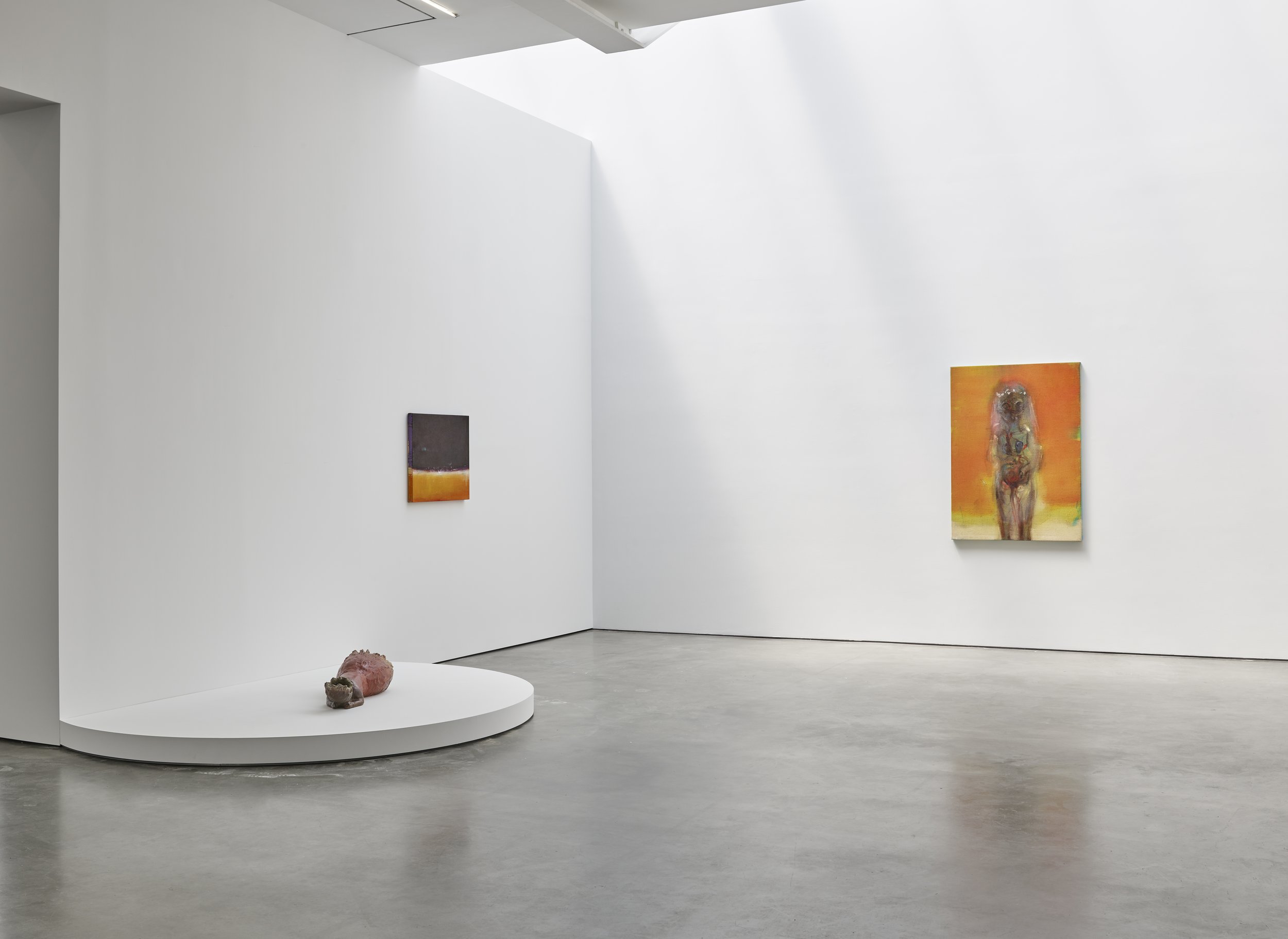


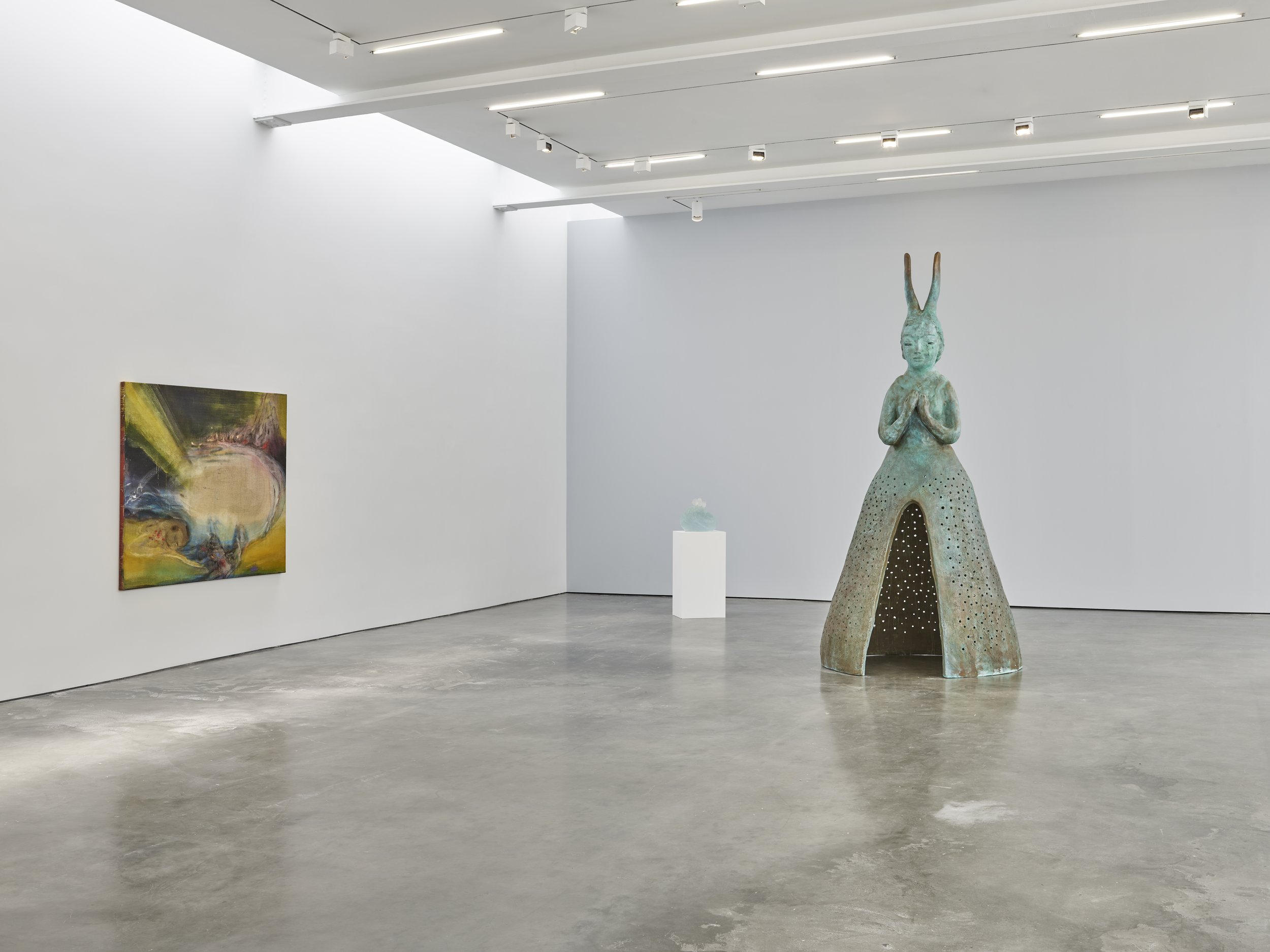
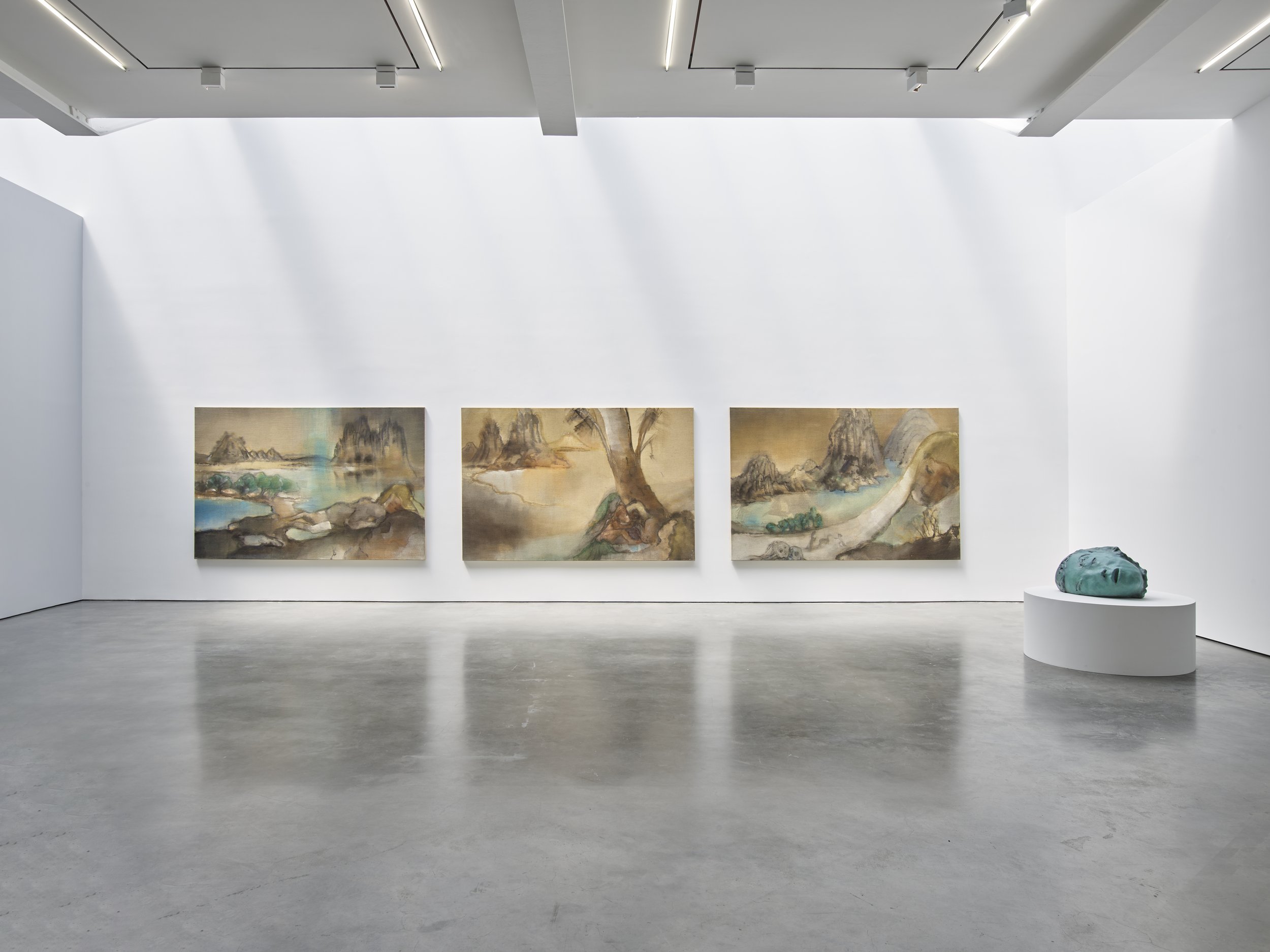
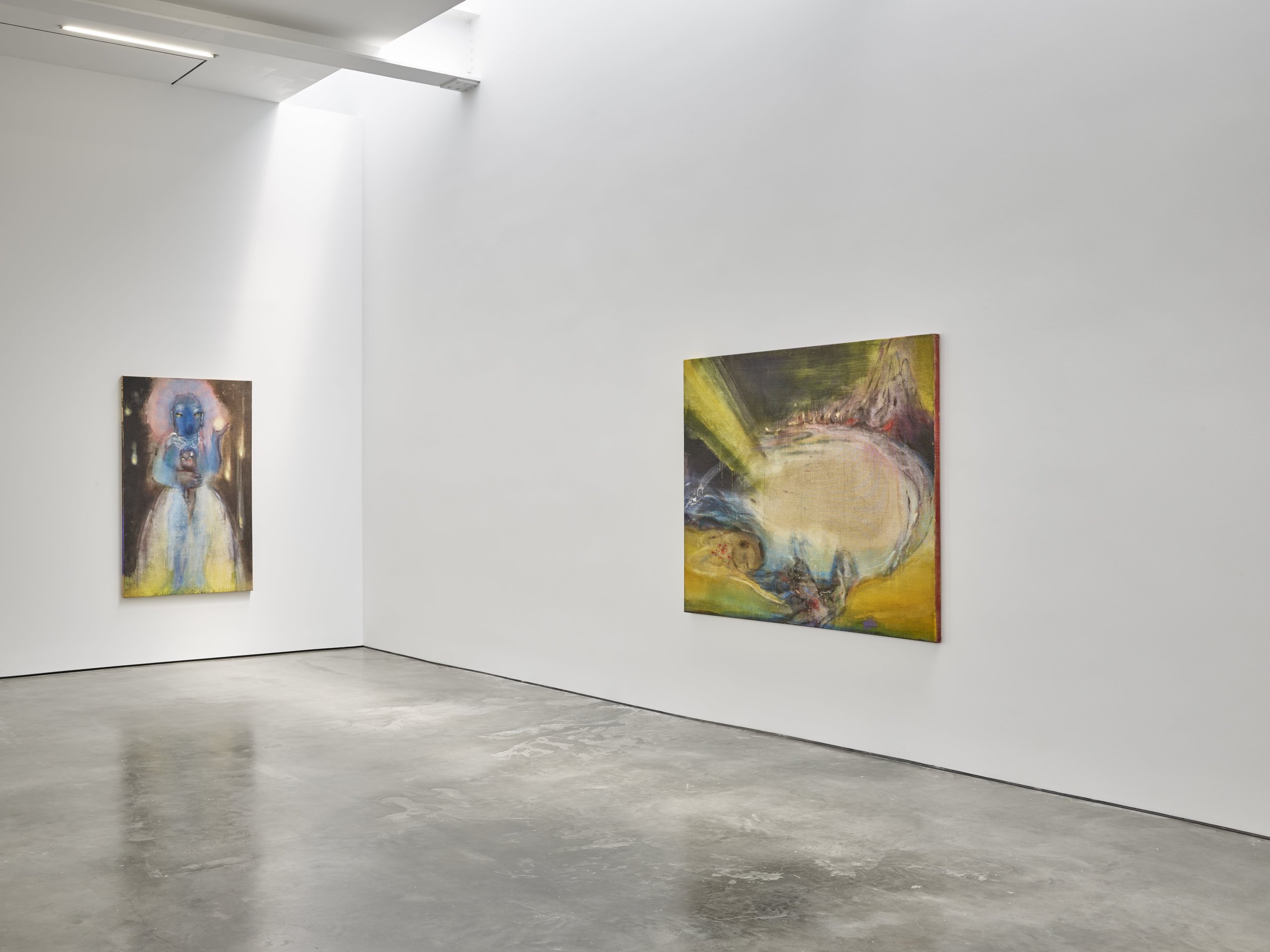
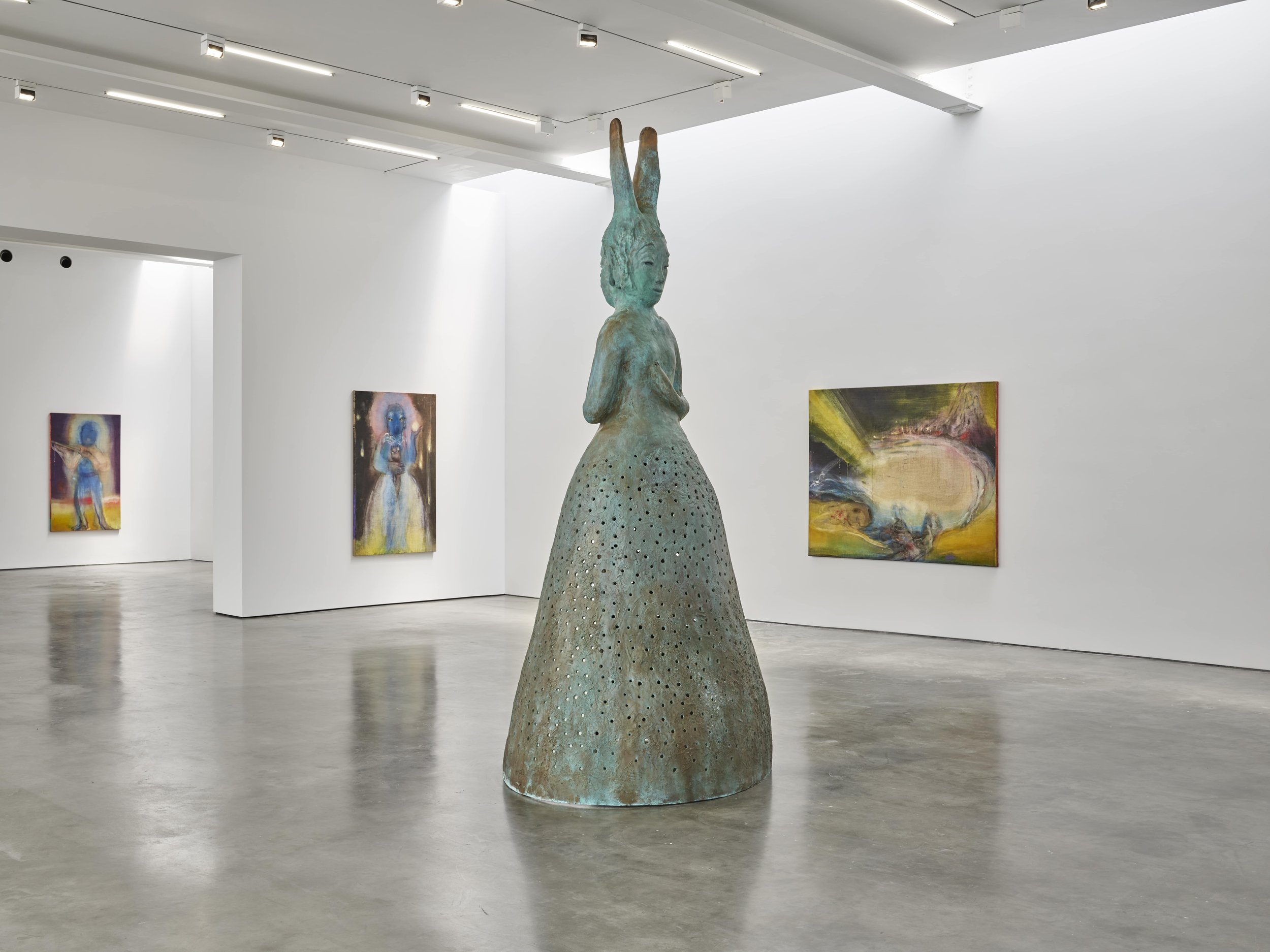
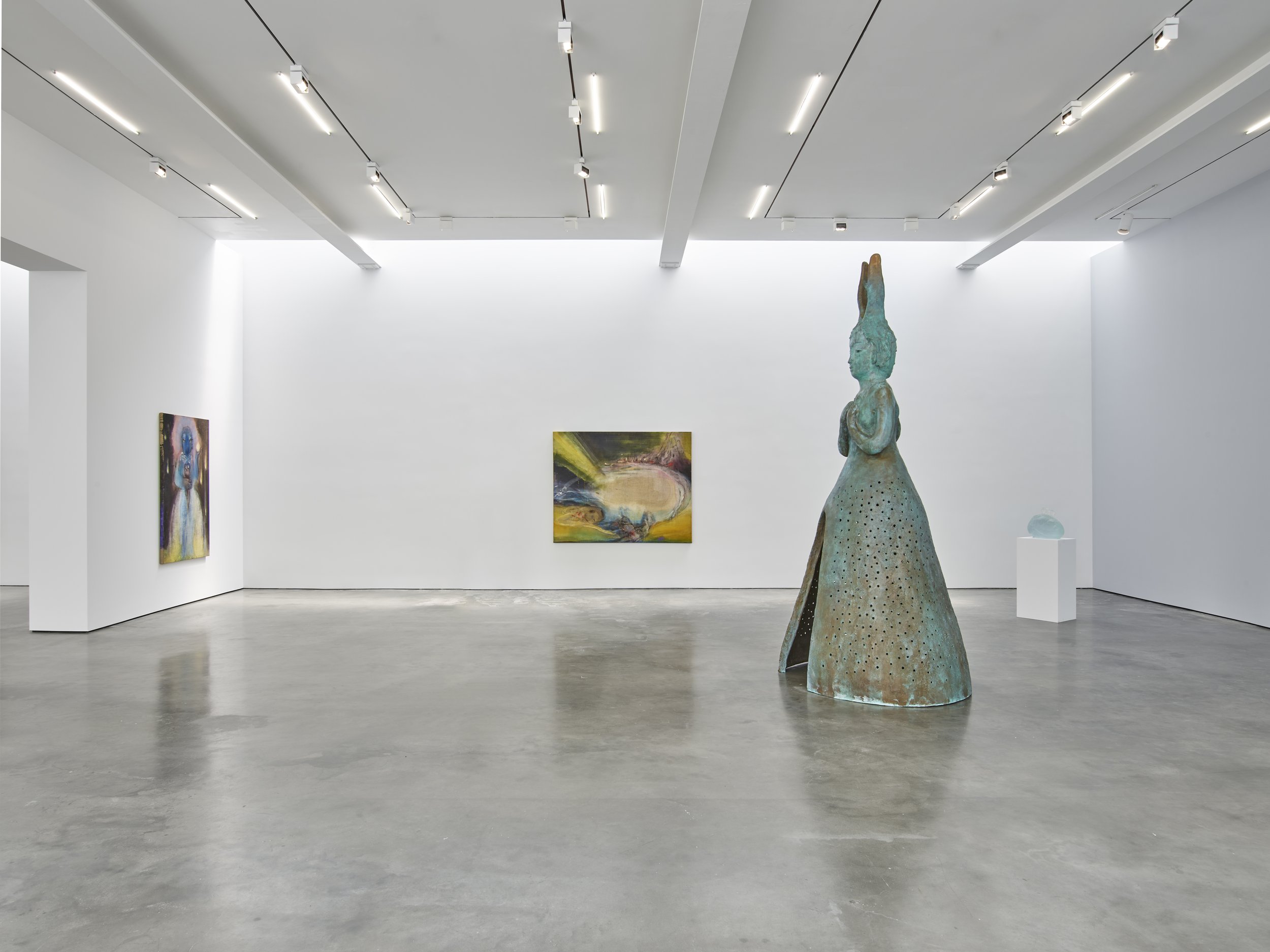
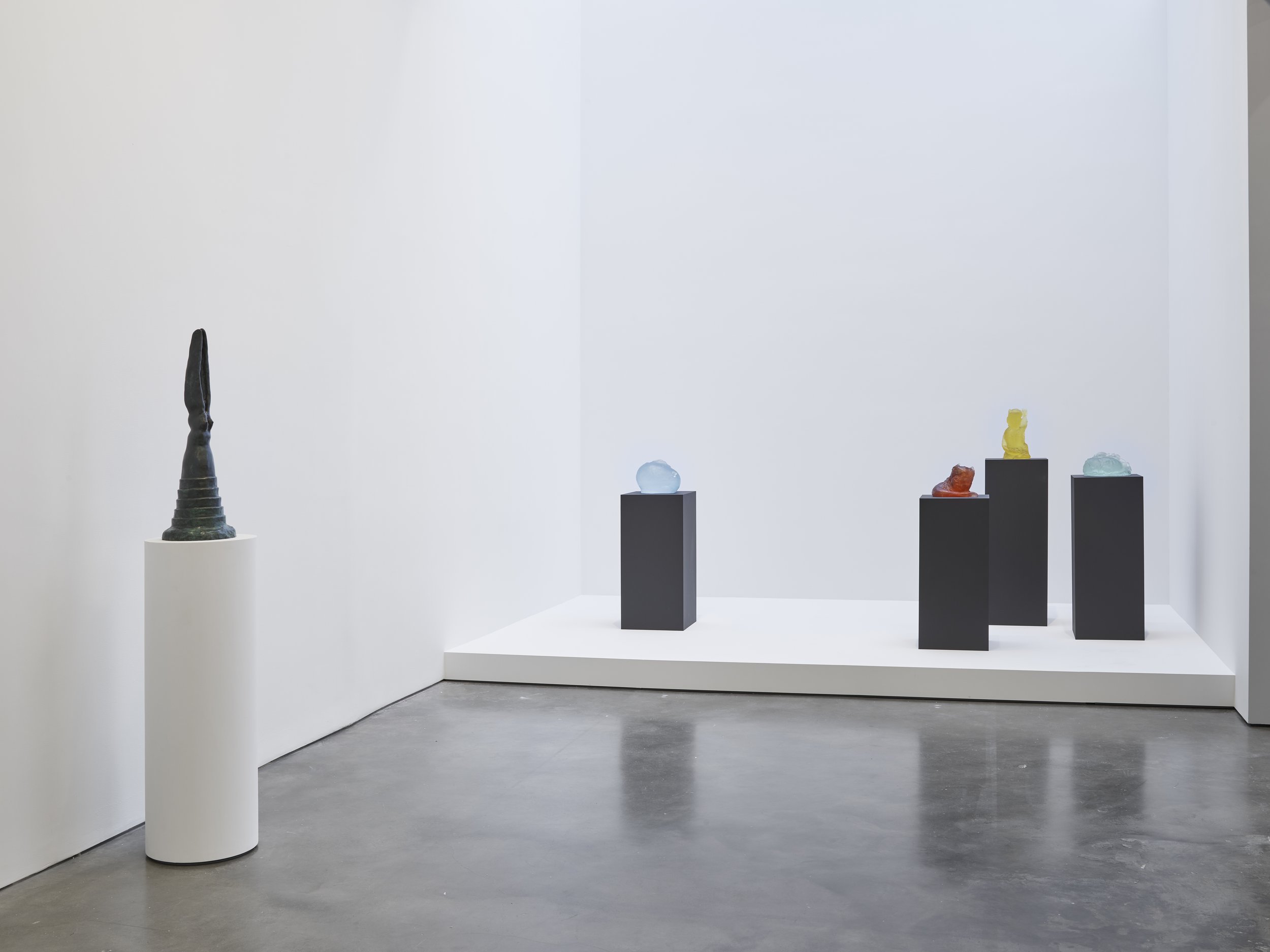
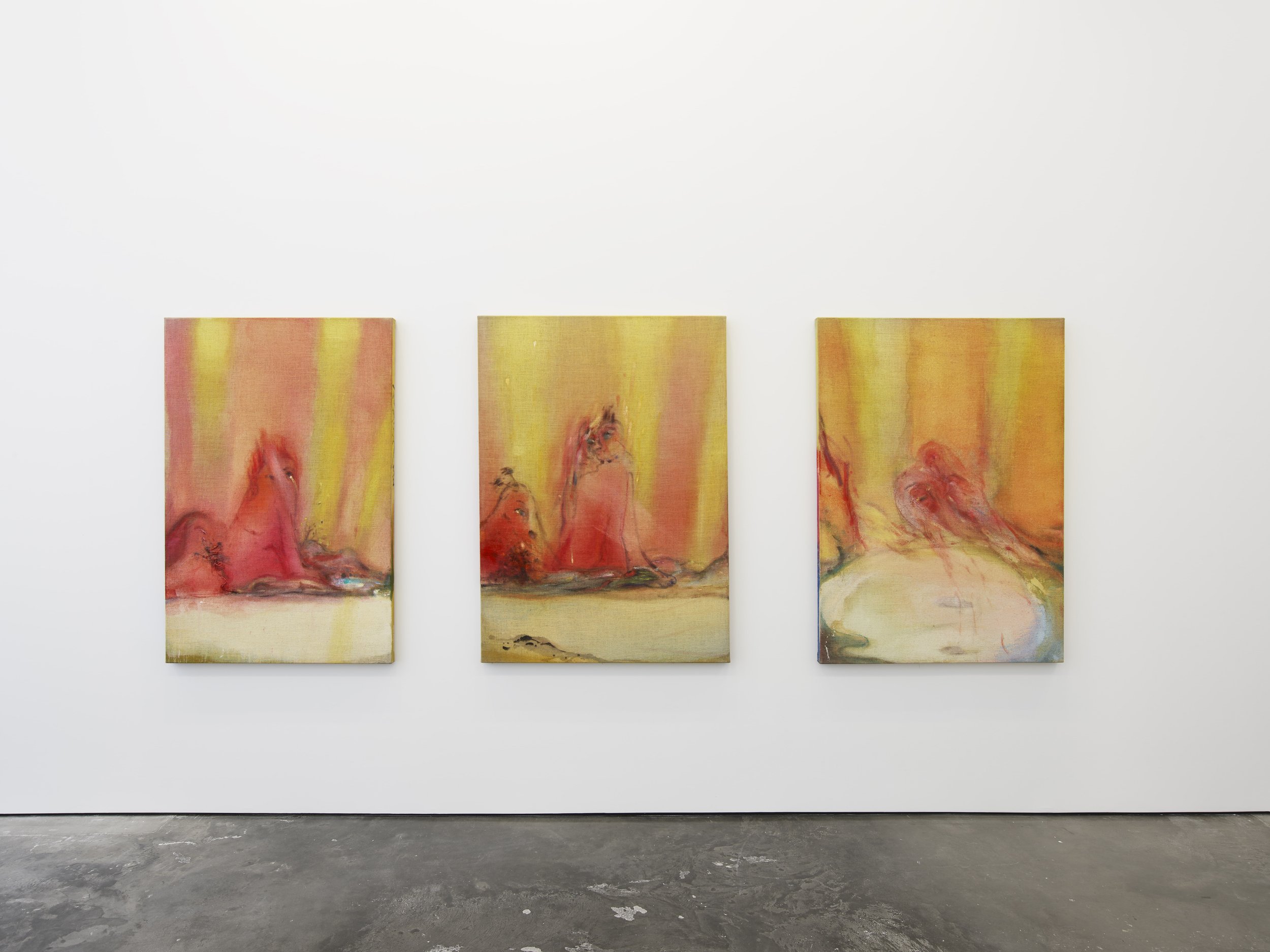
Exhibition view of ‘Leiko Ikemura: Talk to the sky, seeking light’ at Lisson Gallery, New York, 1 May – 1 August 2025 © Leiko Ikemura, Courtesy Lisson Gallery
Framing the shrine-like form of Usagi Janus is a trio of fantastical landscapes depicting a bucolic, forest scene, which might also depict the very origins of life on our planet. Among the mountainsides and wooded pastures are reclining figures or hidden faces, either fused indelibly with the land or haunting its borders through skeletal or skull-like apparitions. In one of Ikemura’s poems, entitled Transfiguration, she writes: “I’ve seen it / everything changes / people turn into rocks / into mountains / into oceans.” A figure in repose is also captured vividly in Sleeping Figure in Red (1997/2012), in which a young female is face down, with head in hands, perhaps in distress or, as the title suggests, at rest.
Ikemura’s recurring cast of young girls can be found variously recumbent, strident, floating, crying, laughing. Here a duo of Brave Girls(2022), one in pink with a cat, one in orange with a wedding veil, flank a third, Pièta in Cherry Red (2024), also cradling a cat or baby, with a pair of hypnotizing eyes blazing back at the viewer. At once powerful and confrontational, but also vulnerable and naive, Ikemura again finds a subtler path between these extremes for her fearsome adolescents, the pigments soaking through and infusing the raw jute canvas with their glowing, glowering presence. Whether as psychological portraits of moods or alternate, hybrid beings, these singular objects by Ikemura amount to an impressive act of world building and longevity.
Leiko Ikemura Cat, 2020 Cast glass 20 x 27 x 17 cm 7 7/8 x 10 5/8 x 6 3/4 in © Leiko Ikemura, Courtesy Lisson Gallery
About the artist
Since the 1980s, Leiko Ikemura has explored themes of transition, cross-culturalism, collective responsibility, and sexuality, emancipating the feminine body from its position in history and mainstream contemporary culture by challenging artistic conventions and disrupting social norms. The internationally recognized artist seamlessly shifts between luminous, otherworldly and often monumental oil paintings, introspective drawings and watercolours, glazed terracotta sculptures, glass and ceramics.
Focusing on the transient innocence of childhood, Ikemura’s female spirits are defiant and independent, yet fragile and ethereal, almost ghost-like, bestowing the spirits with a composite power to exist within multiple worlds, between dreaming and waking states. Fusing Eastern and Western art – conceiving a realm inspired by East Asian sansuiga painting traditions, old Japanese masters, surrealism, post-war abstraction, and the revival of figurative painting in the 1980s – Ikemura’s spiritual works are imbued with a raw and tender presence that highlights the intimate relationship between human, animal, plant, mineral forms, and cosmology.
Leiko Ikemura (イケムラレイコ, 池村 玲子, Ikemura Reiko) was born in Tsu, Mie Prefecture, Japan and is based in Berlin. She studied at the Osaka University of Foreign Studies from 1970–1972, followed by the Escuela Superior de Bellas Artes de Santa Isabel de Hungría, Seville, Spain from 1973–1978. In 1979, Ikemura moved to Zurich to pursue a career as an artist. In 1991, Ikemura became a professor of painting at the Universität der Künste in Berlin. Since 2014, she has held a professorship at the Joshibi University of Art and Design near Tokyo.
A major survey exhibition by Leiko Ikemura, ‘Motherscapes’, takes place at the Albertina, Vienna, Austria November 21 – February 8, 2026. She has exhibited in numerous solo exhibitions internationally, including Kunsthalle Emden, Germany (2024-25) HEREDIUM in South Korea (2024), Georg Kolbe Museum Berlin (2023), Feuerle Collection, Berlin (2023), Museum de Fundatie, Zwolle, Netherlands (2023), Museo de Arte de Zapopan, Guadalajara, Mexico (2023), Being Art Museum, Shanghai (2023), Museum für Asiatische Kunst, Berlin (2022 & 2012), Sainsbury Centre for Visual Arts, Norwich (2021), CAC La Ciutat de les Arts i les Ciències Valencia (2021), Stiftung St. Matthäus, Berlin (2020), The National Art Center, Tokyo (2019), Kunstmuseum Basel (2019 & 1987), and Nordiska Akvarellmuseet Skarhamn (2019).
About Lisson Gallery
Lisson Gallery is one of the most influential and longest-running international contemporary art galleries in the world. Today the gallery supports and promotes the work of more than 70 international artists across spaces in London, New York, Los Angeles, Shanghai and Beijing. Established in 1967 by Nicholas Logsdail, Lisson Gallery pioneered the early careers of important Minimal and Conceptual artists such as Art & Language, Carl Andre, Daniel Buren, Donald Judd, John Latham, Sol LeWitt, Richard Long and Robert Ryman among many others. It still works with many of these artists and others of that generation, from Carmen Herrera and Olga de Amaral to Hélio Oiticica and Lee Ufan. In its second decade the gallery introduced significant British sculptors to the public for the first time, including Tony Cragg, Richard Deacon, Anish Kapoor, Shirazeh Houshiary and Julian Opie. Since 2000, the gallery has gone on to represent many more leading international artists such as Marina Abramović, Ai Weiwei, John Akomfrah, Liu Xiaodong, Otobong Nkanga, Pedro Reyes, Sean Scully, Hiroshi Sugimoto and Wael Shawky. It is also responsible for raising the international profile of a younger generation of artists including Dana Awartani, Cory Arcangel, Garrett Bradley, Ryan Gander, Josh Kline, Hugh Hayden, Haroon Mirza, Laure Prouvost and Cheyney Thompson.
The exhibition opened on May 1 and will be on view until August 1, 2025, at the NYC location at 508 West 24th Street. For more information about this exhibition and others, please visit the Lisson Gallery here. The gallery can also be found on Facebook, YouTube, and Instagram.
Carmen Herrera: The Paris Years 1948 –1953
Exhibition view of ‘Carmen Herrera: The Paris Years, 1948 – 1953’ at Lisson Gallery, New York, 1 May – 1 August 2025 © Carmen Herrera, Courtesy Lisson Gallery
From 1948 to 1953, Carmen Herrera lived in Paris, immersing herself in the city’s dynamic postwar artistic community while frequently traveling to New York and Havana. This period marked a decisive shift in her practice, as she moved from biomorphic forms and fevered, gestural compositions to the rigorous geometric abstraction that would define her career for the next seven decades. A new exhibition at Lisson New York, Carmen Herrera: The Paris Years, 1948 - 1953—the most comprehensive presentation of her work from this period to-date— examines a young artist deep in experimentation, subsuming the seismic influences of many colliding midcentury art movements, in order to develop her own breakthrough language of painting.
Carmen Herrera Conquete de l'air, 1950 Acrylic on canvas 75.9 x 117.2 x 2.2 cm 29 7/8 x 46 1/8 x 7/8 in © Carmen Herrera, Courtesy Lisson Gallery
Herrera’s years in Paris were a time of creative freedom and intellectual exchange, particularly through her participation in exhibitions such as the Salon des Réalités Nouvelles, where she exhibited alongside other prominent figures such as Theo van Doesburg, Max Bill, and Piet Mondrian, as well as younger artists associated with Venezuela’s Los Disidentes, Brazil’s Concretists, and Argentina’s Grupo Madi. The city exposed her to key modernist movements such as Bauhaus and Russian Suprematism, which deeply influenced the shift toward her own uniquely minimal language. During her time in Paris, Herrera began employing shaped canvases while also becoming a pioneer in solvent-based acrylics, a material still novel in postwar Europe. Notably, an important work from this period, Iberic (1949), is currently the oldest work in the permanent collection of the Metropolitan Museum of Art to use this particular medium, a fact that was discovered through scientific analysis by the museum in 2021.
Key works on view include Way (1950), an early example of the hard-edged, dichromatic abstraction that would later become her signature. The painting’s four symmetrical ochre-colored triangles against a black background prefigure later masterpieces such as Black and White (1952) in the permanent collection of the Museum of Modern Art. Another major work from this period, Thrust (1950), exemplifies Herrera’s precision and spatial tension, featuring a striking white dart slashing across a cobalt blue ground. The work, both in its palette and bold linear composition, foreshadows Herrera’s future direction while also underscoring her approach to painting as object. This idea is further emphasized by the use of an artist-made frame, which was intended to prevent a buyer from re-framing the work. This concept evolves in subsequent pieces where she allowed her compositions to wrap about the edges, transforming them into fully three-dimensional forms.
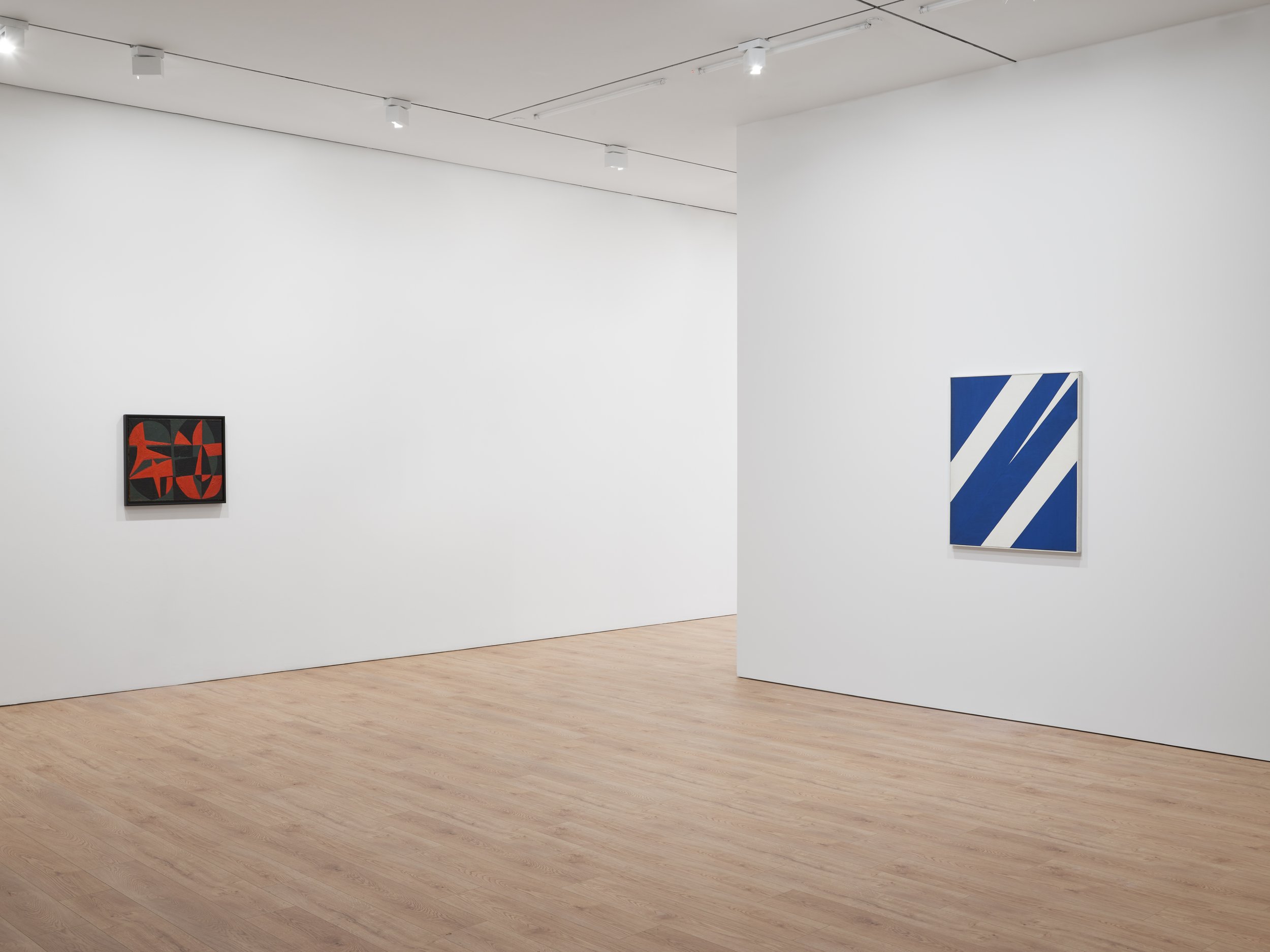
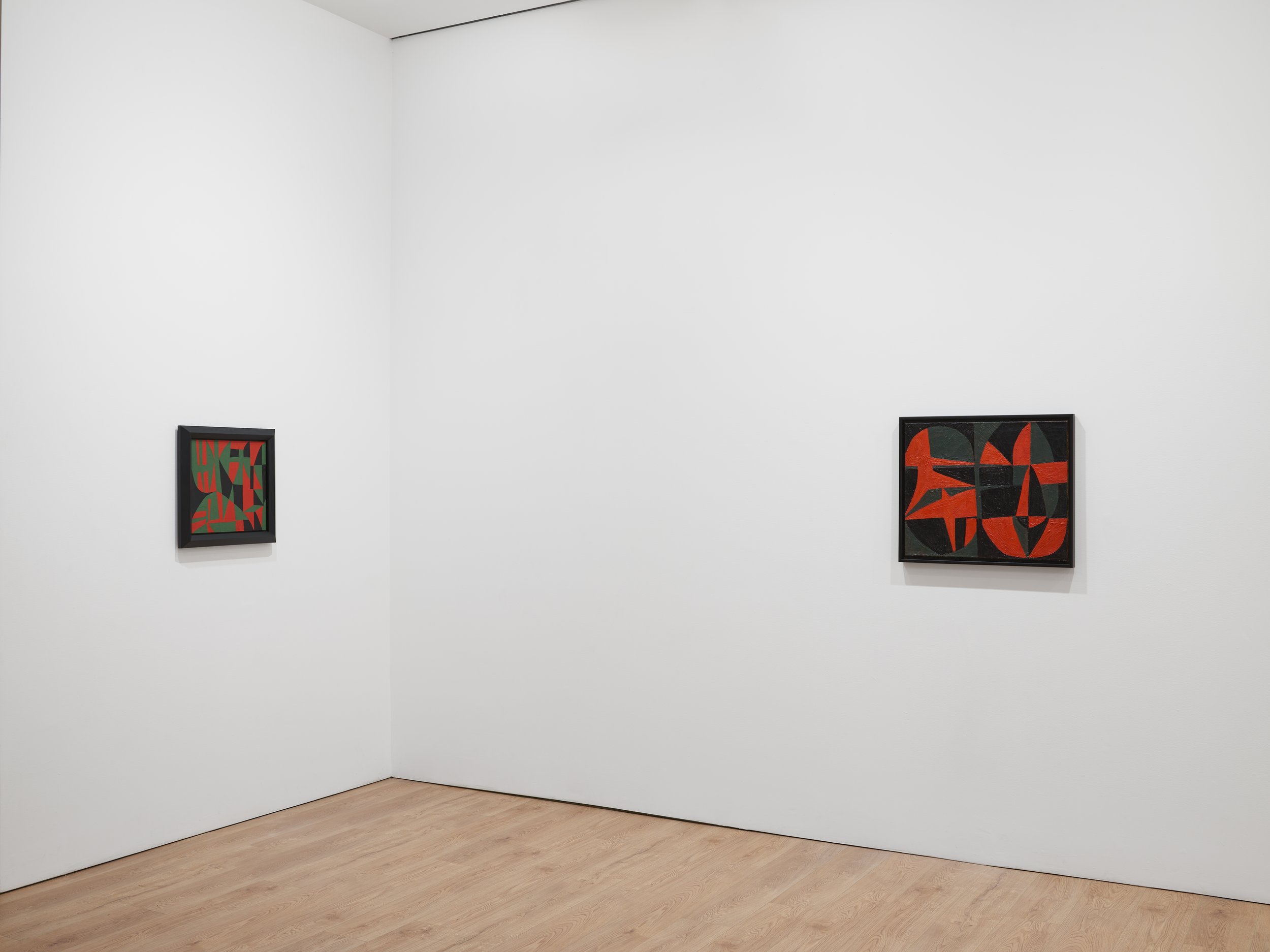
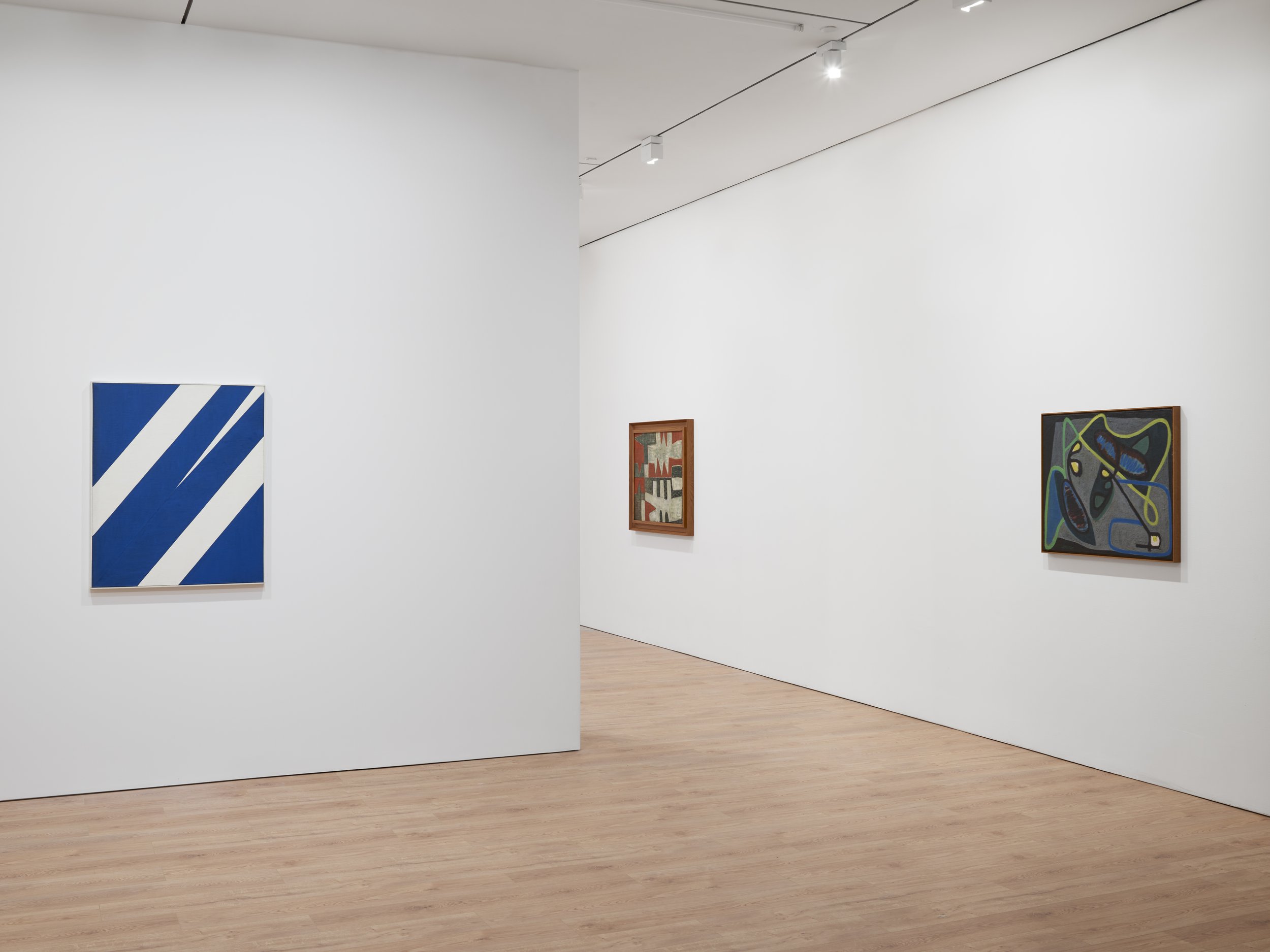
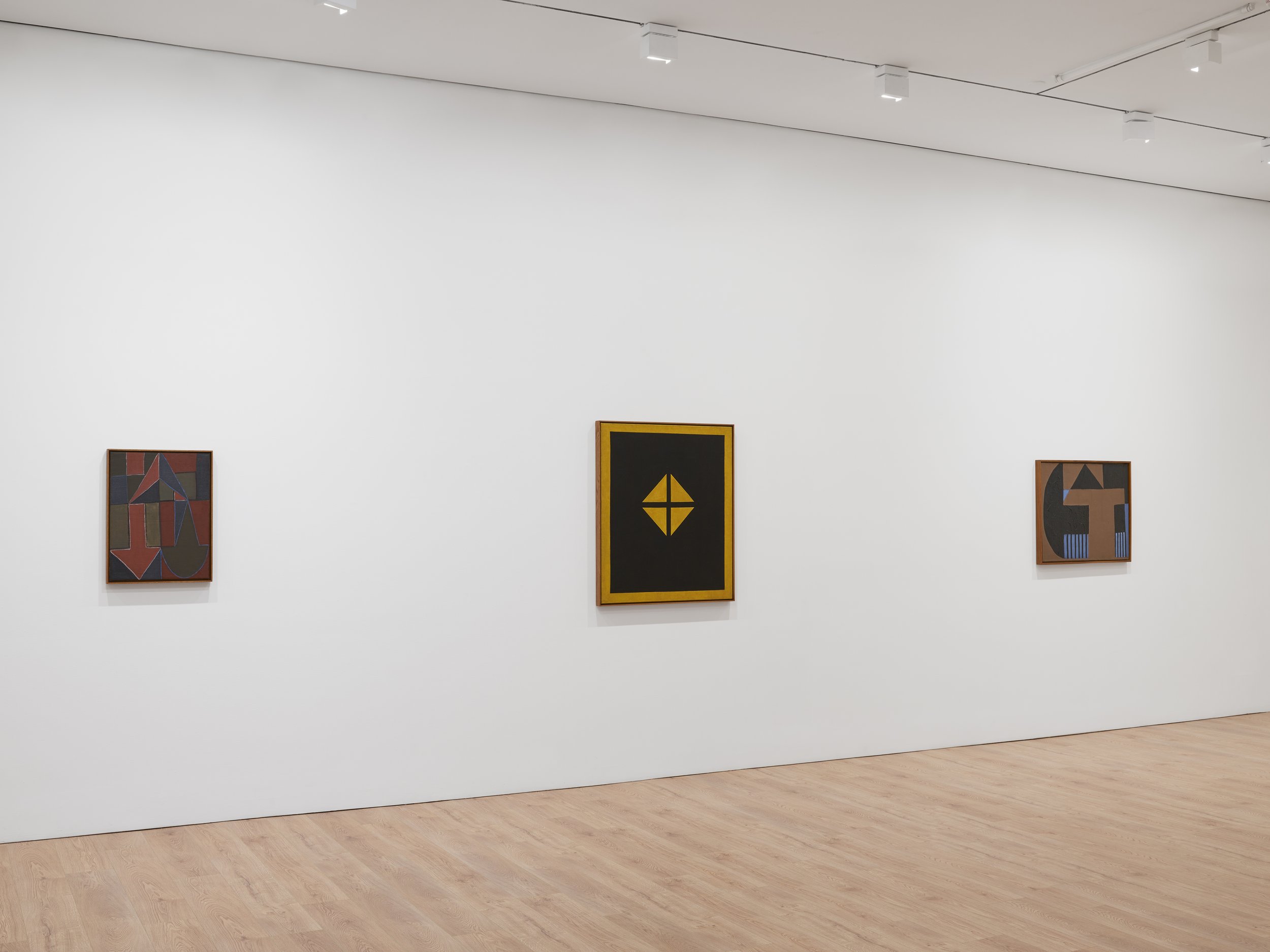

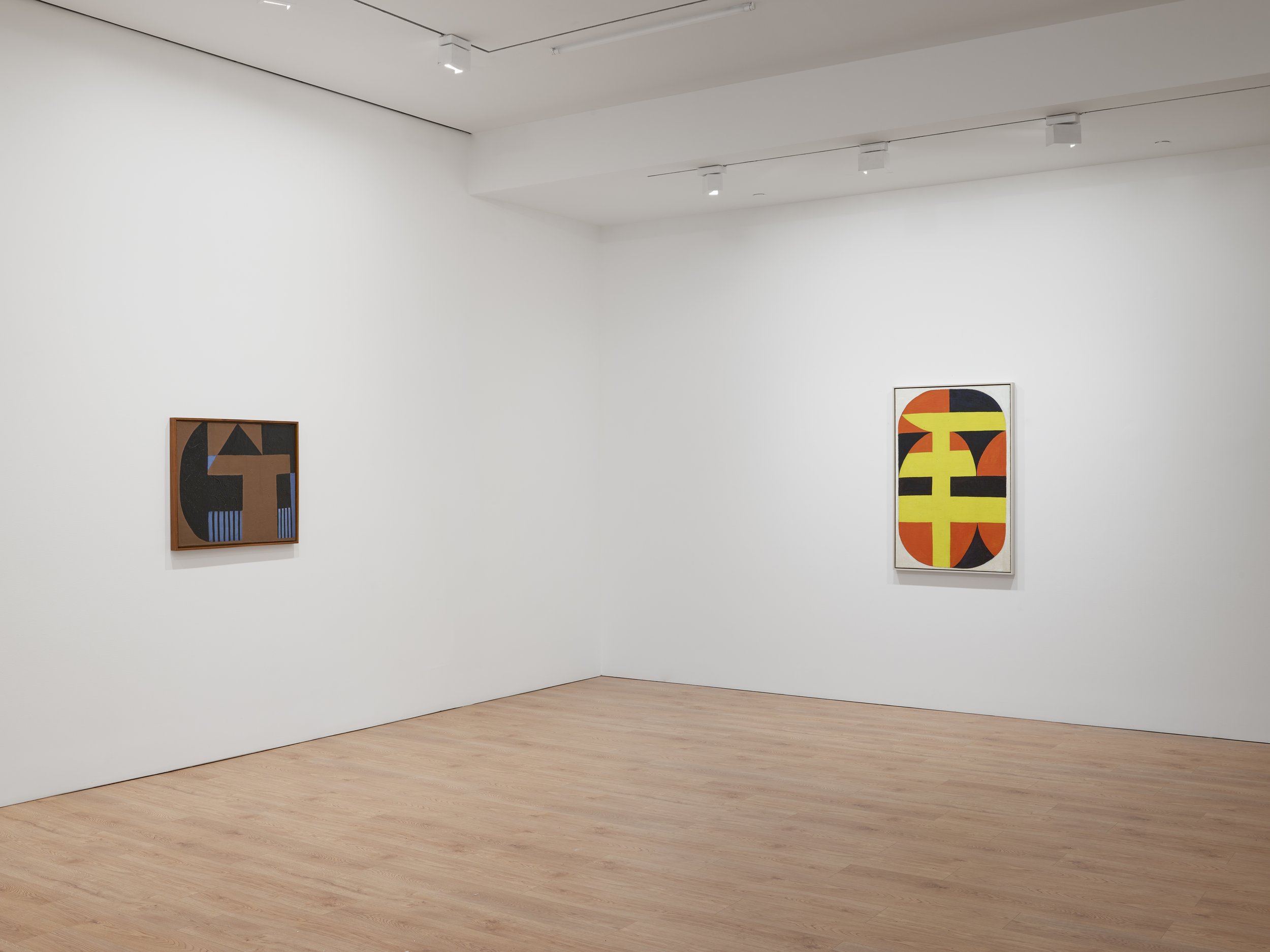
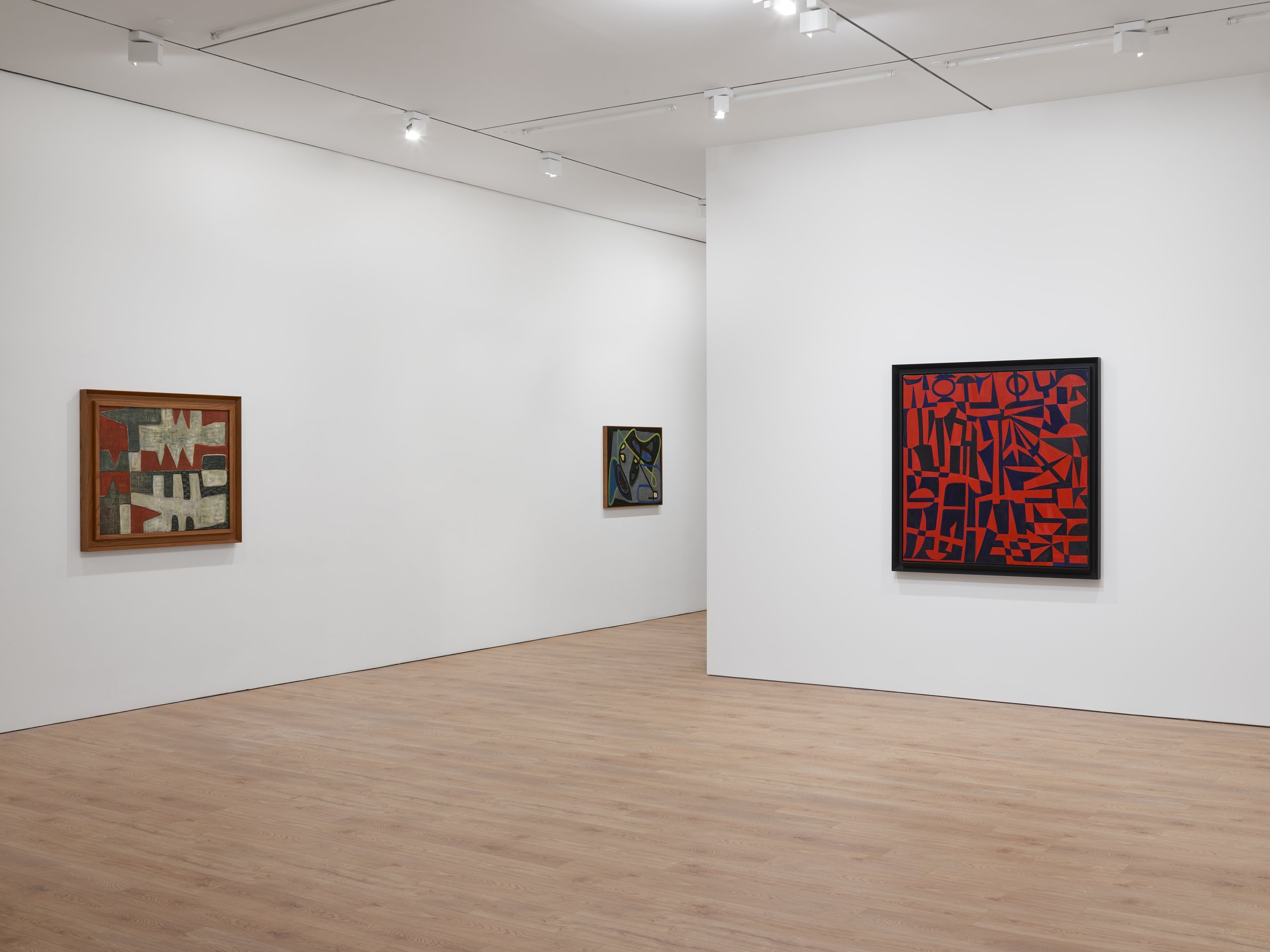

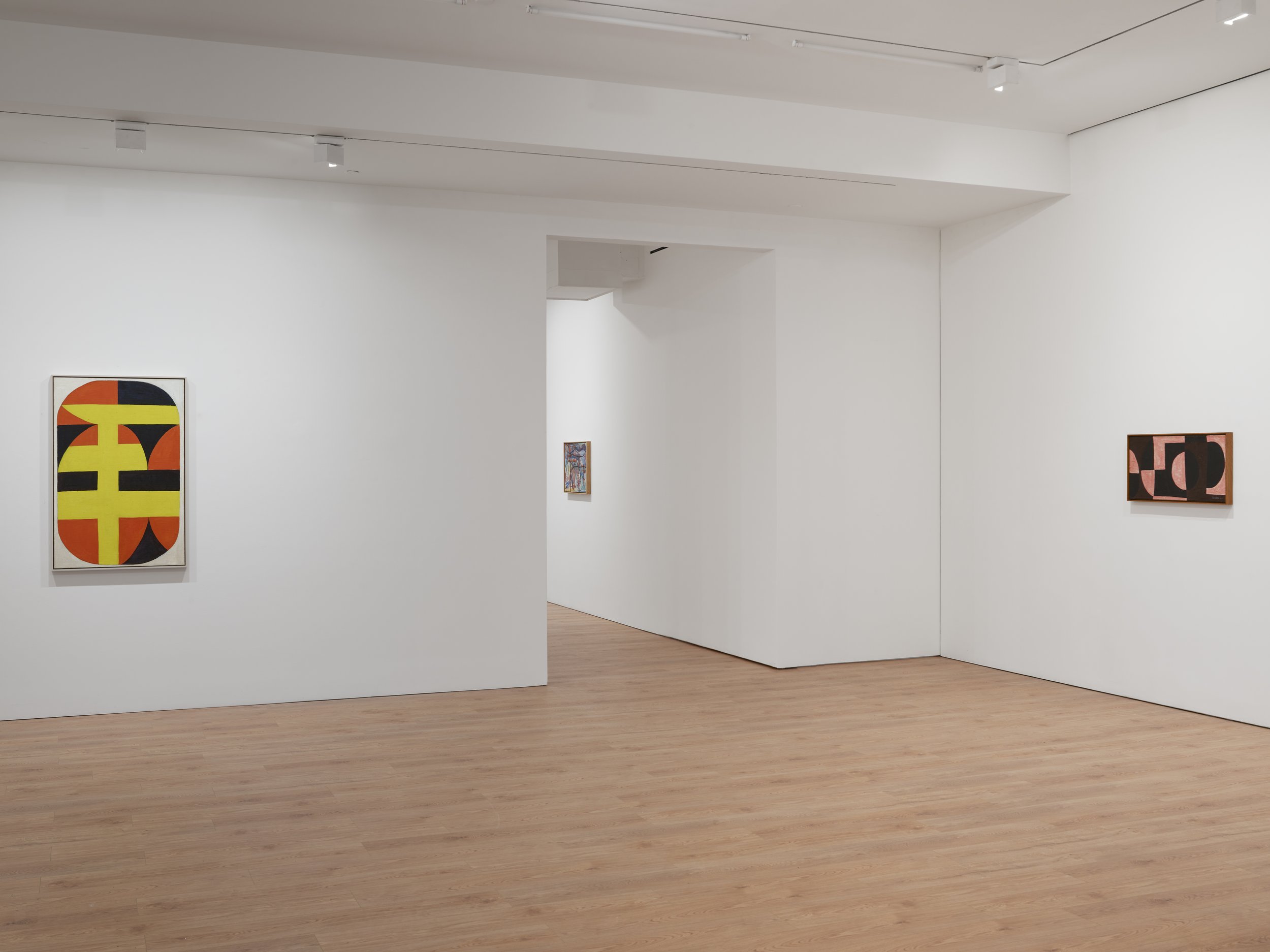
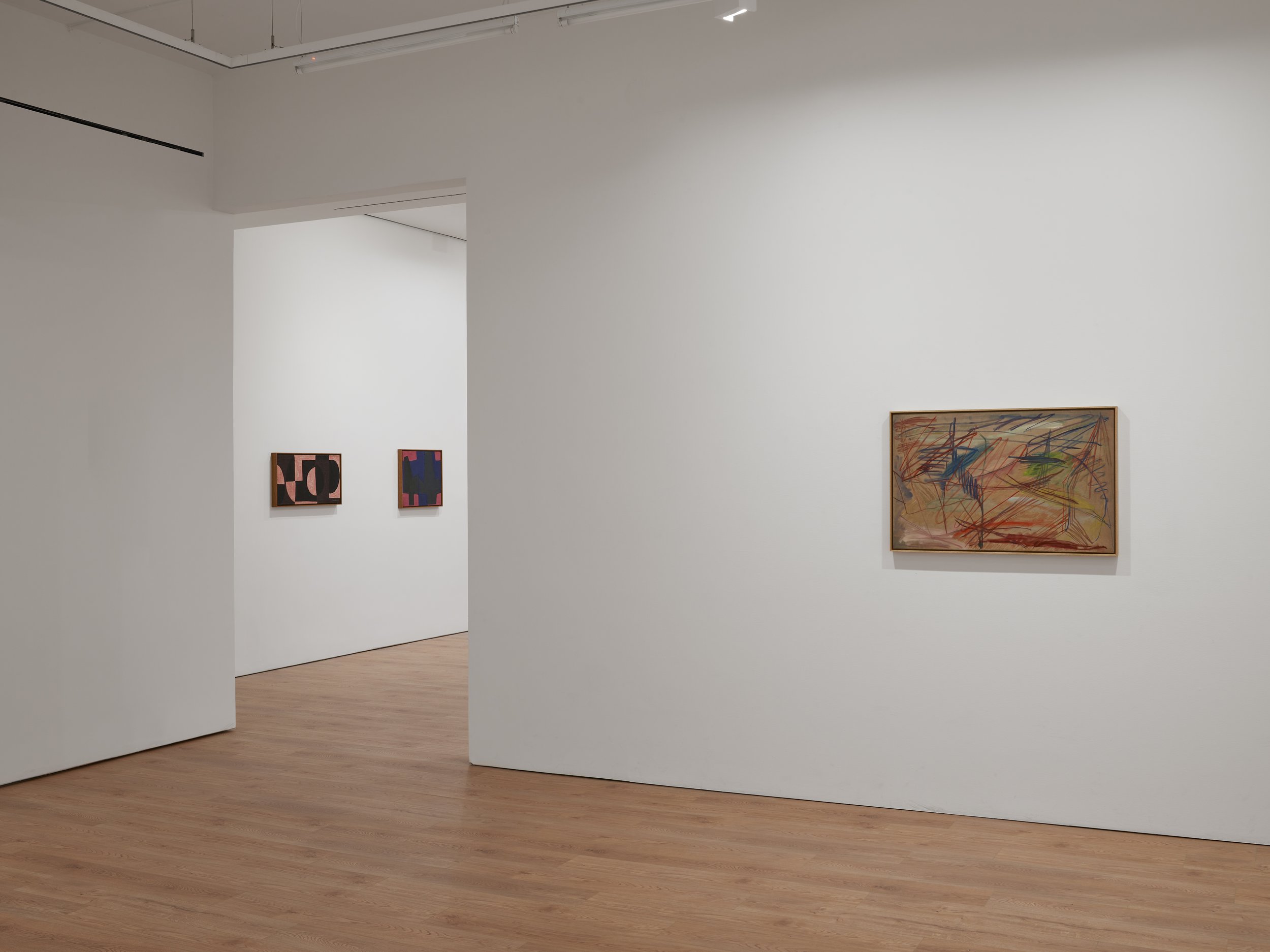
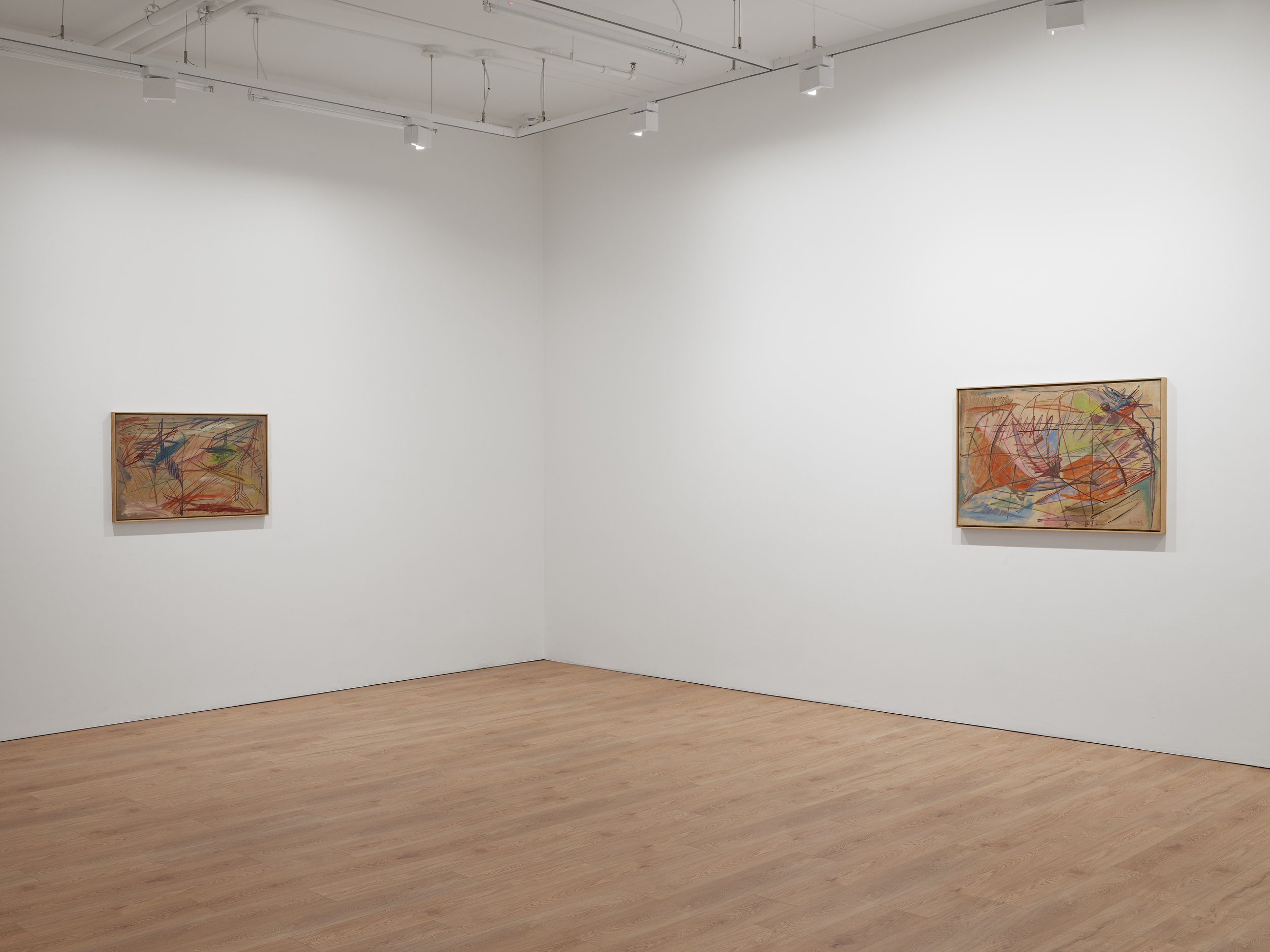
Exhibition view of ‘Carmen Herrera: The Paris Years, 1948 – 1953’ at Lisson Gallery, New York, 1 May – 1 August 2025 © Carmen Herrera, Courtesy Lisson Gallery
Herrera’s Habana Series marks a pivotal moment in the artist’s development, showcasing her experimentation with gestural abstraction and Informalism during a brief stay in New York in 1950, as argued by Roxane Ilias in her essay, “Carmen Herrera and the Paris School.” Created in response to transnational developments in Abstract Expressionism, these works contrast with the structured geometric compositions of her Paris paintings. Like others from this series, Conquete de l'air (1950) features spontaneous brushstrokes, unruly lines, amorphous forms, and vibrant colors applied without Herrera’s typical preparatory sketches. Modest in scale, the paintings emphasize a tactile graphic quality with thick, rough surfaces. Named after her first solo exhibition at Havana’s Lyceum and Lawn Tennis Club (December 1950 - January 1951), the series reflects Herrera’s synthesis of Tachisme and Expressionism, blending the gestural techniques of Hans Hartung with those of Jackson Pollock.
The exhibition also features Early Dynasty (1953), the largest painting from this period, which demonstrates Herrera’s ambition and evolving style. In this work, she layers multiple colors and geometric forms, referencing motifs from earlier paintings to create a composition in constant motion. The deep blue, mushroom-like form at the top left echoes a similar shape in other canvasses from this period including Logique Coloree No. 5 (1949) and The King in Jail, 1948 both on view in this exhibition. This tendency to revisit and refine geometric forms would become a hallmark of her later work, reinforcing her relentless pursuit of visual clarity and balance.
Carmen Herrera Way, 1950 Acrylic on Burlap 99.4 x 84.1 x 2.9 cm 39 1/8 x 33 1/8 x 1 1/8 in © Carmen Herrera, Courtesy Lisson Gallery
Herrera’s move back to New York in September 1953 presented challenges, as the art world’s gender and racial biases delayed her recognition. However, the radical developments of her Paris period laid the foundation for the rigorously precise, minimalist works that would define her later career. This exhibition builds on recent institutional recognition of Herrera’s artistic contributions during this period, including her inclusion in Women in Abstraction (Centre Pompidou, 2021–22) and Americans in Paris (Grey Art Museum, 2024). It also precedes Both Sides of the Line: Carmen Herrera and Leon Polk Smith, a major touring museum show curated by Dana Miller, who also curated Carmen Herrera: Lines of Sight at the Whitney Museum of American Art in 2016.
About the artist
Carmen Herrera was born in Havana, Cuba in 1915. She moved frequently between France and Cuba throughout the 1930s and 1940s; having started studying architecture at the Universidad de La Habana, Havana (1938–39), she trained at the Art Students League, New York (1942– 43), before exhibiting five times at the Salon des Réalités Nouvelles, Musée d’Art Moderne de la Ville de Paris, France (1949–53). She settled in New York in 1954, where she lived and worked until her death in 2022. Herrera’s work was the subject of a large-scale survey, Carmen Herrera: Lines of Sight, at the Whitney Museum of American Art, New York (2016), which travelled to the Wexner Center for the Arts, Columbus (2017) and Kunstsammlung Nordrhein-Westfalen (K20), Düsseldorf (2017–2018). Herrera premiered her Estructuras Monumentales, massive aluminium structures largely conceived in the 1960s and 1970s, at City Hall Park in New York City in 2019, organised by the Public Art Fund. Herrera’s large-scale mural, Verde, que te quiero verde (2020) was unveiled at the Blanton Museum of Art in Austin in May of 2023 as part of the museum’s grounds redesign. In March of 2024, an exhibition focusing on the last fifteen years Herrera's output opened at SITE Santa Fe, NM. Herrera's work was featured in Adriano Pedrosa's exhibition Straniere Ovunque - Foreigners Everywhere at the 60th International Art Exhibition of La Biennale di Venezia, 20 April - 24 November, 2024.
Herrera’s work is in numerous public and private collections including the National Gallery of Art, Washington DC; the Museum of Modern Art, New York; the Whitney Museum of American Art, New York; the Metropolitan Museum of Art, New York; the Tate Collection, London; Kunstsammlung Nordrhein-Westfalen (K20), Düsseldorf; the Guggenheim Abu Dhabi; El Museo del Barrio, New York; the Hirshhorn Museum, Washington DC; the Smithsonian American Art Museum, Washington DC; the Walker Art Center, Minneapolis; the Museum of Fine Arts Boston; the Pérez Art Museum, Miami; Crystal Bridges Museum of Art, Bentonville; the Cleveland Museum of Art, Cleveland; the Blanton Museum of Art, Austin; and the Morgan Library & Museum, New York.
About Lisson Gallery
Lisson Gallery is one of the most influential and longest-running international contemporary art galleries in the world. Today the gallery supports and promotes the work of more than 70 international artists across spaces in London, New York, Los Angeles, Shanghai and Beijing. Established in 1967 by Nicholas Logsdail, Lisson Gallery pioneered the early careers of important Minimal and Conceptual artists such as Art & Language, Carl Andre, Daniel Buren, Donald Judd, John Latham, Sol LeWitt, Richard Long and Robert Ryman among many others. It still works with many of these artists and others of that generation, from Carmen Herrera and Olga de Amaral to Hélio Oiticica and Lee Ufan. In its second decade the gallery introduced significant British sculptors to the public for the first time, including Tony Cragg, Richard Deacon, Anish Kapoor, Shirazeh Houshiary and Julian Opie. Since 2000, the gallery has gone on to represent many more leading international artists such as Marina Abramović, Ai Weiwei, John Akomfrah, Liu Xiaodong, Otobong Nkanga, Pedro Reyes, Sean Scully, Hiroshi Sugimoto and Wael Shawky. It is also responsible for raising the international profile of a younger generation of artists including Dana Awartani, Cory Arcangel, Garrett Bradley, Ryan Gander, Josh Kline, Hugh Hayden, Haroon Mirza, Laure Prouvost and Cheyney Thompson.
The exhibition opened on May 1 and will be on view until August 1, 2025, at the NYC location at 508 West 24th Street. The opening was held on May 1st and was held from 6 – 8 pm. For more information about this exhibition and others, please visit the Lisson Gallery here. The gallery can also be found on Facebook, YouTube, and Instagram.

